April 06, 2007
Upgrade! Brussels/Ghent

On Public Space and Sound Practices
Upgrade! Brussels/Ghent: On Public Space and Sound Practices :: We examine and discuss meshed networks in public space. Artist networks reappropriate public space by means of sound, and comment and annotate public space by soundtags. Can we speak of hybrid transmission spaces? Do these mobile modes of exchange provoke new creative practices? Project presentations by Tapio Mäkelä; Justin Bennett; Sarah Washington and Knut Aufermann. Discussion moderated by Annemie Maes and IRC chat by Dusan Barok.
Tapio Mäkelä: My first radio project was called Sound Calendar in 1994 with artist association MUU. Sound Calendar consisted of 24 sound pieces by participating artists, broadcast before morning and evening news on Finnish national radio and through intercoms at eight Finnish railway stations. My own piece in the work made me an accidental radio hacker as it caused a shut down of the entire Finnish radio network for approximately 10 minutes. My interest in hybrid uses of radio has to do with combining Internet radio with listening or participatory interfaces in public spaces.
I am currently developing “Translocal radio workshops” in two locations in the Barents Sea region. Inter-connected artist led workshops in Kirkenes (No) and Murmansk (Ru) bring together media and sound artists and community groups to develop content locally and across the border. The work is presented through public events and temporary listening environments as well as through Internet radio and temporary FM. The workshops are planned for late summer this year and Spring 2008.
In the summer of 2008 a fourth Polar Circuit workshop will take place in the Baltic Sea. Concept:Islands, among other topics, invites participants to experiment with radio and mesh-up networks and alternative energy solutions. In both of these workshops I am working on a sound archive with geo-annotation, not with an interest of GPS as such, but how the location of samples and interviews can also be a meaningful archival interface.
Justin Bennett is an artist and composer working with sound and visual media. While living in Sheffield in the 1980's he colllaborated with bands such as Hula, TAGC, and Fabricata Illuminata. Since 1989 he is based in the Netherlands. Bennett is best known for his work with field recordings, which he uses to create installations, soundwalks, CD-releases and live performances. Much of his work is concerned with urban space and the relationship of sound to place. In the last few years he worked with GEM Den Haag, the CCS, Paris, the Guangzhou Triennial, moorroom Roma, Sonic Arts Network, UK. Upcoming projects include a permanent sound work for a public space in The Hague and a text-based piece for a park in Luxembourg. He collaborates with, among others, BMB con., Renate Zentschnig, Grand Mal, 242.pilots, Kreutzerkompani.
Sarah Washington and Knut Aufermann talk about the radio lives and works that have been encountered by in their last one and a half years on the road around Europe. Working in more than a dozen countries and meeting people from all over Europe, visiting their projects, doing workshops and participating in radio conferences, festivals and live-to-air events, has give these 'radio gypsies' a unique overview of the state of experimental radio activity across Europe today. In this presentation they will also give you a taste of their own approach to radio production, and demonstrate how their ongoing enthusiasm for the medium allows them to develop singular radio events in cooperation with others.
Posted by jo at 11:39 AM | Comments (0)
March 19, 2007
Spaces Speak, Are You Listening? Experiencing Aural Architecture
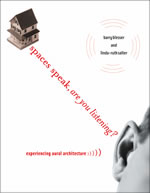
The Web Site
Barry Blesser and Linda-Ruth Salter's blog for Spaces Speak, Are You Listening? Experiencing Aural Architecture contains numerous articles, discussions, Podcast, reviews, and lecture notes on the subject. One can get a good idea about the basic issues without first having to get the book. From their introduction:
"We experience spaces not only by seeing but also by listening. We can navigate a room in the dark, and "hear" the emptiness of a house without furniture. Our experience of music in a concert hall depends on whether we sit in the front row or under the balcony. The unique acoustics of religious spaces acquire symbolic meaning. Social relationships are strongly influenced by the way that space changes sound. In Spaces Speak, Are You Listening?, Barry Blesser and Linda-Ruth Salter examine auditory spatial awareness: experiencing space by attentive listening. Every environment has an aural architecture."
Posted by jo at 07:01 AM | Comments (0)
March 12, 2007
Weathersongs at Thunderstorms 2007
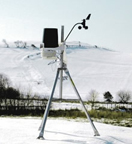
Music Changed by Weather
Weathersongs, by Richard Garrett, will be installed at Thunderstorms2007 from April 24-29. It produces continuous unending ambient music that shifts and changes with the weather and the seasons, sounding slow and languid on warm, still days and wildly chaotic in times of storm. It is a music which both reflects prevailing conditions and blends with the sounds of its environment.
The installation comprises an automatic weather station connected, via a computer, to an electronic musical instrument. The program gathers data from the weather station regarding air pressure, temperature, rainfall, humidity, wind speed and direction and uses it to compose music in near real time. Thus, when the wind blows, phrases are generated whose pitch, intensity and statistical density reflect wind speed and direction; other notes change with the rise and fall of temperature or pressure; and random percussive events occur with changes in rainfall. While this is not a one-to-one sonification, the system does respond to dynamic changes in a representative fashion.

Thunderstorms2007, is a high level cultural event with the purpose of spreading scientific culture, with special regard to climate changes, extreme weather events and related risks. It is made up of a number shows, activities, exhibitions and educational events open to everyone. All the activities have been conceived not only for weather professionals but also for the public, and in particular for young people, students, people working in the field of land management, Civil Protection volunteers and mass media. All these events will take place during six days fully dedicated to meteorology, from April 24th to 29th 2007, and will draw a crowd of visitors and participants from all over Italy.
Posted by jo at 10:23 AM | Comments (0)
March 09, 2007
X-Com: An Auditive Mapping-Project
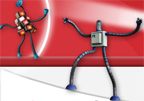
Soundscapes as Cultural Artifacts
X-Com: An Auditive Mapping-Project by MACHFELD (aka Sabine Maier & Michael Mastrototaro) :: In cooperation with: Cityvarsity and Trinity Session, Johannesburg, South Africa.
In times of global networking MACHFELD (Sabine Maier & Michael Mastrototaro) and the Trinity Session (Marcus Neustetter & Stephen Hobbs) use digital and analog devices to create an auditive communication-soundscape. This soundscape will be transformed to a crosscontinental sub-room in form of an art-radio broadcast. Supported by students of the Cityvarsity we will analyse the phenomen of inter- and transcontinental communication and we will find an answer for the question: How are soundscapes related to cultural facts?
This audio mapping will be the starting point of a Ö1 Kunstradio Broadcast which will air in autumn 2007.
MACHFELD, international Arts and Culture Society, Max Winter - Platz 21/1, A-1020 Vienna.
Posted by jo at 08:19 AM | Comments (0)
March 07, 2007
G-Turns

Satellite Scratch
After the GP4, a player that uses the earth as a disc and its portable version the G-POD, BRAND is launching a range of brand new softwares. The first one, G-BEE (Global Beeliner), allows you to create direct sonic connections between two arbitrary locations on Earth: select two places (just avoid water surfaces as they are silent), pick the duration (5, 10 or 15 minutes of a selected satellite), and order the music.
The G-ONE (Global Orbit Navigation Engine) invites you to virtually hop on a satellite and scratch across the Earth's topography, just as the needle of a record player scratches across a record. The satellites (there are more than a thousand of them) and their orbits are real and calculated in real time. You can also subscribe to a daily thirty minute podcast of satellite scratch.
It's only recently, when i met Jens Brand and his collaborator Sukandar Kartadinata, that my doubts were confirmed: Brand's g-playing works are essentially tongue-in-cheeck. If you still have any doubt about that, just try to apply for an I-God membership card gold.
This month, Jens Brand is presenting his work in Oldenburg for SOUND//BYTES, an exhibition about electronic and digital soundworlds, Berlin and Luxembourg during the Festival Musique Visuelle. [blogged by Regine on we-make-money-not-art]
Posted by jo at 08:30 AM | Comments (0)
March 05, 2007
Spatial Y
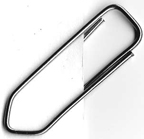
@ FYLKINGEN
Spatial Y by Michael Nielen, Ann Rosén and Sten-Olof :: FYLKINGEN :: Saturday, March 10, 2007 at 19.30 :: Münchenbryggeriet, Torkel, Knutssonsgatan 2 (T-bana Mariatorget).
The pianist Michael Nielen, the artist Ann Rosén and the composer Sten-Olof Hellström performs the sound work Spatial Y. In a meeting between chamber music, installation art and electronic chaos the spatial aspects of sound are woven together forming a sound work to which further dimensions are added by the audience movements, sounds and choices. The audience can choose to regard the work as an installation, which you can enter and walk around inside or as a concert where you sit down and listen. 120 min with individual pause.
Michael Nielen: Born 1961 in Germany. Trained pianist from the Academies of Music in Düsseldorf and Cologne. Solo and ensemble concerts in several European countries with both classical and contemporary music. Collaboration with several composers. CD and radio recordings. Since 2000 works with sound installation and live-electronic for exihibitions and concerts. From 1998 instructor at the Kunsthøjskolen in Holbæk / Denmark. Lectures on different issues of contemporary music.
Ann Rosén's work can take the shape of video, sound art, electro acoustic music, sound and video installations etc. In the early 1990s she investigated various forms of human interaction, her work focussed on creating situations where people could meet under different forms. As computer technology became more accessible Ann Rosén started to combine social interaction with digital art forms. Many of her ideas require a large number of people from different backgrounds. This has led to that she has initiated and coordinated a number of interdisciplinary projects. In 2000 Ann Rosén started to include scientists and researchers from different fields in her projects. To address the problems encountered in these projects and create a platform for interdisciplinary collaborations Ann Rosén initiated ADRA- Art Driven Research Association in 2004.
Sten-Olof Hellström has been active as a professional composer since 1984 Masters of Music in composition at University of East Anglia, England 1990 Employed as researcher and composer at the Centre for User Oriented IT Design (CID), Royal Institute of Technology (KTH) since 1997. As a researcher Hellström has mainly worked in the field of Human Computer Interaction where he has been part of several major international research projects such as eREANA and Shape. He is also very active in the field of sonification (representing data with sound). One example of current work is the construction and development of a computer interface for the visually impaired. Sten-Olofs Hellströms main occupation and profession is however as a composer working with Electro-acoustic music.
Contact and information:
0708-866459, Sten-Olof Hellström
ar[at]schhh.se
www.schhh.se
Posted by jo at 11:04 AM | Comments (0)
February 27, 2007
Sound Garden
![]()
Telematic Environment for Musical Becoming
Sound Garden: asynchronous improvisation by Norbert Herber + others :: telematic environment for musical becoming & interaction :: Web stream (using iTunes, Real Player, WinAmp, or Windows Media Player) :: Installation: Radio-TV Center (WTIU, WFIU, Department of Telecommunications) IU Bloomington campus.
Sound Garden is the second work in a series of musical installations that explore the relationship of people, location, and audio relative to technology. Listeners use the online interface to tend their sonic environment and take an active role in its composition and care. Using a web browser to select from a menu, participants can contribute their own digital audio files (musical material, voice and environmental recordings, etc.) and become gardeners that help to form the overall sonic landscape of Sound Garden.
Help cultivate the garden with your own short recordings, samples, soundscapes, and found sonic objects. Visit www.x-tet.com/soundgarden and access the web interface to "plant" MP3 files you would like to hear, or "prune" the garden and uproot files planted by others.
Posted by jo at 09:13 AM | Comments (0)
February 21, 2007
Natural Car Alarms
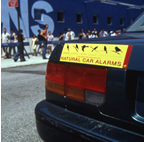
A Chaotic, jungle-y effect
Natural Car Alarms--by Nina Katchadourian--is a project consisting of three cars rigged with modified car alarms whose typical six-tone siren has been replaced with a similar one made only of bird calls. Some of the bird sounds are shockingly electronic in character; others are very bird-like in the quality of their sound, but very alarm-like in their patterning. While on an artist's residency at Caribbean Contemporary Arts in Trinidad during summer of 2001, I decided to travel to a small coastal town called Grand Riviere for a few days. This place was known for its natural beauty and wildlife, including giant leatherback turtles that came up onto the beaches there to lay their eggs during a brief window every year. Trinidad hosts an incredible variety of plant and animal life, and is particularly well known as a bird watcher's paradise.
During my time in Grand Riviere I decided to spend an afternoon hiking with a local guide who took me far up into a remote mountainous area in the rainforest. We climbed up narrow mountain paths into areas thick with vegetation that surrounded and disoriented me. It was an environment unlike any I had ever been in before. Stopping to take a breather on the way down the mountain, I suddenly heard a very familiar noise in the midst of all unfamiliar natural surroundings: a car alarm. I stood listening to it for a few moments before things snapped back into context and I realized that this sound couldn't possibly be a car alarm. It was in fact a bird.
I'm a great believer in misunderstandings as fruitful starting points for art works. Moments of confusion can be incredibly expansive mental spaces, where you hover in a kind of vastness, trying to extend this state as long as possible until some clue provides context, or some bit of information anchors you once again to what's actually going on, delineating and determining what you should be understanding about things. Most people have had the experience of sleeping in an unfamiliar place and for a moment having no idea where you are when you wake up. Standing there in the rainforest was a bit like this: I tried to stay with both interpretations of that sound for as long as I could, but I also made a mental note to remember the error for later.
In Spring 2002, SculptureCenter was finishing renovations on their new exhibition space in Long Island City and wanted to commission a work that didn't need a roof over its head. I proposed a project called Natural Car Alarms: a flock of three cars, each outfitted with a different car alarm modeled on the ubiquitous six-tone siren so common in New York City cars. Although they would behave just like the real thing, the alarms would all be composed of bird sounds.
I contacted the Macauley Library of Natural Sounds at the Cornell Lab of Ornithology. They were known for having a vast archive of animal sounds, and agreed to work with me on the project. I sent them a recording of a car alarm from a screaming car on my street one day, and they set about finding bird calls that roughly matched those sounds. A few weeks later, I had a CD in hand with 33 different birds on it and I set to work to edit the sound.
Each car had a different alarm soundtrack, and each alarm had six different birds, so there were 18 birds involved in all. The choices were tough. I wanted to find a good balance of sounds that were both shockingly alarm-like but also distinctly still bird-like in their quality. Almost as important as matching the sounds was finding a patterning that mimicked the swooping cries and punctuated honks of the familiar six-tone siren. They also needed to be as loud, intrusive, obnoxious and surprising as the real thing. Ideally, I wanted to replicate some of the ambiguity I had experienced in the forest, where the urban and the natural were suddenly very continuous. Car alarms were after all a completely natural part of the Long Island City landscape where the piece would be shown.
The piece was shown at several locations during the summer and fall: MoMA QNS, PS1, Socrates Sculpture Park, and Sculpture Center, where the flock came home to roost at SculptureCenter's opening of their new space. In each case, the cars were parked adjacent to one another and left there for the day. The alarms ran on timers, not synchronized to another in any particular way. There were moments were one car was screaming and another would seem to respond a few minutes later, and occasional moments when all three cars would go off at once — a completely chaotic, jungle-y effect.
Posted by jo at 09:45 AM | Comments (0)
February 03, 2007
Timo Kahlen
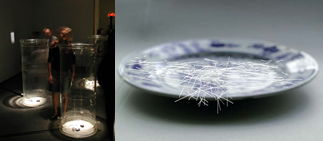
Ephemeral Media
left : "Media Dirt", 2004. Sound installation based on ephemeral, interfering radio waves at KIASMA National Museum of Contemporary Art in Helsinki, Finland // right : "UR", 2006. Net art / interactive sound piece. Courtesy Ruine der Kuenste Berlin.
Sound and media artist Timo Kahlen (*1966, living and working in Berlin) has been nominated for the German national "Sound Art Prize 2006". He has been working with immaterial and ephemeral media (light, sound, wind, radiation) for more than twenty years. As part of his nomination, he has been invited to present selected sound installations at the Ruine der Kuenste Berlin, at the Skulpturenmuseum Glaskasten Marl and at the "SoundART 2006" special exhibition of the ART COLOGNE fair. For a detailed documentation of his experimental work see http://www.staubrauschen.de/soundsc.htm
From April 27 - April 29, 2007, a new selection of web-based, generative sound works by Timo Kahlen will now be presented at "The Sonic Image": 2007 Totally Huge New Music Festival Conference in Perth (AUS). These include "Sound Drift" (2005 in collaboration with Ian Andrews) and "ping tschae tschae" (2005) and, for example, "UR" (2006).
For 2007, Timo Kahlen is currently preparing exhibitions in Berlin, Chemnitz and Milano.
Posted by jo at 02:48 PM | Comments (0)
February 01, 2007
JANET CARDIFF & GEORGE BURES MILLER
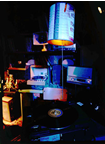
The Killing Machine and other Stories
The Killing Machine and other Stories :: JANET CARDIFF & GEORGE BURES MILLER :: Opening: Thursday, February 1, 2007, 7.30 p.m. :: Exhibition dates: from 2 February to 1 May 2007 :: Coproduced by: Museu d’Art Contemporani de Barcelona (MACBA) and Institut Mathildenhöhe Darmstadt :: Curated by: Bartomeu Marí (Chief Curator of MACBA) :: MACBA, Museu d’Art Contemporani de Barcelona, Plaça dels Angels, 1, 08001 Barcelona, Spain.
Since the early nineties Janet Cardiff (Brussels, Ontario, Canada, 1957) and George Bures Miller (Vegreville, Canada, 1960) have been working together on works in which they use sound and voice as raw material and main subject. Through techniques of edition and reproduction of binaural sound and the use of earphones and loudspeaker systems these works can be characterised as authentic sound sculptures.
These installations become temporal units of experience, in narrations that combine fictional stories and sound effects and question the visitor’s sensory experience, opposing the sense of hearing with the sense of sight. The sculptural space is therefore transformed into a phantasmagorical or hallucinatory one where apparently contradictory cultural traditions coincide at a specific place and time. The spectator is looking at works that are difficult to classify, since they propose a collage that brings together forms of high culture such as opera, art films or literature with popular culture, B-movies, rock’n’roll or radio broadcasts.
This exhibition contains a total of ten installations that weave a fabric of independent but complementary experiences. Each work imposes a time and a rhythm of its own, and like a play is linked to the imaginative capacity of each individual, which gives rise to a host of readings. This very high reading visuality brings Cardiff and Miller’s work close to literature by generating a script which can be read or interpreted according to the eye or ear of each reader-spectator. This produces stories that live side by side in time and transport the visitor to superimposed fictions: of the museum and of the works.
Among the Solo Exhibitions of Janet Cardiff and George Bures Miller in recent years are: the Lousiana Museum and the Art Gallery of Hamilton in 2006; the Hirshhorn Museum (Washington) and the Kunsthaus Bregenz, in 2005; the Vancouver Art Gallery and the Thyssen-Bornemisza Art Contemporary in 2004; the Whitechapel Art Gallery de Londres and the Museum of Modern Art of Oslo, in 2003; The National Gallery of Canada (Ottawa), the L.Augustine Gallery of New York and the Hamburger Bahnhof (Berlin) in 2002; the Canadian Pavillion in the 49 Biennale Venice, the Ps.1 Contemporary Art Center (New York), the Musée d’Art Contemporain de Montréal and the Castello di Rivoli (Torino) in
2001. [Related 1, 2]
Posted by jo at 09:01 AM | Comments (0)
SoundNetwork
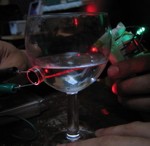
OWN [SOUND] ART Podcasting
SoundNetwork, a new network for NorthWest UK Artists using sound Present OWN [SOUND] ART Podcasting. Or art by subscription :: Launched 1st February 2007 :: Subscribe for free at www.folly.co.uk/soundnetwork
'Transmission K' by Andres Burbano, Colombia: A retrospective Sci-Fi piece - an inverse reconstruction of the crash of Soyuz 1: In 1967 the BBC in London announced the death of the crew member in this way: “ … He was an experienced cosmonaut, on his second flight, and had completed all his experiments successfully before returning to Earth. But within seconds of landing, just after he re-entered the Earth's atmosphere, the strings of the parachute intended to slow his descent apparently became tangled. The spaceship hurtled to the ground from four miles up. It is likely that Colonel Komarov was killed instantly on impact..."
Podcasting is the broadcast medium of the masses. It is possible for anyone to make and publish a podcast about anything they please and to access a global audience with the click of a mouse. Throughout February 2007 folly, in partnership with SoundNetwork, is publishing a series of specially commissioned podcasts that explore the possibilties of the medium for artists and the distribution of their work in sound. Anyone can subscribe to the series and with each download (1 every week in February) the listener will add a new piece of art to their digital collection.
This series not only explores the practical delivery of sound art on the internet, but also the very nature of communication through broadcasting; from the transmissions of a cosmonaut beyond our own atmosphere, to communicating ideas about spirituality through frequency, and through inviting sounds from our computers to occupy our environment as a backdrop to our own lives.
You can subscribe to the series by visiting www.folly.co.uk/soundnetwork
The series continues with podcasts from Gintas K (8th Feb), Neil Webb (15th Feb) and Antony Hall (22ndFeb).
http://soundnetwork.omweb.org info[at]soundnetwork.org.uk
Posted by jo at 08:57 AM | Comments (0)
January 26, 2007
Bacterial Orchestra

Evolutionary Musical Organism
Bacterial Orchestra is a self-organizing evolutionary musical organism made of audio cells. Every cell -consisting of microphone and a loudspeaker- listens to its surroundings and picks up sounds trying to play them back in sync with what it hears. It can be the background noise, people talking or sound played by other cells. Every cell is simple, but together they create a complex whole.
Every cell is born with a unique set of characteristics (its DNA) that control the way it will react to sound. If it’s not fit enough, the cell dies and is reborn with a new DNA (you can also adopt a cell, btw.) The result is a musical organism adapting to its environment, evolving with neighbouring cells and spectators and becoming musically smarter and smarter. The piece was developed by Olle Cornéer, Christian Hörgren and Martin Lübcke. I asked Olle a couple of questions about the Bacterial Orchestra:
What motivated you to make this installation?
We are really interested in systems that are self-organizing and has it's own life. You never know what would will be created in the end. The only thing you could do is to give birth to the creation. Then wait. I have been interested in sound installations for a while now, but I often think that they're more "sound" than "music". This is musical organism. It might sound a bit random, but it creates music. All sounds from the Bacterial Orchestra are played in interaction with the other cells and with sounds in the room. It's music.
Any plan to show the installation at other venues or to keep on improving it?
Yes, we have just showed it one time. First we are interested in showing it in another environment - since it will react competely different. We're also interested in making it larger. Today it's built around 16 cells, but the idea is to add a few cells every time we show it. It can easily be scaled - since the cells only are communicating through (analog) audio. We hope to one day be able to show it when it's built of hundreds of cells. That's what I call a pendemic!
The work sounds kind of "human", did you develop some sort of affection for it?
Yes, actually we did. It really didn't react the way we wanted it to, which was really interesting. For example it started to scream - from self oscillation in the room. This is not supposed to be possible, since the cells don't listen and play sounds at the same time. Feedback is impossible. And still sometimes there would be strange noises, similar to a musical feedback. At that times all the other cells picked up the uncontrolled sound and the whole installation was screaming. At points when we were in other parts of the building, me and Martin would react to the screaming sounds down in the basement, where the installation was showed. I think you could compare it to a father or mother reacting to a crying baby in the room next door. You think you hear it, but it's not there all the time... It comes from your concern.
Thanks Olle! [blogged by Regine on we-make-money-not-art]
Posted by jo at 09:30 AM | Comments (0)
January 24, 2007
Future of Sound
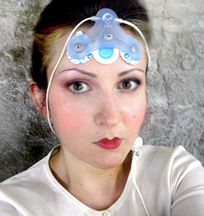
Blows the Mind
Future of Sound provides a forum for the discussion of new and convergent art forms. By creating immersive experiences using state-of-the-art sound technology Future of Sound showcases leading practitioners in the fields of music and audio design.
December 2006 sees the start of a nationwide tour by musicians and audio designers collaborating with artists and scientists, which will literally blow your mind ...
Artists at the cutting edge of sound production and manipulation will showcase their innovations and discoveries. Participants include LSD evangelist Brian Barritt, 'telephone terrorist' Robin Rimbaud aka Scanner who recently composed a new national anthem for Europe, Brian Duffy whose work with Modified Toy Orchestra creates new electronic instruments from abandoned children's toys and Paul Devereux, who discovered that Neolithic burial grounds resonate at the same frequency - a trance-inducing 111Hz chant. For the full roster of artists, go here.
Chris O'Shea be covering the upcoming on his blog Pixelsumo. Here are some of his photos from the first two events http://www.flickr.com/photos/pixelsumo/sets/72157594409570768/
http://www.flickr.com/photos/pixelsumo/sets/72157594488393569/
See Think of a Tune (Literally) and Make Beautiful Brain Music, Wired.com.
Posted by jo at 03:27 PM | Comments (0)
January 19, 2007
V2_ Institute for the Unstable Media
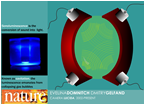
Camera Lucida: Sonochemical Observatory
V2_ Institute for the Unstable Media presents Camera Lucida: Sonochemical Observatory by Evelina Domnitch and Dmitry Gelfand :: Thursday 25 January until Saturday 3 February, 2007.
Camera Lucida is an immersive spatial art work creating a fleeting ephemeral materiality by intersecting ultrasound with hyperlight - in essence creating an unstable sonic aurora. Developed in collaboration with numerous physics research labs the 'observatory', a transparent gas-filled chamber, converts sound waves into visible light by employing a phenomenon known as sonoluminescence. Here, gaseous micro-bubbles injected within a fluid medium are blasted with ultrasound causing them to implode, at which point they become as hot as the sun and release light energy in the form of sound waves. By modulating, or 'playing' the ultrasonic transducers attached to the glass chamber an ever-changing sonochemical environment, visible only within a sheath of extreme darkness, emerges.
Belarussian/American artist duo Evelina Domnitch and Dmitry Gelfand's practice creates cross-disciplinary art works that integrates physics, chemistry and computer science with philosophical practice. With the /Camera Lucida/ they work to harness wave phenomena, both as sound and light in order to examine intrinsic questions of spatial perception and perpetuality. Having dismissed all forms of fixative and recording media, Domnitch and Gelfand's installations exist as unstable, ever-transforming phenomena offered for observation. http://www.portablepalace.com
Daily: 11:00 hrs - 18.00 hrs :: Admission: free :: V2_ Institute for the Unstable Media. Eendrachtstraat 10 3012 XL, Rotterdam :: Phone: +31 (10) 206 72 72
/Camera Lucida: Sonochemical Observatory/ will continue from 7 February until 3 March. Opening hours: Wednesday - Friday: 11:00 hrs - 17:00 hrs :: Extra opening Museumnacht, 3 March 2007 : 20:00 hrs - 02:00 hrs
Posted by jo at 10:57 AM | Comments (0)
January 16, 2007
WhisperBox
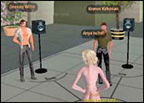
Interactive Sound Installation in Second Life
Second Life, one of the most populated MMORPG, is an important watching point to verify how the borderline between real and virtual tends to become more and more ephemeral. In the last months Second Life has seen many famous names and brands of the real world coming into its virtual spaces. The Reuters news agency has opened a virtual editorial office, IBM decided to test here its v-business (virtual business) idea. Many other events as lectures, talks (Lawrence Lessig), concerts (Suzanne Vega) has packed the SL dwellers agenda. So an interactive audio installation couldn't be missed. A certain Robbie Dingo (this is the name of the homonymous British sound designer avatar) programmed his WhisperBox (a 21st Century Folk Song).
The installation, hosted by the SL Phoenicia Center for Contemporary Art, captures words and pieces of the conversations that happens amongs the avatars inside its space (a circular space marked off by seven speakers) and translate these pieces in sounds. Tones and rhythms are directly influenced by the conversation progress. Furthermore WhisperBox provides also a visualization form of the spoken words, appearing near each avatar in a sort of 3D balloon. The displayed text then is an echo of the previous conversations. Clicking on different avatars with active balloons, their spoken words are played as music, and the previous conversations are immortalized, in a sort of inextricable and synaesthetic loop, made out of real and virtual, present and past, expression and representation." Vito Campanelli, Neural.
Posted by jo at 10:15 AM | Comments (0)
January 06, 2007
Crosstalking (XT)
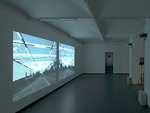
Sound Event(s)
ALIEN PRODUCTIONS & MACHFELD - "XT" Performance and Live-Webcast as part of the exhibition CROSSOVER III - photography and media art :: Thursday, Jan 11th 2007, 7 pm (CET) :: F O T O G A L E R I E W I E N, Währinger Straße 59/WUK, A - 1090 Wien.
The process of crosstalking (XT) is the point of departure for the conjoint performance of the artists' collectives alien productions (Martin Breindl, Norbert Math, Andrea Sodomka) and Machfeld (aka Sabine Maier und Michael Mastrototaro).
In telecommunication and telephony, crosstalk is often distinguishable as pieces of speech or leaking from other people's connections - hence the name. The artists will use this - normally unwanted - effect and base their performance exclusively on spoken word. They use their voice to trigger technical devices like sythesizer, vocoder, stylus printers or granular synthesis programs which themselves start to "crosstalk". The original signal will be gated out for listeners and also for the communicating artists. What remains are the sound events, processed in real time.
The performance will be webcasted live on kunstradio.at. It also will be used as material for a reworked radio-art version which will be broadcasted on ORF Oe1, Kunstradio-Radiokunst on Jan. 28th, 2007, 11.05 pm (CET).
Posted by jo at 03:41 PM | Comments (0)
January 03, 2007
Vibrö
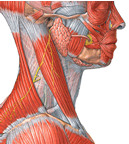
Three Sonic Objects
Vibrö was a sonic object, at the crossroads of an art multiple an a specialised magazine. Vibrö intended to render experiments in the fields of electroacoustics and Lo-Fi more 'audible'. It also tried to illustrate the growing presence of sound in the fine art practice. Published only three times in a digibox format, vibrö included an audio compilation and a series of cards that catalogue the artists and tracks.
Vibrö #1: The Inside Out Issue: A common phenonem when listening to sound art, is that our ears 'close down' and filter out the so called 'non-musical' or ' non-informative' sounds. This is why we have chosen in this first issue to expose the listener to the plurality of sonic art, just as modern art lead the viewer to rediscover his gaze. The result is Inside Out, an collection of international sound artists whose work covers a wide range of genres; from the radio art of dinahbird and the trio cutty sark, alex hamburger's concrete poetry, the generative music of Project Dark, Mika Vainio and David Toop's different approaches to experimental composition, the field recording of chris watson and cela Ètant, to Frederick Galliay's noise music and Vincent Epplay's installations and the use of sound in cinema that has inspired both Remedios Ayala + Paco Balbuena, and Loris Gréaud.
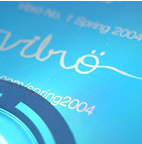
Vibrö #2: The Broken Tales Issue: Welcome to vibrö 2. While editing the new sampler, we felt there was a vital lead between the works; a lurking fragmentation of the narrative, more obvious when the tracks overtly borrow from films (Scanner, RadioMentale), refer to radio plays (Alejandra et Aeron, William Furlong) or sample travel diaries (Aki Onda, Globi) . In this instance, 'Broken Tales' also deals with the challenged formats of composition (Ryoji Ikeda, _ER__A_D_A_G_E_, Michel Guillet, Jopo Stereo) and new functions of the voice trapped by the machine (Goran Vejvoda, Serge Comte). Thank you all again for the encouraging response to our first issue (press). We are constantly seeking new material in the shape of audio files (contributions), texts and links (theory) so that vibrö continues to be a rhizomic, informative and engaging platform for sound art.
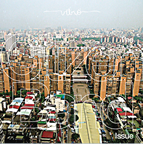
Vibrö #1: The Citizen Band Issue: A “double entendre” issue, Citizen Band, is referring to democratic endeavours, home-made radio devices and programs, also paying a tribute to small studios where sound collages, Concrète and Acousmatic musics were born, soon after world war II. Today, at the other end of the home-studio, the Internet stream is enlarging the scope of transmissions and signals. Following the inventive spirit of Pierre Schaeffer, just like Christian Zanési, the artists presented on Citizen Band, are still linked to the radio waves that have been propelling sound towards a myriad of intimate spaces. A series of works dealing with frequencies and the improper use of technology (Stephen Vitiello, Eva Sjuve, SI_COMM), reception and broadcasting tools (Tonic Train, Pete Stollery, Tereza Neuma), field recording (Zoe Irvine) or sound collages where the voice plays an essential part (Aymeric de Tapol, Joan Schuman, Mark Vernon, Alan Dunn & Jeff Young).
Posted by jo at 12:44 PM | Comments (0)
December 26, 2006
John Cage Special - part ONE
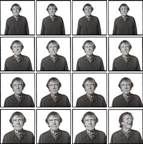
Continuous Stream of S O U N D for John Cage
John Cage Special - part ONE :: Continuous Stream of S O U N D for John Cage - non structure voyage acoustique avec armes et bagages (with bag and baggage) ... Duration 38'39
"I am trying to be unfamiliar with what I'm doing." - John Cage
voices : John Cage, Marshall McLuhan, George Koehler, Saba Tewelde (singer), Todd Weinstein, birds, cats, tv-voices, radio-voices, laughing, children voices, the composer
instruments: piano, prepared piano, percussion, cymbals, gurgle shells, timpani, trumpet, glockenspiel, bells, radio, tape collage fragments, triangle, turntable sounds (record scratch and crack), whistle, horns, toy robots, eggshells, gong, bowed gong, strings, soda bottles, double bass, bowed e-bass, dishes, church bells, acoustic feedback, subway sounds (new york city), tools, paper, machine sounds, audio tape transport sounds, electronics, cardboard tubes, software instruments (spongefork), xylophone, bowed umbrella, composer eating, composer walking, fingers, clapping, computer mouse, video cut up machine sounds, computer keyboard, trucks, cars, rain, edding writing sounds, applause, siren, ambient recordings (Frankfurt, New York, Zurich, Berlin), wind, water, echinocactus grusonii (Golden Barrel)
Poduced by musique trouve - frankfurt ... Recorded: March, April, September and November 2006 ... Copyright 2006 by Ralph Lichtensteiger [blogged on espace sonorite] [via]
Posted by jo at 10:02 AM | Comments (0)
November 21, 2006
Live Transmissions
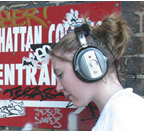
Implications of Paranoia in Sound Art
These days, a radio is a common transmitter of music and information. Historically, radios have had notorious alternative functions as instruments of surveillance. In this article, Anastasiya Osipova discusses how recent sound artists have incorporated the psychology of paranoia into their work, fitting for an environment where surveillance is constant and technology is fervently deployed to detect that which is hidden.
"Newly recruited member of the Resistance walks down the street. Anxiety circulates under his skin. Several uniformed men block his way. “What is inside your suitcase, sir?” “Radio.” They let him pass. He walks into what appears to be a shop, hands the radio transmitter to a portly woman who is standing firm on her high heels, cigarette held to her mouth. At that moment he feels that she, who he is seeing for the first time in life, is closer to him than any family member could possibly be.
Military and entertainment industries share equipment: magnetophones, vocoders, synthesizers, and other tools routinely used by musicians each originally had military functions, to say nothing of the radio, a notorious spy fetish. Leon Theremin, famous inventor of the electronic instrument bearing his name was, tellingly, also a secret agent. Together with technology, radio and sound-related arts have inherited a drive for detection often bordering on paranoia. The suspicion of invisible channels of information into which one is somehow implicated against one’s will—or of networks of communication from which one is excluded—is amplified. Recognizing the psychological power their medium can wield, radio artists are employing its technology in a manner analogous to how the armed forces would: to disclose the invisible and, when appropriate, to mobilize resistance against it." Continue reading Live Transmissions by Anastasiya Osipova, NYFA Current.
Posted by jo at 04:52 PM | Comments (0)
November 16, 2006
Light Bead Curtain
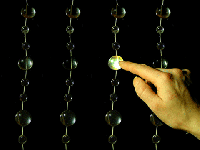
Woven Sounds
Light Bead Curtain is an interactive sound installation consisting of a curtain made of interactive beads. Each of the beads light up and emit a unique sound when touched by a user, enabling passers-by to play with the curtain by weaving their hands through it. The simple and direct interaction with the curtain makes users understand how to play. Although the primary goal of the curtain is to engage its users in play, the curtain can also function as an interactive display, as each bead can be controlled and programmed via a computer.
Light Bead Curtain is created by Ami Wolf and Jin-Yo Mok. The latter also created the SoniColumn. Via Interactive Architecture dot Org. [blogged by Lene Mailund on Digital Experience]
Posted by jo at 07:21 PM | Comments (0)
November 14, 2006
Regine Debatty's
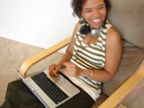
Interview with Lalya Gaye
I've been writing about Lalya Gaye's work over and over again ever since i started to blog. She's one of those few people who seem to swim effortlessly in both the artistic and the purely scientific waters.
She's an engineer and PhD graduate working in multidisciplinary projects that search to explore new territories of personal expression and creativity enabled by ubiquitous computing. Her research focuses on mobile media for urban space and on computational repurposing of everyday objects. In 2002, she started working on various research projects at Future Applications Lab, Viktoria Institute in Göteborg, Sweden. But she still manages to find some time to develop smaller new media projects with friends and to get involved in the mobile music and New Interfaces for Musical Expression (NIME) communities... More >>
Posted by jo at 09:19 AM | Comments (0)
October 31, 2006
Synthecology
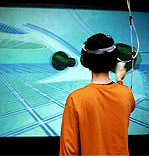
A Tele-Immersive Collaboration
Synthecology combines the possibilities of tele-immersive collaboration with a new architecture for virtual reality sound immersion to create a environment where musicians from all locations can interactively perform and create sonic environments.
Compose, sculpt, and improvise with other musicians and artists in an ephemeral garden of sonic lifeforms. Synthecology invites visitors in this digitally fertile space to create a musical sculpture of sythesized tones and sound samples provided by web inhabitants. Upon entering the garden, each participant can pluck contributed sounds from the air and plant them, wander the garden playing their own improvisation or collaborate with other participants to create/author a new composition.
As each new 'seed' is planted and grown, sculpted and played, this garden becomes both a musical instrument and a composition to be shared with the rest of the network. Every inhabitant creates, not just as an individual composer shaping their own themes, but as a collaborator in real time who is able to improvise new soundscapes in the garden by cooperating with other avatars from diverse geographical locations.
Virtual participants are fully immersed in the garden landscape through the use of passive stereoscopic technology and spatialized audio to create a networked tele-immersive environment where all inhabitants can collaborate, socialize and play. Guests from across the globe are similarly embodied as avatars through out this environment, each experiencing the audio and visual presence of the others.

Participants from the WWW use a browser interface to contribute sound elements to the garden environment for use as compositional items. All the while, this real-time composition is streamed through web broadcast of the virtual environment to illustrate the audio-visual transformation of the garden. Broadcast throughout the entirety of the festival, Synthecology will celebrate the possibilities of collaboration, improvisation, and distributed authorship that exist on the horizon of an increasingly interconnected world.
As current advances in networking become commonplace, the creation of collaborative environments connecting remote individuals will become less involved. By augmenting the possibilities for users to share sensory presence through tele-immersive interfaces, Applied Interactives intends to combine the possibilities of real-time collaboration and socialization with the dynamics of digital creation and manipulation. Synthecology is a speculative glance at how the technology of today may be utilized to create new autonomous zones for sampling & re-mixing culture.
COLLABORATORS
Synthecology is being created as a collaboration of students and faculty from the Electronic Visualization Laboratory at the University of Illinois at Chicago, The School of the Art Institute of Chicago, and Columbia College Chicago, and art(n) through the Applied Interactives organization.
ABOUT APPLIED INTERACTIVES
The purpose of Applied Interactives, NFP is to educate the art and science community about the medium of Virtual Reality as an interactive, computer-generated, immersive computer graphics environment. Applied Interactives, NFP plans to advance the medium through research and experimentation as well as provide a bridge to bring the technology out of institutional labs and into more publicly accessible arenas. Applied Interactives, NFP intends to propagate the medium by providing support and direct access to the resources necessary for artists and scientists to exhibit and develop works in the medium.
Posted by jo at 03:44 PM | Comments (0)
October 19, 2006
Net_Dérive
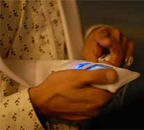
The City as Instrument
Net_Dérive, by Atau Tanaka and Petra Gemeinboeck with the collaboration of Ali Momeni, is a location sensitive mobile media art piece that calls for an exchange between participants in the gallery and participants in the streets. Deployed on advanced mobile phones, the work seeks to create a kind of musical instrument, thinking of the city-as-instrument.
Participants are given a kind of scarf with a mobile phone in each end and off they go to explore the neighborhood. One of the phones takes pictures every 20 secs and collects sounds, the other talks to the GPS (also in the scarf) and to the server inside the gallery space. On a radar they can see themselves pictured as dots but also the images they're taking. The sounds and pictures collected in the streets are sampled and mapped to a 3D city map in the gallery. As users are walking they can hear some voice instructions through a pair of headphones. Those comments suggest paths to follow or turns to make, they are generated and heard in a musical fashion. The voice instructions are inspired by the old Situationist games and theory of the Dérive - now brought into the digital and mobile spheres. As the user chooses to heed or ignore these instructions, a trace of his/her path is carved out in the city.
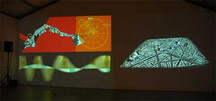
The engine then generates an audiovisual amalgam based on this information, and feeds it back as a live stream to each mobile client. The simultaneity, history, and memory of the various users’ paths and images become an abstract narrative that is summed together and projected in the gallery space. A feedback mechanism is created as users’ actions generate the collective narrative that in turn directs them.
Presented in Paris during the IntensiveScience exhibition of Sony CSL Paris, 6, 7-october 2006
Photos by Walter Kim. Images and information courtesy of Atau Tanaka.
Related: Sonic City, a wearable piece that enables people to compose music in real time by walking through the city; headphones that turn urban noise into music. Atau Tanaka's talk at Futuresonic; Pixel bondage on rice paper. [blogged by Regine on we-make-money-not-art]
Posted by jo at 08:38 AM | Comments (0)
October 16, 2006
Oppera Internettikka - Protection et Sécurité
![]()
FearingS
What is fear? Why should you be afraid? What, who is to fear? Where does your fear come from? Participate in creating a collective voice about "fear". Help reveal its actual tendencies.
FearingS is a part of the project Oppera Internettikka - Protection et Sécurité by Annie Abrahams & Igor Stromajer.
Oppera Internettikka - Protection et Sécurité explores the poetics of a contemporary sound form -- live opera as a sound event for the audience in the form of a live internet audio broadcasting. In that way it combines the notion of the world wide web communication protocols and classical artspace -- an opera house. Opera is a very strictly coded form of art with a lot of passion, and internet is a lonely place of solitude and intimate communication which is becoming more and more fragile, dangerous and suspicious.
The theme of the project is security and protection, which refers both to private and personal safety issues in the present post-WTC world of high and intense but questionable security measures and to the internet as a global and therefore extremely vulnerable and unstable communication tool.
Three artists with specific roles (artist Annie Abrahams as mutter courage, intimate mobile communication artist Igor Stromajer as bigbrother and professional opera singer as French secret service agent) are performing a complex structure combined of sounds, voices, noises, internet audio files and sound-manipulating machines and are using these sounds to perform/sing/reproduce a story for the audience present in the opera house, and for those following the audio part of the project live on the internet worldwide.
The libretto for the opera is composed out of three sources -- mutter courage is using the texts written and proposed in advance by the online visitors, bigbrother's only lyrics comes from a web search engine which he is manipulating in realtime, and the secret service agent is singing the HTML source code (Hypertext Markup Language - the authoring software language used on the internet's world wide web for creating world wide web pages) and Java scripts (JavaScript is a script language - a system of programming codes that can be embedded into the HTML of a web page to add functionality) from specifically selected French secret service web sites, openly available on the internet.
It is a new media project filled with abstract emotions, created in a valuable tradition of Bauhaus musical theater mixed with Dada, sound poetry and contemporary digital means of expression. Therefore the location of L'Opéra National de Montpellier has been selected to emphasize our efforts of introducing new artistic forms and production processes to the audience.
Project supported by The Ministry of Culture of the Republic of Slovenia, The Ministry of Culture of the Republic of France, The Municipality of Montpellier, The Council of the Languedoc-Roussillon region and Rhizome.org 2006-2007 Commissions. Co-produced by Intima Virtual Base (Slovenia), Panoplie.org & bram.org (France)
Posted by jo at 06:15 PM | Comments (0)
EAR APPEAL
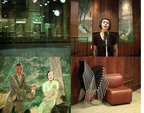
Control and the Production of Space
EAR APPEAL :: 19.10.2006 – 18.11.2006 :: Artists: Rashad Becker (DE), Justin Bennett (GB/NL), Benjamin Bergmann (DE), Elisabeth Grübl (A), Arthur Köpcke (DE/DK), Genesis P-Orridge (USA), Ultra-red (USA), Ruszka Roskalnikowa (PL), Paula Roush/msdm (PT/GB), Mika Taanila (FIN), Annette Weisser (D) :: Curator: Doreen Mende :: Kunsthalle Exnergasse, Währingerstraße 59, 2nd staircase, 1st floor, A 1090 Vienna.
"Listening to music is listening to noise, realizing that its appropriation and control is a reflection of power, that is essentially political." – Jacques Attali
Our sonic environment has a far more direct impact on daily actions than just suggestive image production. Soundscapes define economic, social, and cultural territories. In response to the question “How does sound influence our society?”, eleven artists deal in site-specific works with two issues: control and the production of space.
Ear Appeal is not a sound-art exhibition: instead, it approaches sound as conceptual and analytic material, examining the ways sound defines space and exerts control.
Every day, we are surrounded by sound waves in the city, functional music in shopping malls, elevator music, telephone please-hold-the-line loops, and the comforting tinkles in hotel lobbies, restaurants, and doctors’ waiting rooms. Audio-branding confronts us through radio and television, but also in the slam of a car door or the crunch of a cookie. We perceive noises not only with our ears: sound waves are also absorbed by the skin, nose, mouth, and bones. In the sixties, a standard slogan of Muzak Inc. was “Boring work is made less boring by boring music.” The intentional sound of muzak, a concept developed in the 1920s to describe functional tape music designed for specific target groups, is one of the best examples of how music and silence are used in the control and surveillance of consumer behavior in supermarkets, but also in factories, parks, clinics, and swimming pools. Here, the Foucauldian internalization of discipline and power is perfected on the level of hearin g.
As John Cage stated, there is no absolute silence. Sound defines space and space allows sound to be perceived. A key approach of several works in the show, some of them new, is the mapping and unraveling of sound phenomena in the political and social fabric of urban Vienna. These methods develop a direct relationship with the city, functioning as an inventory and acoustic field guide. An exhibition on the theme of sound in public and social space cannot take place solely indoors. Research, radio transmissions and on-site institutional cooperations will expand the exhibition space of the Kunsthalle Exnergasse out over the city, the source of the material being explored.
In her new work, produced in the venerable broadcast hall at Austrian Radio (ORF), Annette Weisser questions definitions of cultural identity. Based on a series of interviews in Berlin, Paris, and Vienna, Rashad Becker’s installation creates an audio feature on people’s understandings of work. The contribution of Fluxus artist Arthur Köpcke takes a BBC radio program to absurd lengths. In a text piece, Genesis P-Orridge focuses on how we can use information and strategies to fight a guerilla war against muzak. Artist and filmmaker Mika Taanila documents the phenomena of functional music. Ruszka Roskalnikowa translates familiar strategies of video surveillance to sound. Sound cannot always be escaped in the same way images can, as visitors experience in sculptural installations by Benjamin Bergmann and Elisabeth Grübl which push the relationship between sound waves, the body, and the space to extremes. As part of his ongoi ng cities project, Justin Bennett contributes a cartographic audio recording of Vienna. Urban space is analyzed by Paula Roush/msdm in terms of protest culture: including a workshop, her piece is the latest installment in her Protest Academy project. The installation by Ultra-red is the setting for a gathering where political activism and artistic praxis are discussed via the concrete question of how the concept of ‘poverty’ in Vienna can be differentiated and defined in acoustic terms.
Wednesday, October 18, 19:00 - Exhibition opening
Saturday, October 21, 12:30 - Encuentro fascilitated by Ultra-red/Manuela Bojadzijev (Berlin) and Dont Rhine (Los Angeles)
Saturday, November 11, 14:00 - Protest Academy Workshop with Paula Roush/msdm
Sunday evenings (October 29, November 5 + 12, all starting 23:05): “Ear Appeal” on Ö1 Kunstradio.
A cooperation with Ö1 Kunstradio.
Kunsthalle Exnergasse
Tuesday – Friday: 14:00 – 19:00
Saturday: 10:00 – 13:00
Contact: Christina Nägele
christina.naegele[at]wuk.at
Tel +43.1.40121-41
Währingerstraße 59
2nd staircase, 1st floor
A 1090 Vienna
Posted by jo at 09:57 AM | Comments (0)
September 25, 2006
No2Pho/notovo research project
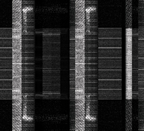
Happy New Ears (festival for New Music), Kortrijk (be)
notovo at Happy New Ears (festival for New Music), Kortrijk (be) :: The No2Pho/notovo research project: investigates the behaviour of language in its many appearances: textual, sonic and visual, as well as gestural or body language. How do these disparate elements relate to each other and how do they organize within a system which includes human and computer as a sender and a receiver [and vice versa].
The notovo-installation [article (PDF)]: as a generative sound installation NoToVo (noise to voice) plays with a connected set of elements. It is composed of dissonant synthetic voices, changing in real time from speech to sound. A physical network and a virtual network. People and voices. Wireless headphones and spatialized soundsources. People walk their traject through space. Their localisation and orientation is tracked. These data modulate the behaviour of realtime generated synthetic voices. As such, a conversation can be physically crossed and experienced according to the visitors' own position. Voices are layered and mixed by movements and trajects through space: the visitor becomes the performer.
No2Pho/notovo is developed by so-on (a collaboration between sukandar kartadinata, johannes taelman, edo paulus, billy bultheel and annemie maes). With the support of the VAF (Vlaams Audiovisueel Fonds).
http://so-on.be
http://okno.be/?id=954
http://happynewears.be
location: Happy New Ears festival, september 23rd --> oktober 8th
meetingpoint: busdascoop - kapucijnenstraat 10 - 8500 kortrijk
opening: saturday september 23rd from 2pm till 8.30pm
open: every monday, wednesday, friday and saturday from 2pm -> 8.30pm; sundays from 2pm -> 6pm
Posted by jo at 11:50 AM | Comments (0)
September 22, 2006
Freestyle SoundKit

Stickers on the Souls of your Shoes
Freestyle SoundKit was another piece i liked at the Conflux festival. It's the latest project by Jessica Thompson whom you might remember for other projects such as the Walking Machine and the Soundbike, a bike that uses motion-based generators to broadcast the sound of laughter as you pedal through the city.
Freestyle SoundKit generates and broadcasts electronic video game-like beats as you move around. You fix a yellow sticker with sensors under the sole of your shoes and each step you take is broadcast as a single beat. Each SoundKit contains a different beat to enable you to collaborate with other users to create a collaborative performance. It looked incredibly simple and the audience had a lot of fun with it. As Jessica said "Move around. Go freestyle but beware! Moves that look cool might not sound cool!" However, some testers (like the guy on the left picture) were quite good at sounding and looking cool. My images on flickr. [blogged by Regine on we-make-money-not-art]
Posted by jo at 02:20 PM | Comments (0)
September 18, 2006
Connecting Worlds

Creative Possibilities of the Networking Age
09.15-11.26.06 :: Connecting Worlds, the first exhibition after the renewal of NTT InterCommunication Center[ICC] focus on the "communication", with contributions exploring the creative possibilities that emerged out of the new environments of the networking age.
'As the first exhibition since the reopening of ICC, this show raises-from the horizons of art and programming-practical alternative possibilities of various phases of communication that we currently see around us. This exhibition features artwork and projects that take a unique step into contemporary networks, politics, economies, physiology, or urban environments by manipulating sound, games, the Internet, or other media as well as foreseeing artwork created in the past.' Yukiko Shikata, curator
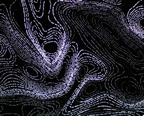
cyclone.soc by Gavin BAILY + Tom CORBY, UK 2005 :: CYCLONE.SOC brings together two contemporary phenomena: (1) severe weather, the project uses weather data that charts the emergence and progress of hurricanes; (2) the polarized nature of debate that occurs in certain online newsgroup forums. The project maps textual conversation taken from the political and religious newsgroups to the isobars of a dynamic, interactive weather visualization of hurricanes - whose complex structures are used to visualize the conversational churn and eddies of the newsgroup conversations.
In staging these interactions as a process of meteorological precipitation, newsgroup conversations "condense" in the works environment as a temporal ambient patterning - a structuring that acts not only as a metonym of difference, but of ideological tensions which mirror the dynamics of social space. CYCLONE.SOC is a navigable environment that gives the user the ability to zoom in or out and skate across and through the cyclonic weather formations in order to read or be immersed in the newsgroup text.
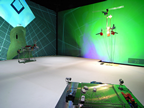
OBJECT B by exonemo, Japan 2006 :: OBJECT B 2006 Yamaguchi Center for Arts and Media (YCAM) YCAM InterLab Installation presenting a modified first-person 3-D shooting game with kinetic objects and a virtual-reality setting. Installed inside the three-dimensional environment created through projections onto all four walls of the exhibition space, are three objects made of keyboards, mice, and other computer parts and electric tools, and a control terminal for players. The robots' (programmed) frequent violent actions trigger automatic commands, according to which the game develops.
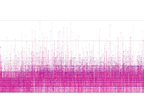
MaSS (Market as Speed Spectra) by MaSS Dev., Japan 2006 :: In e-trade, there are cases in which up to 1,000 "ticks" (contracts made when seller and buyer agree on a price are being counted per second?DThis work extracts log data of daytrade, where instantaneous decisions are being made based on numbers displayed on the computer monitor?Cand transforms the speed and rhythm of such transactions into sound and light. "MaSS" likens the steady high-speed exchange of data in e-banking to a worldwide network of reflex nerves.
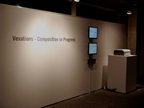
Vexations-c.i.p. (Composition in Progress) by MOHRI Yuko + MIHARA Soichiro, Japan 2005 :: "Vexations - c.i.p.(Composition in Progress)" 2006 transmediale 06, Berlin This work presents "Vexations", an odd piano piece of a single phrase repeated 840 times, originally composed by Erik Satie in the late 19th century, interpreted through an automatic, computer-controlled looping system. While incorporating modifications caused by data of environmental noises recorded with microphones at the venue, the software automatically generates new scores, based on which the piece gradually changes as the performance continues.
Artists include: ambientTV.NET (AT/IN/UK) / Wayne CLEMENTS (UK) / Robert DAVIS + Usman HAQUE (UK) / exonemo (JP) / Peter FISCHLI & David WEISS (CH) / Muntadas (UK/SP) / MaSS Dev. (JP) / MOHRI Yuko + MIHARA Soichirou (JP) / Newtype Technology Lab. (JP) / Dennis OPPENHEIM (UK) / Manuel SAIZ (UK/SP) / TANO Taiga (JP).
Posted by jo at 04:18 PM | Comments (0)
September 15, 2006
Invisible Geographies
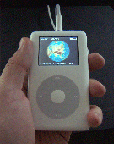
Ears to the Ground
Invisible Geographies, an exhibition organized by critic Christophe Cox, presents four works that illuminate different facets of contemporary German sound art--a scene that has been tremendously influential since the 1970s. Aside from the national focus, what is unique about Invisible Geographies, amidst a wider burgeoning of sound art practice, are the diverse, large-scale installations of which it's comprised. Encompassing sculpture, video, light, and found objects, the four works by Jens Brand, Jan-Peter E.R. Sonntag, Stefan Rummel, and Christina Kubisch push far-flung edges of sound art's formal boundaries. They are linked by their common interest in physical or social dimensions of sound, and in their deft re-mapping of urban space. Kubisch presents three related projects under the heading 'New York Electrical Walk' that variously highlight, visualize and transform electro-magnetic sound waves the artist recorded in Times Square. A rough-hewn installation by Rummel made with found building materials and retired electronic equipment re-constitutes the space of the gallery according to its resident aural elements, putting echoes from hidden storage spaces in conversation with the humming of light fixtures. Gallery-goers can expect their senses will be re-tuned after a trip to Invisible Geographies, which will be reverberating at The Kitchen, in New York, through October 14th. - Lauren Cornell, Rhizome News.
Posted by jo at 04:14 PM | Comments (0)
SENTINEL TO THE WIND
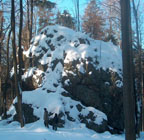
Returning the Rarified Sounds of the Wind
SENTINEL TO THE WIND by JEFF TALMAN will be installed in the Bavarian Forest this coming week and will run through September 30. The work is commissioned by the Lower Bavarian/Oberpfalz Artists Guild in cooperation with the Agriculture and Forestry Service of the Bavarian Forest in Waldmünchen, Germany as a part of their Wald – Symposium, a forest exhibition that will present the work of ten international artists.
Sentinel to the Wind is a five-channel sound installation that will cover over 12,000 square meters of forest terrain. Located atop and around the Pucher Outcropping, the installation will return the rarified sounds of the wind, which I recorded there last winter as they cut across the face of the stone. The region, on the Czech-Bavarian border was once home to sentinel towers and military complexes as part of the Iron (and NATO) Curtain. Today you can backpack through the forest and cross the border freely, which of course the wind always does. (more)
Posted by jo at 11:06 AM | Comments (0)
September 11, 2006
REMOTE

You Bring the Secret Location to Life
REMOTE--by Chris Vecchio :: 9 September – 21 October 2006* :: Gallery Joe Bird Park
3rd and Arch Streets :: Philadelphia, PA :: * viewable 24-7 * best experienced at night * (but no sound after 10PM) :: INSTRUCTIONS: 1) Get up off of the couch 2) (but bring the remote control with you) 3) Go to the south west corner of 3rd and Arch 4) Use your remote to activate the park.
REMOTE is an interactive environmental installation containing a range of sound and visual effects. Installed in an outdoor space, the installation is activated, controlled, and navigated using a common household remote control which may be supplied by the viewer. The piece takes the form of an intervention in an outdoor space, along a street or in a small park. There’s an “insider” element to the installation since, when not activated, its location may not be immediately apparent to a passerby. Additionally, the viewer needs to know to bring a remote to the location to bring the secret to life.
At the installation site, pressing buttons on any (TV, DVD, VCR, audio, etc…) remote control triggers a myriad of responses ranging from subtle (bird calls or soft sounds emanating from hidden speakers, changes in the ambient lighting) to bombastic (more dramatic sound effects, explosions, strobe lights, or projected images). Each key press generates a unique combination of effects. Viewers may bring any remote control from home to activate the installation.
Central to my work is an interest in the expressive potential of electronic devices and in the potential for user interfaces to generate new modes of interaction. A set of social precedents now exists for interaction with electrical technology. When these precedents are followed but subverted or there is no clear immediate “functional” objective, a viewer’s expectations are challenged and an opportunity for reflection or commentary on the human-technology relationship is created. This project makes use of such ambiguity – juxtaposing the familiar with the unexpected – to encourage people to question their assumptions about technology and reflect upon their interaction with it.
The piece has a strong element of accessibility. People who may be intimidated by interactive work or by technology in general may be engaged because an everyday object is the agent of action. The experience of the installation is reminiscent of a coin-op arcade shooting gallery. Play and experimentation are encouraged as part of the experience. Participants can keep trying different units from their everyday collection because each remote interacts differently with the piece. This highlights the number and variety of remotes we use for everyday tasks, from the mundane to the complex.
Sound samples in this installation have been gathered from a wide range of sources including sound effect libraries, police scanners, popular music, short wave and CB radio, and by using peer-to-peer networks to search the internet for randomly (inadvertently?) shared audio files. The broad range of sources references the instrumental use of sound samples in music as well as common (mundane) technological interactions such as channel surfing or tuning across a radio band.
Finally, the installation presents the man-technology interface ironically. The couch potato is asked to get off of the sofa and experience art first hand, but still holding the ever-present remote. Issues related to the effects of technological mediation and the degree to which technology is an atrophying rather than an empowering force are raised.
Posted by jo at 01:38 PM | Comments (0)
September 08, 2006
Night Swim
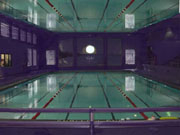
Dive into the Deep End
NIGHT SWIM is a cross between a sound and light installation, a music festival and a swimming pool party which will be held from sunset till sunrise at the Trinity Bellwoods Community Centre swimming pool in Toronto on Saturday September 30, 2006. Architect and artist Christie Pearson, co-organizer of the highly successful WADE festivals of performance art in Toronto’s public wading pools, has transformed this much loved downtown public swimming pool into a shimmering, reflective dream-space for one night only. Wire contributor Marcus Boon has invited sound artists, musicians and DJs to produce site specific works and sets in a sound environment designed by sound designer Darren Copeland, which will include underwater microphones and speakers. The event is free and open all night – visitors can swim (bring your bathing suit, towels provided!), lounge in the kiddies’ pool, or hang out in the bleachers and around the pool, soaking up the sound and light. 120 people in the pool at a time maximum – first come, first served!
Sounds: Montreal dirty beats by Ghislain Poirier and colossal drone-scapes by Tim Hecker; loops by Beijing-based creators of the Buddha Machine FM3; heavy ambient sounds by Boston-based Keith Fullerton Whitman a.k.a Hravatski; turntablist-composer Marina Rosenfeld and experimental tribal rhythmist Raz Mesinai from New York; from Toronto, electronic composer and improvisor Sarah Peebles, Sandro Perri/Polmo Polpo’s indie funk, sexy nocturnal grooves with Luis Jacob, baile funk, grime and dancehall from Geoff Snack, a.k.a. DJ Showcase Showdown, and ecstatic sustained tones by Orixasound.
Night Swim
Trinity Bellwoods Community Center swimming pool
Queen West at Crawford,
Toronto
7 p.m. to 7 a.m.
September 30th 2006
Posted by jo at 03:08 PM | Comments (0)
September 06, 2006
Tank-FX

Add Sound, Mix 'n Play
The annoying thing about ars electronica is that even if you spend 5 days there, you'll always discover that you've missed several projects once you're in the plane on your way back. In the case of Tank-FX, honorary mention in the net vision category, it's ok cuz the work is online.
The project processes a sound file submitted by the user through an unused tank of 11 x 7 of reinforced concrete built in 1032 at the central station in Obenhauser (Germany.) By installing a linux server, some audio software, microphones and speakers right inside the tank, Tank-FX allows you to upload up to 60 seconds of audio material. It is played immediately in the water tank. The surface of the tank causes a particular reverberation which is picked up by the stereo mics. The reverberated version is recorded and mixed with the original one at a radio set that you can set in advance. The outcome is then converted in the desired output format for you to download and use.
The website is in german but there's an how to in english at FieldMuzik. There's some samples here. A work by German artists Sandro Catallo and Markus Cremers. [blogged by Regine on we-make-money-not-art]
Posted by jo at 07:34 PM | Comments (0)
Silent Sound

Exploration of the Mind's Receptiveness to Suggestion
Silent Sound in Liverpool, U.K. :: PERFORMANCE: THURSDAY 14TH SEPTEMBER :: EXHIBITION: 15TH SEPTEMBER - 26TH NOVEMBER :: Artists Iain Forsyth & Jane Pollard invite you to a uniquely immersive experience which explores the mind's susceptibility to subliminal suggestion.
In 1865 Victorian performers The Davenport Brothers presented a public séance from inside their spirit cabinet on the stage of the Small Concert Hall in St. George's Hall, Liverpool. Unused for over twenty years the Hall will reopen for Silent Sound where the artists will perform on the same stage used by The Davenports. The evening will be introduced by Doctor of Parapsychology Ciarn O'Keeffe and will debut a specially commissioned original score written and performed by Jason Pierce of the band Spiritualized.
The performance takes place during the Liverpool Biennial on Thursday 14th September 2006. For more information regarding obtaining tickets for the performance please email: tickets[at]silentsound.info.
From Friday 15th September Silent Sound will feature in the inaugural programme at Greenland Street, A Foundation's major new contemporary art space - three former industrial buildings in the heart of Liverpool's Baltic Triangle which have been transformed into one of the largest and most challenging exhibition spaces for contemporary art in the country.
An ambisonic audio recording of the live performance created in collaboration with Arup Acoustics will be incorporated into a large-scale immersive installation specifically created by the artists to continue the event's exploration of the mind's potential receptiveness to suggestion. The recording will be reproduced in the installation to three-dimensionally reproduce the sound as it was actually heard in St. George's Hall.
A limited edition signed and numbered Compact Disc recording will be available from Monday 18th September, with a DVD documentary to follow in 2007. All graphic design for the project has been executed by Chris Bigg and Vaughan Oliver at v23.
More information: http://www.silentsound.info
Posted by jo at 07:56 AM | Comments (0)
September 05, 2006
Spur McGuffin: 069recorded
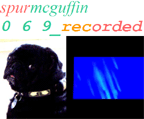
Call for Submissions
069recorded welcomes submissions for its inaugural issue on the theme of Disruptive 069recording series. We seek examples of new thinking and practice that overturn and/or reassess existing performance technology praxis. Submissions may be presented as papers, reviews, audio, visuals (stills / video) and code. Authors may use multiple formats in a single submission. mailto: spur[at] various-euro.com
SPUR MCGUFFIN is http://069recorded.de/ Consisting of major internet-based sound installations and a program of commissioned works for distinct sound stations in the web, Spur McGuffin explores the real and imagined remnants of human presence in autopoiesis. Spur McGuffin was one of the first artist-groups worldwide to use the possibilities of interactive media and especially of the internet in their work. Performances and lectures in art galleries, universities and museums are equally important as performances at media festivals and in the clubscene.
069recorded is a communication laboratory that works on political language. To do so 069recorded have use, also the hacking way, destructuring words and languages, mixing and matching situations and concept and practices; for reinventing the political language and for being more incisive on a vast level of communication. 069recorded was the first recorder managed by women in Germany (in an independent social center in Frankfurt), but it is also a hyper-place scattered with links, a circuit with which to inract that brings to other circuits. A place where sexuality is central cause, it is the zero degree of connection's desire. In the gender, beyond the gender. The 069recorded women use a collective name: "069recorded". Expressing the desire to shut down with the need of auto -- agency.
Posted by jo at 08:53 AM | Comments (0)
September 04, 2006
VIBRA: AUDIO LIMA EXPERIMENTAL
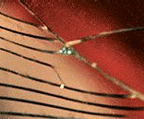
First Contemporary Sound Art Festival in Peru
First-time ever contemporary sound art festival in Peru: VIBRA: AUDIO LIMA EXPERIMENTAL :: The festival will comprise exhibits, concerts, lectures and workshops, to be held from August to November 2006. The festival's main goal is for Lima to become an audio and sound documentation experiences centre that spreads out and links together diverse ways in which we listen to our surrounding world. The festival's activities will focus around the importance of sound in our lives and in artistic creation. Renowned art critic Jorge Villacorta curates the festival and its activities.
Centro Fundación Telefónica and Alta Tecnología Andina presents VIBRA: Audio Lima Experimental festival, the first major event dedicated to contemporary sound art ever organized in Lima. It will comprise exhibits, concerts, lectures and workshops, to be hold from August to November 2006. Art critic Jorge Villacorta curates the festival and its activities.
VIBRA: Audio Lima Experimental will turn Lima into an audio and sound documentation experiences centre that spreads out and links together diverse ways to listen to our surrounding world. The festival¹s activities will focus around the importance sound has in our lives and in artistic creation, and will reinforce the concepts of art, science and the new technologies.
Starting in 1990, sound art has transformed visual arts with a new aesthetic that fuses sensory experiences, thinking, action and creation of scenarios that involve movement and space. Therefore, it was indispensable that a festival of such prominence and innovative proposals was organized for the first time ever in our country.
Furthermore, VIBRA: Audio Lima Experimental will also develop activities within the educational field, with a program that focuses on sound perception, interaction and creation. The program¹s goal is for children and school students to have a first approach towards current art trends and the new media. Children will be able to play and interact with the pieces and objects on exhibit at Centro Fundación Telefónica, and will learn about the diverse manifestations of sound that occur in their surroundings. This educational project is part of the "Arte para aprender" (Art for Learning) program, executed by Fundación Telefónica in association with Museo de Arte de Lima.
The festival will also showcase innovative experimental proposals ‹national and foreign‹ that incorporate digital technologies and link together sound and video in actions, interventions and installations. It will also encourage participative sound scenarios that include group listening experiences. All these proposal focus around sound as a source of inspiration and creative exploration, and lead to new ways of understanding what art is.
Festival exhibitions: The festival will show two main exhibitions, both of which will be hold in Sala Paréntesis of Centro Fundación Telefónica and will work as a 'foundation' for the rest of the activities.
The first exhibition, Audiogeneradores (August 23-September 20), includes the following installations: Spatial Sounds (The Netherlands), rrrrrrrringtonarumori! (Peru) and Audiotránsito Reflex (Peru).
Spatial Sounds (100dB at 100km/h) is an interactive exhibit that responds to the spectator presence with a speaker mounted on an arm that rotates following the visitor movements. This project is a reminder of how human beings are attracted to technology, and of the vulnerable physical and emotional reactions they have towards technological power.
Created by dutch artists De Nijs and Van der Helde, Spatial Sounds makes us aware of the links we ceaselessly create with sound-producing objects in our everyday life, and the influence those sounds have in our spatial perception. This exhibit will be shown in Lima thanks to the cöoperation of the Mondriaan Foundation from The Netherlands.
On the other hand, peruvian artist Valentín Yoshimoto's rrrrrrrringtonarumori! is a system in which mobile phones properly become sound-producing machines. Yoshimoto presents us with a series of mobile phones and the public is invited to use them and to 'become' disc-jockeys by means of mixing and organizing musical sequences.
The third part of Audiogeneradores is Audiotránsito Reflex, an interactive installation that allows visitors of Centro Fundación Telefónica to hear the sound of their footsteps and watch the audio signals generated by their spatial location. This project, open to the public through September 30, consists of a platform crammed with contact microphones that record the passing public and project the sound waves produced by their footsteps. This installation has been created by Peruvian art collective Inaut.
The second exhibition, Resistencias: Primeras vanguardias musicales en el Perú (Resistances: The First Musical Avant-gardes in Peru) (October 4-November 8), will go back in Peruvian musical history, aiming to highlight its educational value and merit. It will showcase the avant-garde of an almost unknown Peruvian generation of artists that worked with foreign first-rate experimental musicians and have been in activity and producing works from the decade of 1950 up to the date.
Invited artists: Some of the most important names in the history of American and European experimental music from 1955 will take part in VIBRA: Audio Lima Experimental, among them: Charlemagne Palestine (USA), Pauline Oliveros (USA), Francisco López (Spain) and the group Black Dice (USA). Together, they represent the most prominent of the experimental sound art scene in the world nowadays.
VIBRA: Audio Lima Experimental will also be organizing the Ciclo de interpretaciones de piezas peruanas contemporáneas (Series of performances of contemporary Peruvian compositions), with pieces created by composers such as César Bolaños and Celso Garrido Lecca. Performers include musicians from the local scene, such as José Javier Castro, Carlos García (Carlangas), Valentín Yoshimoto, Renzo Gianella and Renzo Filinch. The concerts will take place in October and November.
The works by the invited artists range from post-industrial music to radical neo-modernist subjective listening, from electro-acoustic to electronica, also including minimalism and primitivism. Besides playing for the first time a series of concerts in Lima in different parts of the city, they will share their knowledge by conducting workshops and lecturing about their creative process, all of which will allow the public to take a deeper, more thoughtful look, into sound art.
The festival will take place over three months at Centro Fundación Telefónica, open Monday to Saturday from 12.00 to 21.00 (Wednesdays closed), and Sundays from 12.00 to 19.00. Access to all activities is free of charge (limited capacity). Centro Fundación Telefónica can also be reached at http://centro.fundaciontelefonica.org.pe/.
Posted by jo at 09:53 AM | Comments (0)
August 30, 2006
Sound Mirrors Project
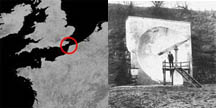
Channel Communication Amplifier
Lise Autogena's Sound Mirrors Project is inspired by the derelict acousic mirrors at Denge, England, it aims to create two new sound mirrors on the coast of England and France which will enable people on either side of the Channel to speak to each other.
The Channel Communication Amplifier incorporates the latest technology to transmit sound but has at its heart a device first developed before to World War II and the invention of radar: the acoustic mirrors built as early warning devices around the coasts of Britain to detect airborne invasions. These giant concrete dishes also existed in mobile and even wearable versions btw.
Autogena plans to build two acoustic mirrors. One will be placed in Folkestone, the other will be sited on the coast of France, 25 miles across the Channel.
Visitors will be able to climb up to a listening platform in front of the mirror and listen to the sounds of the sea, as well as for voices speaking to them from across the Channel. Standing at the focus point the person will hear a complete “holographic” binaural sound image which will appear to be coming from the air all around them.
Via Mountain7. More info on the project in The Telegraph, Creative Partnerships.
Lise Autogena also worked together with Joshua Portway on the beautiful Stock Market Planetarium, a planetarium of stars, each one representing a company and its relative value on the stock market. [blogged by Regine on We-Make-Money-Not-Art]
Posted by jo at 05:56 PM | Comments (0)
August 29, 2006
Interferenze festival 2006
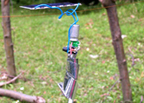
Naturalis Electronica
Digital and organic are never antonyms at Interferenze, the annual festival of new arts taking place in San Martino Valle Caudina (Italy). In the middle of a beautiful chestnut trees forest the 2006 edition lead the young local enthusiastic curator crew to succeed in integrating digital culture with their own cultural roots. 'Naturalis Electronica' was the leit motif of three days of electronic art, celebrated in a friendly atmosphere with no barriers between artists and public, sharing almost the same spaces, perfectly mixing the local environment and food tradition with the artistic research on the edge of digital and organic. The curators' commitment to this philosophy is almost total and it was seamlessly implemented in the festival program attracting the usual mass of thousands of local curious people plus experts arrived from all over the nation attending the event. Amongst the most popular one there were the workshops of the solar-powered micro-robots by Ralf Schreiber: they were unofficially repeated every day after the first crowded one. Schreiber scattered also some of his chirping electronic lifeforms around the forest as an installation ('Living Particles'), forcing the hanging around crowds to always wonder themselves if the sounds they heard was real or virtual.
Food was also one of the main topics, as in the 'gastroacoustic' performance of the Troyer brothers + Philip Furtenbach. This was perhaps even too ethereal bringing some speakers together that 'cooked' sounds at the very moment the (freely available) near raw chicken and vegetable soup was doing, placed on a wood fire. But this was not the only food involved: a professional daily workshop was available for appreciating craftily prepared cheeses, wines, truffles and hams. This kind of food knowledge was adding important levels of information in the tasting process, providing a deeper level of understanding of the manufacturing act and, more relevant, a much better conscious sensorial experience. The awareness of technical tools was the goal of a conference on the use of Open Source software to intervene in the urban and natural territory management. Stimulating the consciousness of sounds, instead, was one of the implications of 'Acquatic' by Marianne Decoster-Taivalkoski, a hidden webcam activated sound environment made out of calm / normal / frightening recordings of sea waves, triggered by the amount of audience movements. The other two installations were the famous 'Process 6,7,8' by Casey Reas, the beautiful organic drawings generation coded with his own Process programming language and an interactive showcase of the graphic organic irony of Frédéric Durieu/ LeCielEstBleu.
Sounds were omnipresent, and the locative approach of Zeenath Hasan and Richard Widerberg (IMPROVe) was refreshing. After a collective recording walk in the wood they performed a 'concert' happily cutting the found and raised sounds. A different type of collective performance was organized by the well known Japanese Sine Wave Orchestra. Their shared sinewave generating transparent eggs gave a different soundtrack to the obscure ambiental surroundings, provoking night birds wondered twitters as a reaction.
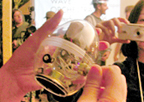
The live sets in the night were surrounded by the deep dark of sleeping mountains. Biosphere opened his long and retrospective set with agricultural samples used in his upcoming album while the Japanese O.blaat flustered a silver bowl of water placed on a big speaker with her own software-generated sound waves. The only performance unfortunately affected by nature was in the end the Emi Maeda with Lia one. While the former was intriguingly attacking a classic harp, the latter guided her graphic abstract patterns evolution on the screen, but a sudden thunderstorm interrupted the final part. With a solid partnership with the Pixelache festival in Helsinki, Interferenze is uniquely questioning the digital art festival form, going deeper and deeper in its own territory roots and extending accordingly to the rest of the world its specific research. [posted on Neural]
Naturalis Electronica, Interferenze festival 2006 photo set
Posted by jo at 11:12 AM | Comments (0)
August 18, 2006
MPG: Mobile Performance Group
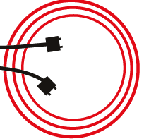
Art to Go
Founded by Matt Roberts, the MPG: Mobile Performance Group is a collective of new media artists interested in finding new ways to present art outside of traditional venues. MPG disseminates their work by using automobiles, video projection, cell phones, FM transmission, wireless hotspots, and any other technologies that allow artist to engage the public.
Parking Spaces investigates one of the most ubiquitous spaces in the United States, the parking lot. MPG moves through the city looking for empty parking lots to collect sounds and images. Using the collected material MPG creates an improvised performance in the space. Images from ZeroOne ISEA2006. Multi media feature from Mercury News. Flickr.
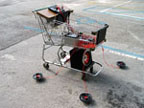
Shopping Carts: Using recycled cardboard, solar power, batteries and multimedia equipment, MPG converts shopping carts into modular performance units. During the day the carts are used to collect energy, sounds and images. Each cart is equipped with solar panels and batteries for energy collection. They are also equipped with audio/video recording equipment for sound and image collection. During the night carts carry panels, made of recycled cardboard, that allow several carts to connect and provide table space for the performers. The three basic carts are audio, video, and power. The audio module carries speakers, amps and mixing board. The video module carries video projectors, cameras, and lcd screens. The power module carries batteries, inverters and power strips to provide power for the performers.

Inflatables: A series of inflatables that can be used as performance space and projection screens. MPG is working with designer Gerry Christensen and a group of his students to create a series of apparatus for mobile performance. These apparatus include a bike trailer with a hybrid power source and wearables for performance space. The bicycle trailer is equipped with solar panels for energy collection and storage, and has the ability to tap into public power outlets. The trailers can cary multimedia equipment, local wireless network, and provide portable power. The wearable are portable devices that performers can wear to carry equipment and also convert into seating/table space for performance.
More information here. [thanks Craig]
Posted by jo at 10:29 AM | Comments (0)
August 17, 2006
Full Contact Concert

Let's Get Physical
Vollkontaktkonzert - Full Contact Concert, by Stefan Brunner and Michael Wilhelm, arranges a musical composition out of a boxing match. Two performers are equipped with microphones. One microphone, connected to a stethoscope underneath the scapula of the performer’s back, records the repercussion of the beats hitting his chest. The other microphone, glued to the performer’s chin, records his breath.
The sounds are post-processed on the laptop controlled by a third person. The whole piece of music unfolds: the introduction is the warm up. Then the performers put on the boxing gloves and a beat-part begins: performers start beating each other in turns. Two punches to the stomach then one to the chest, two to the stomach, one to the chest, etc. It goes faster and faster until the break, all you can hear is the performers' breath and sounds from the laptop. After they have recoverd from the exhaustion, the boxers start to treat each other with more punches to their chests and stomachs.
The video isn't particularly spectacular but i still like the concept. More images. Via Vvork.

There's a few boxing performances and installations around: Videoboxing, a video performance in which Thomas Heijmans and Eliane Roest merge video, new media, music, fashion, choreography and physical violence on stage; Telephoneboxing (left), by Allard Roeterink, turns the phone call into a hard-work physical process; Soundslam, a highly sensitive punching bag with built-in trainer; Cyclone Uppercut, a boxing game that runs in Virtual Reality Simulators. [blogged by Régine on we-make-money-not-art]
Posted by jo at 07:28 PM | Comments (0)
LOCUS SONUS
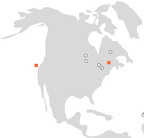
DUPLEX PERFORMANCE
THE THING invites your face and body and voice to 11 Harrison Street, ground floor storefront gallery, RIVERFAWN, for the Manhattan interface of THE THING.residency: LOCUS SONUS DUPLEX PERFORMANCE. This is a special performance that will be live from the Roebling Bridge on the Delaware River and from the RIVERFAWN Gallery in New York City. You will be part of the performance! :: 6pm –10pm Thursday August 24th :: 11 Harrison Street, ground floor* :: New York City.
Locus Sonus has constructed for this performance 2 IP webcams/parabolic microphones with which they can hunt for sounds in and around the venue streaming them simultaneously to the remote location. In each location laptop performers capture and remix the audio from the mic and video projectors show what the mobile microphones are capturing. Both mixes are played in both locations, the musicians responding to their remote counterparts. The Roebling Bridge will be set up on both sides of the river (the audience will be on the bridge). The idea being that we can use the local distance to reflect the remote distance. On the Manhattan side, the performance will take place in the RIVERFAWN Gallery where they will also use the wire/stream interface as an instrument to mix and control during the presentation. Live sounds from around the world (from the locusonus open web mics project) will also be used as raw material for the concerts.
Locus Sonus will be in residence between the 15th and the 29th of August in the USA with two installations and a duplex performance between them. The two locations will be at the DIGIT Festival, Delaware Valley Arts Alliance & Roebling Bridge Environmental Arts and at the RIVERFAWN Gallery in New York City.
DATES: The Installation at the Delaware Valley Arts Alliance opens on Saturday, August 19th and runs until August 25th. The performance Duplex Roebling Bridge/Manhattan will take place Thursday, August 24th at RIVERFAWN Gallery, 11 Harrison Street in New York City. There will also be a physical installation/interface on view from August 22nd to the 27th, 12-6pm at RIVERFAWN Gallery.
For more information: http://nujus.net/~locusonus/site/index_e.html
Audio streams: http://nujus.net/~locusonus/site/documentation/allstreams/index_e.html
ABOUT LOCUS SONUS
Locus Sonus is a research group specialized in audio art (École Supérieure d'Art d'Aix-en-Provence, École Nationale Supérieure d'Art de Nice Villa Arson). Our objective is to experiment and evaluate the innovative and transdisciplinary nature of audio art forms in a lab-type context. We are are also concerned with the communal, collective or multi-user aspects inherent to many emerging audio practices and which necessitate working as a group. Two main thematics define this research - audio in it's relation to space and networked audio systems. The "Lab" proposes a process combining practical artistic experimentation and critical evaluation in a group context. The Locus Sonus Lab is currently focusing on a process which revolves around the use of multiple audio streams. The streams which are basically open-mic continually upload chosen soundscapes or sound environments, as playable material. The way in which we work with other people to set up and maintain the streams is part of the methodology, indeed the technology provides the basis to construct a human network.
*Directions: by subway take 1 train to Franklin Street. Walk one block west on Franklin to Hudson and cross the street. Walk 1 block south to Harrison and turn right. 11 Harrison street is in the middle of the block on the south side of the street, By car: From uptown Take West Street to Vestry. Make a left on Vestry. Go two blocks make a right on Greenwich Street. Go two traffic lights , make a left on Harrison street. From downtown take West Street to Harrison street. Make a right on Harrison and go 1 block.
Posted by jo at 09:25 AM | Comments (0)
August 16, 2006
Copa Sonar

Recordings Available
Schlossplatz was once the home of the Berlin City Palace. In 1950 the palace, a symbol of Prussian pride and wealth was demolished by the GDR and erected in its place was the Palast der Republik. Due to the combination of the reunification of Berlin and the use of asbestos, the Palace of the Republic is being deconstructed and soon the old palace, Stadtschloss will be rebuilt.
Schlossplatz has historically been a highly contested site. On July 14th it became a site of public performance, sound broadcast and celebration.
Copa Sonar was organized by Marco Barotti, Emanuele Guidi and myself in collaboration with sonambiente, and tesla. Five experimental sound groups volunteered to overtake the desolate public plaza off of the touristic street Unter din Linden. Performances by ap/xxxxx, B Component, the rottt (the return of the thinking thing) and lekronk, OLYVETTY, saal-c were broadcast from the site via miniFM and visitors were offered free wine and beer. The audience was a diverse mix of sound art connoisseurs, curious tourists, and skaters.
The recordings from the event are now available as mp3s and high quality aifs to download - Copa Sonar. Enjoy the data tranformed into noise by ap/xxxxx; the relaxing sound of a Swiss precussion instrument electronically modulated by B Component; electronic and computer experimentation by the return of the thinking thing; Olyvetty's trans-like performance or the more melodic compositions of saal-c.
Also read an interview concerning the public intervention with Emanuele Guidi. [blogged by Ricardo on Structural Patterns]
Posted by jo at 06:39 PM | Comments (0)
August 10, 2006
Silverfish Stream
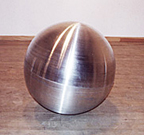
Awkward Pas de Deux
FILE FESTIVAL 2006 :: Venue: Galeria de Arte do SESI - Av. Paulista, 1313 :: Date: August 15 - September 3.
Silverfish Stream--by Constanza Silva--is a sensual, poetic exploration of the potentials of human-machine interaction. Communicating robotic spheres move through the gallery space, adjusting their behaviours in relation to each other; the result is an awkward "pas de deux" that both absorbs and excludes the viewer. Within this field of metal and fleshy bodies that adjust and readjust to each other, a complex sound environment emerges. Sonic vibrations from the machines are transformed and modulated by the movements of bodies within the multi-centric system. Viewers become part of the system in ways they can sense but not fully understand. This invites experimentation and reflection on the ways we relate to seemingly "intelligent" systems.
Constanza Silva was born in Bogotá, Colombia; she was raised in Canada and currently lives and works in Montréal, Quebec. Silva creates complex sound and robotic environments by setting minimal forms into motion within networked interactive systems. Evoking natural, technological and political ecologies, her work challenges the viewer’s sense of human-centredness and, at the same time, can elicit the most human of responses. Silva holds an MFA from Concordia University, Montreal.
Posted by jo at 07:04 PM | Comments (0)
August 02, 2006
Earworm Assault Devices

Weapons of Mass Distraction
The Earworm Assault Devices (EAD), by fur, are a set of weapons for the propagation of highly infectious sound or music (earworms).
Prologue: Sound is unavoidable (the ear can't be shut like the eye) and evolutionary hardwired into our cognition apparatus, it can reach into the subconscious and arouse emotions. A well made sound can get stuck in the head of the hearer and loop for a varying time span. The infected person oftentimes repeats the sound involuntarily by singing, humming or whistling, eventually spreading the earworm like a virus. Messages can be modulated onto earworms like radiowaves on a carrier frequency, as a result earworms can be used to distribute messages or manipulate the individual. This fact is recognized and commercially exploited in various fields of modern life - like pop music, cellphone ringtones, audiobranding or elevator music to name a few.
Global brands are using huge budgets to propagate their earworms by means of multiple costly channels, the respectable citizen remains defence- and powerless. Until now:
The Earworm Assault Devices (EAD) enable individuals or small groups to distribute their own earworms. Small pieces of highly infectious sound or music can be recorded onto the devices and fired at single or multiple persons, eventually spreading your message out into the world. They come in different shapes and sizes and are affordable for small budgets. The EWGL-1 [Earworm Grenade Launcher v.1] is one of several models currently available:
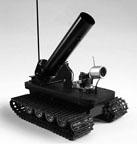
Technically the most advanced development within the Earworm Farm program. This caterpillar-driven tank is extremely agile and can be stopped by almost nothing. It is equipped with an on-board camera and a grenade launcher with a range of approx. 3 meters. The grenade is loaded before deployment (max. earworm duration 12 seconds) and the vehicle can be guided into the target area by remote control. The camera signal is radio-transmitted and gives the vehicle an extraordinary broad reach. Upon arrival at the target site the grenade is launched by pressing a button on the remote control and the earworm is triggered and looped on impact.
The EAD were developed under the umbrella of the Earworm Farm Project for the CyNetArt Dresden with generous support by the Ministry of Science and Arts, Saxony. See also: Roman Kirschner's EarwormCollider for the creation of earworms. Related Stuff: Photos of the presentation during CyNetArt 05 :: The_Earworm_Farm_Project.pdf [via Pixelsumo]
Posted by jo at 05:24 PM | Comments (0)
July 31, 2006
Freq2
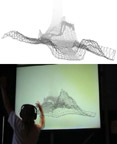
Body as Audible Instrument within Sonic Composition
Freq2, by Squidsoup, uses your whole body to control the precise nature of a sound – a form of musical instrument. The mechanism used is to trace the outline of a person’s shadow, using a webcam, and transform this line into an audible sound. Any sound can be described as a waveform – essentially a line – and so these lines can be derived from one’s shadow. What you see is literally what you hear, as the drawn wave is immediately audible as a realtime dynamic drone.
Freq2 adds to this experience by adding a temporal component to the mix; a sonic composition in which to frame the instrument. The visuals, an abstract 3-dimensional landscape, extrudes in realtime into the distance, leaving a trail of the interactions that have occurred. This ‘memory’ of what has gone before is reflected in the sounds, with long loops echoing passed interactions. The sounds, all generated in realtime from the live waveform, have also been built into more of a compositional soundscape, with the waveform being played at a range of pitches and with a rhythmic component.
Watch video. Freq2 was commissioned for Cybersonica 06 and shown, as part of Cybersonica 06, at various venues across the UK including Tate Britain, Dana Centre, Phonica and b-tween (National Museum of Photography, Film and Television). More from Squidsoup: Altzero, Come Closer, Doodle. More from Cybersonica 06. [blogged by Chris on Pixelsumo]
Posted by jo at 05:51 PM | Comments (0)
July 21, 2006
BUMP…
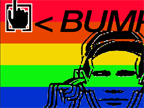
Reinstates the Virtual World with an Offline Voice
Artist Jaygo Bloom has been commissioned by folly, a media arts organisation based in Lancaster, to develop the sound work BUMP… for this year’s Futuresonic festival, in partnership with Manchester based digital signage organisation Pixel Inspiration. Futuresonic is the UK’s leading electronic and media arts festival, and takes place in Manchester in July 2006. According to Jaygo Bloom, the commissioned artist, "As computer technology becomes more sophisticated, the technology itself will fade into the background of human activities, becoming far less intrusive than is the case today."
Jaygo Bloom suspects the invisible, therefore he seeks to reverse the need for this technological transparency. BUMP… reinstates the virtual world with an offline voice. BUMP… is an online project that translates an online keystroke into an actual real time and physical event. BUMP… will reinstate the presence of this technological intervention over its environment via the quick shot, rapidfire, 8bit sounds emanating out of its location based folly sound modules located throughout participating venues of Futuresonic 2006. BUMP… presents an interesting view of networked interaction and social performance.
Jaygo Bloom concludes, "By attaching a physical connection to things we perceive as virtual, we can begin to make the intangible tangible."
Jaygo Bloom is a UK based multimedia artist whose practice includes audio visual installation, game hacking, film making and physical computing. Over the past year he has been developing a wide variety of new online and offline projects ranging from his globally aware interactive games console ‘Tao Joystick’ to his 8bit latino percussion interface ‘Marrackattack’. Working independently and also as part of the Glasgow based audio visual team 'Pointless Creations'. Popular for his public interventions, blue screens and old sports car, other successful projects have included Glasgow International05, Pixelache05, Recontres Paris/Berlin, and Pong.Mythos.
Posted by jo at 04:27 PM | Comments (0)
July 18, 2006
Turbulence Commission:
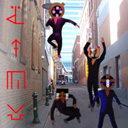
SWM05: Distributed Bodies of Musical-Visual Form
SWM05: Distributed Bodies of Musical-Visual Form [SWM05] -- by Troy Innocent and Ollie Olsen with the Shaolin Wooden Men and Harry Lee -- features the distributed bodies of musical-visual form that are inhabited by the Shaolin Wooden Men (SWM), a virtual band, a 'gang of numbers' -- me(a)tacodeflesh. SWM require your assistance to manifest as media creatures. They invite you to send them images of your local environment in which they can appear. Sending images unlocks access to the SWM05 mobile site which consists of downloadable micromusic ringtones and small screen machinima performances. The SWM are everywhere. In a meshwork of wireless entities, they are media creatures seeking a fragmented existence to be consumed in the nanoseconds of play-time in the emerging wireless net. SWM05 will transfigure the SWM by embodying them in a new materiality.
SWM05: Distributed Bodies of Musical-Visual Form is a 2005 commission of New Radio and Performing Arts, Inc., (aka Ether-Ore) for its Turbulence web site. It was made possible with funding from the Andy Warhol Foundation for the Visual Arts.
BIOGRAPIES
The SHAOLIN WOODEN MEN are a 'gang of numbers' whose bodies are 'made of sound'. In their various manifestations they have released three full-length recordings - "S.W.M. " (1992), "The Hungry Forest" (1994) and "Supermindway" (2001) - and a collection of singles and remixed released on the Psy-Harmonics label. The S.W.M. work across image, sound and interactivity and have performed at DEAF96 and exhibited at ISEA96. Typically, they require the assistance of creative humans to manifest as media creatures to be distributed across the net.
TROY INNOCENT has been exploring the 'language of computers' and the new aesthetics of digital space since 1989. In recognition of this work, Innocent has been described as "the first philologist of virtual reality". His artificial worlds – Iconica (SIGGRAPH 98, USA), Semiomorph (ISEA02, Japan), and lifeSigns (Ars Electronica 2004, Austria) and Ludea (SIGGRAPH2006, USA) – explore the dynamic between the iconic ideal and the personal specific, the real and the simulated, and the way in which our identity is shaped by language and communication. He is currently Senior Lecturer, Department of Multimedia and Digital Arts, Monash University, Melbourne.
OLLIE OLSEN is an Australian composer, synthesist and sound designer who has been producing and performing rock, electronic and experimental music for the past thirty years. Projects include "Max Q," "NO," "Third Eye," "Orchestra of Skin and Bone," "Shaolin Wooden Men," and "I am the Server." Some recent collaborations and projects include performing with Negativland (from USA-2001); guest soloist with the Australian Art Orchestra (2002); and recording with Japanese bands, BOREDOMS and AOA (2001-2002.
HARRY LEE is a web developer working with Macromedia Flash, SQL, PHP and related technologies. Recent projects include database development for lifeSigns, exhibited at the Australian Centre for the Moving Image (ACMI) in 2004, in addition to numerous corporate and education projects. He lectures in multimedia and digital arts in the Faculty of Art & Design at Monash University.
Posted by jo at 01:06 PM | Comments (0)
July 11, 2006
Simon Elvins' Silent London
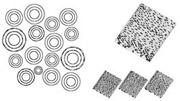
Mapping Sound
Simon Elvins is concerned with sound as an ubiquitous force. Through a series of projects he has been documenting how sound is an often ignored dimension of our physical environment. Silent London plots quiet spaces in the English capitol using noise level data. An embossed print shows quiet areas raised up from the paper, bringing them to the attention of the viewer, while noise areas become blanked out valleys. noisy areas raised up from the paper while quiet areas become blank areas of peace. His FM Radio Map serves a dual purpose. On the one hand it plots the physical locations of commercial and pirate FM radio stations broadcasting in London. But circuits conductive pencil lines placed on the back of the map also turns it into a physical interface. Using a modified radio the map can be aurally “navigated” by placing metail contacts on points on the map.
These projects are poetic but ultimately functional. Taking a conceptual design approach (Elvins studied Communication Art & Design at the Royal College of Art), they present numerical data in an aesthetic context. By choosing low-tech materials (paper, electronics) Elvins creates fragile objects whose material qualities belie their sophisticated technical content.
Simon Elvins is concerned with sound as an ubiquitous force. Through a series of projects he has been documenting how sound is an often ignored dimension of our physical environment. Silent London plots quiet spaces in the English capitol using noise level data. An embossed print shows quiet areas raised up from the paper, bringing them to the attention of the viewer, while noise areas become blanked out valleys. noisy areas raised up from the paper while quiet areas become blank areas of peace. His FM Radio Map serves a dual purpose. On the one hand it plots the physical locations of commercial and pirate FM radio stations broadcasting in London. But circuits conductive pencil lines placed on the back of the map also turns it into a physical interface. Using a modified radio the map can be aurally “navigated” by placing metail contacts on points on the map.
These projects are poetic but ultimately functional. Taking a conceptual design approach (Elvins studied Communication Art & Design at the Royal College of Art), they present numerical data in an aesthetic context. By choosing low-tech materials (paper, electronics) Elvins creates fragile objects whose material qualities belie their sophisticated technical content.
Parallel to Elvin’s interest in sound is his fascination with mapping of physical and intangible forces. Both the aforementioned projects are classic mapping projects, while Notation is a more abstract exploration of how sound can be represented visually as marks on paper. Reminiscent of experiments with graphic notation (see Eno etc), the project consists of studies of representations of tonal patterns using pencil on paper.
The Notation project page seems to indicate that these drawings can ultimately be used to produce sound, but no details are available. If so, it would be an inversion of Elvin’s excellent Paper Record Player, where he constructed a functional record player out of paper, complete with its own conical paper amplifier.
(Thanks to TomC. See also Mount Fear.) [blogged by Marius on Generator.x]
Posted by jo at 09:24 AM | Comments (0)
July 10, 2006
Chasing Pools and Sampling Ghats

HIDRAZONE ISSUE 002 X 2
Chasing the Pools is an immersive performance/installation working with integra-ting the live presence of dancers into the landscape of a multi-channel live-mix video installation. Often the two present very different viewing circumstances that remain independent of one another.
Through live-feed cameras the movement of dancers was mixed into the alpha channel of 3 video mixes. Their lit bodies became one moving image, dematerializing or re-materializing the body, while the background remained another. The dancers were able to monitor how they were affecting the composited image, essentially dancing with the image.
These channels were projected onto numerous scrims in a large tree grove. Twelve channels of sound by live musicians were mixed and spatialized throughout the site. The architecture of a tree grove naturally imposed a de-centralized structure upon the viewer where one’s experience was shaped by the act of meandering through, never being allowed a view of the whole.

Samples of the Ghats is a responsive installation that invites the audience to explore the ghats of Haridwar, India by composing themselves its audio-visual atmosphere.
A 5 metre long structure featuring a panorama of the ancient and holy city of Haridwar framed with technology is a stimulus to curiosity, an appeal to exploration. Cruising along the panel visitors soon discover that they can "play it." With the simple move of his hands he launches media sequences. They are audio and visual samples, pieces of Haridwar, collected and edited in a way to generate an atmospheric feel of the ghats.
In a collective experience, the panorama comes to life and the adventure begins.
More Hidrazone Issue 002: Performativity
Posted by jo at 07:26 PM | Comments (0)
July 05, 2006
RainDance + A Light Rain
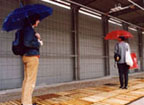
Water Music
RainDance is an interactive sound installation by electronic media artist Paul DeMarinis. The installation uses water to create non-water sounds. Jets of water modulated with audio signals carry sound vibrations that are inaudible to the human ear. The sounds cannot be heard until the water jet is intercepted by a large umbrella. The sound is then decoded and resonated from the surface of the umbrella. The umbrella thereby turns into a new and different kind of loudspeaker.
Diverse electronic and acoustic material is modulated onto the streams so that people strolling along under the water jets can listen to, mix, modify and sequence a variety of sonic material, ranging from musical standards to rhythmic and electronic music.
The installation was exhibited at the Ars Electronica festival in 2001.

Also check out the related work by Paul DeMarinis, A Light Rain, in collaboration with Rebecca Cummins. In A Light Rain participants carry the umbrella into a rainbow created by streams of water. Music can then be heard as the umbrella meets these streams of water.
Check out the video of RainDance. [blogged by Lene Mailund on Digital Experience]
Posted by jo at 08:47 AM | Comments (0)
July 03, 2006
Digital Art Weeks 2006
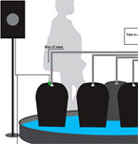
Symposium + Installations
Digital Art Weeks :: Symposium :: Artworks including:
The Waterbell Project--by Etsuko Maesaki--is a sound installation based on the Japanese 'Suikinkutsu'. Suikinkutsu ("Water Harp") is a unique feature of Japanese gardens. It consists of a large earthen jar with a hole in the bottom. This jar is buried upside down into the ground next to a water basin. When the waterdrops seep from above into the jar, they make a sound somewhat similar to what you would hear in an underground cave. The Waterbell Project consists of five vessels standing in a basin. A tube directs drops of water to the top of each of these vessels. When they drip into the water inside the vessels a sound can be heard. The frequency of the drops and the amount of water in the basin is controlled by a computer. At the same time this computer gathers realtime data from the internet: The price of oil in Japan and the temperature of the ocean. The frequency of the waterdrops dripping into the vessels corresponds with the temperature of the ocean, the water in the basin raises and drops with the price of oil, hence changing the quality of the sound made by the drops.
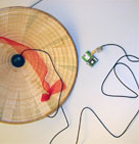
CHINA GATES by Art Clay, Dennis Majoe, & The China Gates Workshop-Ensemble: The early experiments of Charles Ives's father with marching bands crossing at intersections and his son's adoption of it, proves that interest in exploring mobility has fascinated even before electronic devices. As with Ive's marching band polytonality, we also have the opportunity using modern technologies from the Walkman to the Wearable not only interact with local surroundings like Ives, but for the first time also on a world wide level. Global networking systems such as GPS amoungst others have created a ubiquitous environments in which we can now make art in. China Gates is a work for GPS Wrist conductors and tuned gongs for an ensemble. The work addresses the concept of audience in public space through the possibilities of the GPS Wrist Conductor and an acoustic concept of music making in public space. Anyone interested in joining the workshop is welcome. It is open free of charge to those interested. The performance will be held regardless of whether conditions at Platzspitz and will be performed by a group of artists and musicians who took part in the DAW06 Mobile Music Workshop.
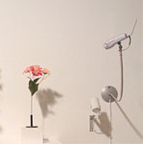
Motion Still Life 1--by Will Pappenheimer--extends the artistic tradition of the picturesque and spatial object arrangement into the domain of the Internet. A live Web camera frames a physical still life scene with vase, flowers and still life objects. Through its counterpart website, aesthetic controls allow internet viewers from anywhere to adjust the composition telematically in the distant space of the gallery. The Internet user is the surrogate artist. The time and space of the scene is ever-changing and accessible for the moment that becomes the still life. Exhibition visitors are able to see virtual participants configuring the still life through object movement, blinking LEDs connected with online activity, and multi-colored lighting for night time or alternative illumination. The mechanism is constructed from a self-contained network pan and tilt surveillance camera which has been disassembled and reconfigured for a more friendly gesture.
Posted by jo at 04:53 PM | Comments (0)
June 22, 2006
Upgrade! New York
![]()
Participatory Performance and Interactivity
Jesse Pearlman Karlsberg + Micah Silver + Judy Dunaway :: June 29, 2006 @ 7:30 PM, Eyebeam, 540-548 west 21st street (bet 10 & 11 Ave).
This month's Upgrade! New York examines participatory performance and interactivity in the context of contemporary sound art and new music. The evening brings together three artists working with sound and music: Jesse Pearlman Karlsberg, Micah Silver, and Judy Dunaway. Each of these artists draws their audience into the creation of their work.
Jesse will discuss Azariah: Whom Jehovah Helps, a new project weaving book arts, poetry, shape note singing, and storytelling into a participatory live event. Azariah turns its audience into an impromptu chorus and draws on Jesse's experience working with shape note singing, audience participation, and New York's religious history.
Micah will talk about his recent installations The Phoenix, *Asterisk, and Carousels. Each piece draws from the local audience's aural and physical experience of site as primary source material.
Judy will talk about her work with balloons and how she draws her audience into music-making, and will be presenting her Balloon Symphony #2. Judy Dunaway's BALLOON SYMPHONIES are audience-participation works. The Balloon Symphonies should not be performed by children under 8 years of age without adult supervision.
BIOS
Jesse Pearlman Karlsberg is a sound artist and shape note singer whose work explores politics, religious practice, singing, and personal narrative. Jesse's work is interdisciplinary. While grounded in sound, his projects have mixed book arts, installation, poetry, singing, composition, audio tour, and theater. His current work investigates the history and practice of American shape note singing and the social and religious movements of nineteenth-century upstate New York. Jesse has presented work at the Tang Museum, Boston Cyberarts Festival, Jessica Murray Projects, CCCB (Barcelona), CAC (North Adams), Google Inc., Old Songs Building, Psy-Geo Provflux Festival, Wesleyan University, and Rensselaer Polytechnic Institute. He is a member of Festival Harmony, and of Tintinnabulate, an ensemble founded by Pauline Oliveros. His shape note music has been sung at singings throughout the Northeast, and his experimental music has been performed by Pauline Oliveros, Anne Rhodes, Angela Opell, Caterina De Re, and Tim Eastman, among others.
Micah Silver was born 1980 in Sylva, North Carolina, but grew up in rural Massachusetts. He studied music composition and art at Wesleyan University where his primary teachers were Alvin Lucier, Anthony Braxton, and Ron Kuivila. He has also studied privately with composers Lewis Spratlan and
Earle Brown. Recent projects include *asterisk for 12 broken grand pianos, loudspeakers, and transduced glass, commissioned by The Hudson Valley Center for Contemporary Art; Carousels, a commission by the James Joyce Centre, Dublin for the centennial of Bloomsday, and The Phoenix a six-month-long outdoor installation commissioned by the City of New Haven. Further information on Silver's work can be found online at nophones.org.
Judy Dunaway is an internationally known sound artist whose works for balloons have been presented throughout North American and Europe including the Roy and Edna Disney Center, Lincoln Center Out-of-Doors, Seltsame Musik Festival, Podewil, ZKM, New Museum of Contemporary Art, Everson Art Museum, Bang On A Can Festival, Seance Ecoute, Diapason, Roulette, Galerie Rachael Haferkamp, Moltkerai Werkstatt, Guelph Jazz Festival, Gracie Mansion Gallery, P.S. 122, Alternative Museum, and the Swiss Institute. Awards / grants / residencies include the Aaron Copland Fund, American Composers Forum, Meet the Composer, ZKM, Harvestworks, and the NEA. Her new CD "Judy Dunaway: Mother of Balloon Music" was just released on Innova Recordings. Her discography also includes recordings on CRI and Outer Realm. Ms. Dunaway holds a M.A. in Music from Wesleyan University and a Ph.D. (candidacy) in Music Composition from State University of New York (Stony Brook).
Upgrade! is an international network of gatherings concerning art + tech + community.
About our partner: Eyebeam supports the creation, presentation and analysis of new forms of innovative cultural production. Founded in 1997, Eyebeam is dedicated to exposing broad and diverse audiences to new technologies and media arts, while simultaneously establishing and demonstrating new media as a significant genre.
Posted by jo at 02:13 PM | Comments (0)
June 14, 2006
INTERVIEW: LOREN CHASSE
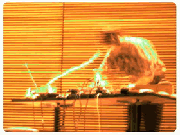
PHOTOGRAPHING ACOUSTIC SPACES
"The American Loren Chasse is one of the most important international artists working in the areas of environment and sound. His ability to listen and to transform an object into “musical instrument” is the most identifying feature of his work.
If field recordings are more and more common in “experimental” music, then Loren Chasse does not only have a different way of using sound, but he manages to “photograph” with his microphone the acoustic spaces in which he works.
Chasse shifts the traditional frontier of art by blurring the differences between music and sound art, if it can even be assumed that they exist. Beyond his activities as a musician and his several collaborations, he is a teacher in the San Francisco School District where he organizes workshops on skilled and creative listening." From INTERVIEW: LOREN CHASSE, PHOTOGRAPHING ACOUSTIC SPACES by Luca Bergero. This text is republished in collaboration with Digicult.it. It was released on March 2006, and has been edited for republication on newmediaFIX.
Posted by jo at 05:22 PM | Comments (0)
Christina Kubisch
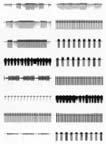
Electrical Walks: Samples of Raw Sounds
In 2003, Berlin-based sound artist Christina Kubisch began an ongoing project called Electrical Walks. This project employs specially built headphones that receive electromagnetic signals from the environment and convert them into sound. Kubisch maps a given territory, noting “hot spots” (ATM machines, security systems, electronic cash registers, subway systems, etc.) where the signals are particularly strong or interesting. She then loans the headphones to the public, allowing participants to undertake an auditory dérive through the invisible network of electromagnetic information.
To date, Kubisch has undertaken her own personal walks in Germany, England, France, Ireland, Japan, Latvia, Sweden, Switzerland, Slovakia, Spain, Taiwan, and the United States, and has held public walks in Berlin, Cologne, Karlsruhe, Bremen, Oxford, and London. To accompany the interview with Kubisch in Cabinet no. 21, she has provided us with thirty sound samples gathered by her while walking through various cities. Go to Cabinet Magazine to listen. [via BLDGBLOG]
Posted by jo at 09:38 AM | Comments (0)
June 09, 2006
Memento
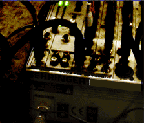
A Monument to South African Youth
On 16 June 2006, South Africa celebrates the 30th anniversary of Youth Day. The act of remembrance is shaped by a multitude of senses ranging from sight, sound, physical touch and smell. This year Gallery MOMO invites you to join us in commemorating Youth Day through the experience of sound. Nathaniel Stern, João Orecchia, Shane de Lange, Johan Thom and Dinkies Sithole will work together to create a Memento - a sound sculpture to commemorate Youth Day. At 16:00, one hour performance, drinks served. 52 7th Ave, Parktown North, Johannesburg, South Africa.
The artists will draw from their own, particular experience of life in contemporary South Africa to formulate a personal, aural response to the celebration of Youth Day. For example, both Shane de Lange and Nathaniel Stern are best known as artists working with digital media to create art: de Lange creates experimental sound by appropriating and sampling sounds from various sources including music, the body and even the sounds of a paper bag; Stern is known as a new media artist who uses interactive digital technology, often drawing the viewer and the artwork together in a new interactive, symbiotic whole.
Other participating artists like João Orecchia, Johan Thom and Dinkies Sithole work with media such as musical instruments, video, performance and even their bodies to create experimental works that more often than not, refuse easy classification as ‘visual art’.
Nonetheless, all the artists share a playful, experimental approach towards the creation and presentation of their work. In this way, each artist will prepare a series of aural responses to the commemoration of Youth Day. [via nathaniel's blog]
Posted by jo at 12:48 PM | Comments (0)
May 31, 2006
Music for Bodies
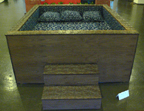
Sonically Mapping the Body to Architecture
Music for Bodies: terrestrial and virtual research into new ways of making and listening to music; directed by Kaffe Matthews.
Music for Bodies is a research project linking the sonic mapping of human bodies to architecture, through a practical study of bioresonance and interface building. Its aim is to discover new methods of experimental music making, as well as make new music more accessible to the wider community. It is doing this concentrating on making music to feel rather than just listen to. Currently it is making Sonic Beds around the world; it recently won an Award of Distinction for Digital Music at Prix Ars Electronica:
"Kaffe Matthews’ Sonic Bed_London installation consists of a bed equipped with built-in loudspeakers; when installation visitors lie down on it, an endless loop of sounds washes over them. Due to their frequency and intensity, these sounds are perceived not only with the ears but also with the entire body in what is a very pleasant experience.
The installation has already been exhibited several times and has proven to be a popular attraction with young and old alike since it harmoniously appeals to several different dimensions of human life. The choice of what is actually a rather intimate object used in everyday life as well as the proximity of other installation visitors opens up a strong social component. On the other hand, the installation also makes it possible to experience sound in a new way and thereby provides access to a new auditory dimension."

Sonic Bed_London's public launch is on Saturday June 17th, where the public are invited to come lie in it and contribute to an open forum at Annette Works studio, Hackney, London E8.
Following the launch, Matthews will run free workshops facilitating anyone wanting to make music for the Bed using this instrument over the summer after which research will continue developing and building new interfaces and new music for them.
Overall this work is intended to continue in 2 strands as follows: -
I.
To continue to develop new prototypes, interfaces/spaces, for music appreciation which interface via physical contact to the human body, carried out through collaboration with multidisciplinary professionals
II
:: To develop an understanding of the electromagnetic frequency maps of the human body and of the effect of different sonic vibrations on its different areas. To use what is learnt to build a new software instrument, a bio sonic mapping processor, (bsmp) to make music for these interfaces.
:: To use the developing bsmp to make music with members of the community for the prototype interfaces.
:: To install and test these interfaces in the community, eg. the laundrette, café, bank, chip shop.
:: To pull it back to studio, evaluate, ask questions and move the process on.
All aspects of the research will be documented here at www.musicforbodies.net
Other projects by Kaffe Matthews include Three Crosses of Queensbridge and Radio Cycle.
Posted by jo at 11:06 AM | Comments (0)
May 30, 2006
Waves
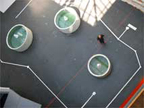
Wading Compositions
Waves is a sound installation that uses buoys to connect wading pools in two different locations and create sound compositions generated by the energy of waves in a wading pool.
An accelerometer in each buoy measures the magnitude of waves through x- and y-axis position changes caused by the rocking back and forth of the buoy on the water's surface. The accelerometer's readings are converted into sound waves by a microcontroller connected to a SPEAKjet sound synthesizer IC. The SPEAKjet's output is then amplified and sent to a speaker integrated into the buoy. Each buoy plays a electronically generated minimalistic tone that reflects the participant's movements in the wading pool.
Each group of waders create their own audio composition as they influence the magnitude and frequency of waves in the pool with their splashing and playing. When no waders are in the pool, the buoys reflect their environment by responding to the waves created by wind blowing through the park, or silence when both air and water are still.
By Shannon McMullen and Fabian Winkler. Images courtesy of the Fabian Winkler. Other work by this artist: Dielectric. [blogged by Régine on we-make-money-not-art]
Posted by jo at 02:10 PM | Comments (0)
May 10, 2006
Cybersonica 06 Opens!
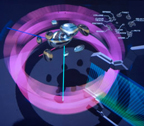
New Interactive Interfaces
"My reason for irregular postings on Pixelsumo has been due to curating and coordinating the Cybersonica 06 Sonic Art exhibition. After a huge amount of work by the team, I can now happily say that the exhibition is now open and we have 12 truly great pieces installed in the gallery space. I highly recommend you get to London to check it out. Full documentation of all the work will be posted online, but I don’t want to ruin any surprises for now.
We have commissioned 5 new works, plus showing many existing works. The works have been selected for their exciting approaches to creative interactivity. They move beyond the ‘screen, keyboard, mouse scenario’ and respond to physical input, proximity, sound, kinetics, elapsed time and the surrounding environment.
Dates: Monday 8th - Saturday 20th May; Location: Phonica Records / Vinyl Factory, Soho London; map & opening hours. Preview video 1 - Preview video 2; Behind the scenes photos; List of artist & works." [blogged by chris on Pixelsumo]
Posted by jo at 01:10 PM | Comments (0)
sonambiente berlin 2006
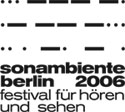
sound art festival in june
Making the city itself a work of sound art — sonambiente berlin 2006 - the festival for hearing and seeing is accompanying the events round the Football World Cup for six weeks, from June 1st to July 16th. For the second time since 1996, the Berlin sound art festival offers a platform to acoustic art of all colours and stripes — visual art, sound art, performance, video art, media art and music. Also the festival looks into the increasing significance of sound in visual art, staging the interplay between visual artists and sound artists at some dozen different locations.
Highlights of the sonambiente berlin 2006 opening weekend, June 1st to 5th, include a site-specific sound and light installation at the Potsdamer Platz metro station by the Austrian artists group [dy’na:mo] and the performance by the freq_out orchestra with the Swedish artist Carl Michael von Hausswolff. Plus, the sonambiente_exhibition, which stands at the centre of the six-week festival, opens its doors to works by some 75 internationally known artists such as Candice Breitz, Janet Cardiff/Georg Bures Miller, Terry Fox, Christina Kubisch, Bernhard Leitner, Aernout Mik, Helen Mirra, Carsten Nicolai, Finnbogi Pétursson and Pipilotti Rist with Gudrun Gut.
Live performances, concerts, conversations with artists, and a film series round out the programme of the exhibition, which can be seen and heard at five central locations, for example both Akademie der Künste buildings, throughout the festival. First-time venues include the Pumpwerk in Holzmarktstraße (Radialsystem V) with its spectacular smokestack and the former Polish Embassy on Unter den Linden. Many works focus on the unusual spatial conditions at the different locations; they relate directly to Berlin and document the city's evolving structure. Alongside established artists, sonambiente berlin 2006 integrates a number of international art colleges and universities by introducing the works of their outstanding students and graduates at the sonambiente_laboratorium.
An additional focus of sonambiente berlin 2006 is the double pass between art and football. Several artists, Tilman Küntzel, Alfred Behrens and others, are setting up special projects round sound, art and football. Also the festival extends an open invitation to follow the World Cup live, inside the artistic framework of the sonambiente_public viewing sound art lounge designed by sound artist Kalle Laar, from June 9th to July 9th at the Haus der Berliner Festspiele.
Projects developed specifically for radio and the Internet are also part of sonambiente berlin 2006. Nicaraguan-born New Yorker Ricardo Miranda Zuñiga intervenes in Berlin's public space. The artist, who received an award at Ars Electronica Linz 2004, is converting a shopping cart into a mobile radio station. Belgian artist and filmmaker Ana Torfs, who also took part in sonambiente 1996, contributes a net art project about Hanns Eisler's "Hollywood-Songbook“, created in collaboration with the Dia Art Foundation in New York, on the sonambiente website www.sonambiente.net, for example.
sonambiente berlin 2006 is presented by the Berliner Festspiele and the Akademie der Künste. The festival is initiated and curated by Georg Weckwerth (free-lance artist and curator) and Matthias Osterwold (Artistic Director of MaerzMusik – Festival of Contemporary Music in the Berlin Festivals). The festival is sponsored by the Capital Cultural Fund and supported by the Allianz Cultural Foundation.
June 1st to July 16th 2006
Opening: June 1st 2006, 6 p.m. at Akademie der Künste, Pariser Platz (opening of the exhibition and bus shuttle for further festival-locations)
Posted by jo at 09:06 AM | Comments (0)
April 22, 2006
Sound performance in London
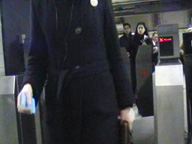
Arphield Recordings
Arphield recordings is a project documenting sound performed with RFID (arphid) technology, the radio frequency identification system used for access control and surveillance. The microchip inside each Oyster card tracks your journeys, beeping every time you enter or exit the tube. Join the mob at the Stockwell tube station for an impromptu sound jam/memorial using your oyster cards. 10 June 2006 at 14pm. Download the arphield Recordings podcast from http://odeo.com/channel/85358 and bring the sounds on a portable music player to experience a mix of live and prerecorded Oyster beeps.
The project started with the idea for an arphid mob, inviting friends to join the artist at a designated tube station for a semi-coreographed sound jam using oyster cards. The main question was ‘when and where’ as a major impediment would always be the heavy security at all the gates. It was decided the artist would do some observation and this would eventually indicate the best timing and location for the arphid mob. Observing the familiar tube’s access control gates, initially with no equipment and later with a video recorder, she realised that people were already engaging in impromptu sound performances. My documentation led me to discern varied patterns and even participatory scores, with mass arphid soundscapes punctuated by silences, glitches and cracks in the system, all warped up in a circadian rhythm of work-rush hours.
The first arphield recordings –documenting the impromptu sound performance of people moving through the London tube access control gates were done in Brixton, Kings Cross and Caledonian Road tube stations during march 2006 for the TAGGED one day event at SPACE Media Arts (NodeLondon March 2006), when cds with the tracks and locational tags were distributed.
The project remains open to contributions. One way of doing this is downloading the arphield recordings and visiting the station gates with the sounds on a portable music player to experience a mix of live and prerecorded oyster beeps. Another way of participating is by contributing arphield recordings from a tube station access control gate. You can do this by opening an odeo.com account and uploading your recordings, tagging them as arphieldRecording followed by the number unique to your oyster card (as in arphieldRecordings-0503266130-03)
The next arphid mob will happen at the Stockwell tube station, South London. Join us for an impromptu sound jam/memorial using our oyster cards, on Portugal day,the 10th of June 2006 at 14pm. Download the arphield Recordings podcast from http://odeo.com/channel/85358 and bring the sounds on a portable music player. Part of Welcome Goodbye Adeus Obrigada, a Portuguese festival of theatre and visual arts at the Blue Elephant Theatre and the Little Portugal.
Posted by luis at 07:36 AM | Comments (0)
April 16, 2006
¢apital magneti¢

Social Music Composition with Credit Cards
Each magnetic card, like its owner, is unique. ¢apital magneti¢, by Mark Trayle, is a network-based installation that explores the musical possibilities of the credit card. Participants can use their credit cards and bank cards to compose pieces of music in cooperation (or competition) with other participants. Special ATM machines are used to read the card: they contain a PC, a monitor, a credit-card reader and two speakers.
Each time a card is swiped the contents of its magnetic stripe are captured and parsed to form the melodic motifs of a short musical composition. Using genetic algorithms, compositions compete in a simulated music marketplace. Some become dominant, others less 'popular'. Some combine to form new 'styles' or 'genres' that in turn influence the more popular ones, etc.
Trayle will be on Friday April 7th 8pm at Machine Project in Los Angeles, to read your credit card data and turn it into music.
From Musical Credit Cards on we make money not art.
Posted by jesse at 10:52 PM | Comments (0)
March 02, 2006
free103point9
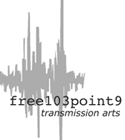
Participate
Celebrate nine years with free103point9 this March: free103point9 started on March 7, 1997 with a show at a loft near the second L stop in Williamsburg, Brooklyn, with DJ Singe, I-Sound, DJ Matt Mikas, and others.
For nine years, free103point9 has strived to promote transmission artists, and those who wish to use radio in a creative way, as well as serving as a community resource for New York. Our "Radio Lab" education program has enabled others, and free103point9 Online Radio and our extensive online Audio Archives reach around the world.
We urge everyone to celebrate nine years of free103point9 by adding an event of your own to our Schedule web page, and spread the word about whatever activism, sound art, or performance you are working on:
((((( ADD YOUR EVENT ))))) http://www.free103point9.org/schedule.php
((((( ADD YOUR SOUND ))))) Send CD, LPs for airplay on free103point9 Online Radio to: freee103point9 Wave Farm, 5662 Route 23, Acra, NY 12405
((((( AIRtime Residencies at free103point9 Wave Farm ))))) AIRtime residencies provide a valuable space for artists to pursue new transmission works with access to equipment and technical support, and conduct important research about the genre using free103point9's resource library. Residencies are available by application. Approximately ten artists are selected each season. Residents are provided with meals and train travel or gasoline reimbursement from New York City (or comparable distances.)
Projects worked on during AIRtime residencies are considered for possible release through free103point9's Dispatch Series. Selected projects are presented in conjunction with free103point9's exhibition and presentation program PETS. Artists-in-residence also interact with free103point9 Online Radio, presenting live on-air programming during their stay when appropriate.
Facilities and Environment
Residents are housed in a private cabin with WiFi access, on free103point9's Wave Farm. The cabin is situated across from the residency of Program Directors Galen Joseph-Hunter and Tom Roe where meals are provided. Equipment, studio space, and reading and listening libraries are also located here during the 2006 program. (AIRtime will move to a dedicated study center and residency facility opening summer 2007.)
Equipment and Resources
Residents have access to a variety of transmission equipment (transmitters, radios, CBs, walkie-talkies, etc) and analog and digital recording gear. The library contains hundreds of publications concerning television, radio, media art practice and theory, as well as audio and video resources.
2006 APPLICATION PROCESS
Postmark/e-mail deadline: May 1, 2006
free103point9
attn: AIRtime
5662 Route 23
Acra, NY 12405
info[at]free103point9.org
Please include the following in your application materials: Name of Artist/Collective Contact e-mail Contact phone
CV/Resume
Artist Statement
Without exceeding 500 words, please describe your
current artistic practice.
Proposed Project Narrative
Without exceeding 1000 words, please describe your project. Please include your anticipated timeline for completion.
Note: AIRtime residents are not required to complete projects during their residency stay.
Work Samples
Work samples may be presented in the form of images,
audio, video, and/or urls.
Desired AIRtime Schedule
Residencies are available July - October 2006.
Please identify the time-period you would like to be considered for; residency durations are flexible.
For more information see: http://www.free103point9.org/airtime.php
Posted by jo at 11:54 AM | Comments (0)
March 01, 2006
Electroprobes
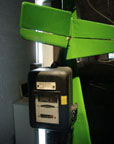
Shit! I forgot the iPod!
Electroprobes: Electric babblings. Magnetic hums. Inaudible whistles. Quite a while ago, objects started to speak. With time, they grew smarter. They now have a rich vocabulary. They think and dream...
Shit! I forgot the iPod!, by Troika, is a electromagnetic environment specially created for the electroprobes. The installation presents a chaotic assemblage of electric/electronic objects, commonly found in the houses of the 21 st century: electric appliances, mobile phones chargers, DVD players and transformers.
The inherent order behind this chaotic assemblage is revealed by the electroprobes. The various objects are arranged by their electromagnetic tunes in order to create a magnetic ‘orchestra’ that the user is able to hear with the probes. We wanted to reveal their dreams and inaudible dialogues, while creating an alternative taxonomy of the objects in an apparently chaotic sound organ.
Electronic objects have a wide range of electro-tunes: a fridge is bassy and warm, so is a TV screen. A computer scanner creates a high pitched whistling. An LED display board sounds like medium rain. You can also find percussion in the electromagnetic realm: a wireless telephone will pulse hard bass beats, clocks with seconds will provide damp strokes.
Electromagnetic melodies performed by a drill and a TV, songs of interferences between a neon light and a heater, GPS bass lines with remote control solos, the soundscape created by this apparently chaotic sound organ is various, intriguing and ever-changing.
Posted by jo at 04:47 PM | Comments (0)
February 13, 2006
ECHOES FROM THE MOUNTAINS

Sounds of XX Winter Games
Sound surrounds us all the time. John Cage pointed out that there is no such thing as silence; from practically the time we are conceived until the time we die, we live bathed in non-stop sound. Echoes From the Mountains – Suoni in Alta Quota, a sound project of the official Cultural Olympiad program, is about tuning into this force of nature and of art creating “sound environments” which will stimulate the public to pay more attention to the world of sounds, may these be natural or the elaboration of an artist or a composer.
All of the artists--with the exception of the ones showcased in the Morrow Sound Cube--were asked to produce specific sound works responding to the unique characteristics of the project such as its geographical location, the Winter Olympic Games framework, and the diverse and heterogeneous audience that is going to interact with their installations.
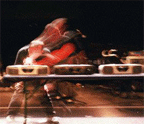
Special event of the project will be Phil Kline’s performance Chinook, a sound sculpture of many individual parts, recorded on audio tapes or CD and played through multiple moving boom boxes. The participants to the performance are asked to meet at a certain time and in a given location and to bring along their own boom boxes (some will be provided by the organizers and available for those who may not have their own). Kline will then give out the cassettes and CDs to those provided with a stereo and at his go! they are asked to push the play button. The artist leads the crowd in a 30 minutes “musical stroll” throughout the streets of the town.
Sound installations:
JOE DIEBES, Emblem: Salice d’Ulzio, giardini pubblici di Via della Torre
ENRICO GLEREAN, Nipha: Cesana, Via Roma
MorrowSound™ Cube, with Charlie Morrow, Olivia Block, Steve McCaffery, Miya Masaoka, Scanner, Vlada Tomova: Sestriere, Piazzale Fraiteve
STEPHEN VITIELLO, Whoosh: Bardonecchia, Piazza Valle Stretta
ZIMMERFREI, Frozen: San Sicario, arrivo telecabina
Live performance: PHIL KLINE, Chinook: Salice d’Ulzio, via Assietta, p.tta ufficio postale February 14th, 6.00 pm; Bardonecchia, meeting point via Medail 61, February 19th, 5.30 pm.
Posted by jo at 07:03 AM | Comments (0)
February 03, 2006
Helen Thorington
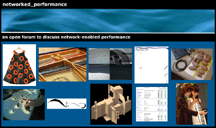
Music, Sound and the Networked Performance Blog
"...The concept of the "new" that most of us carry with us is one in which something that has existed (the old) is replaced with something that has come into existence only recently. It's a sort of "either-or" model. Digital media, however, are about intermingling and fusion. They are about "both-and". As a colleague recently remarked, the overlapping of differences [and similarities] that Digital Media allow [makes for] a staggering hybridity of not only art forms but of just about everything amenable to the digital…This activity, however, creates its own ruptures, its own "newness" and unrecognizables.
Is this new? Well yes and no. Anyone familiar with the work of Dick Higgens will remember that while he did not use the word "hybrid," he did identify "fusion," not only as a basic hunger in us all, but as a characteristic of the new arts of his time: He spoke of happenings, for instance, as a three-way fusion between theater, music and visual art. He suggested that "… art performances, so prevalent just now," might be a five way fusion, between theater, literature, music, visual art, and life?"" From Music, Sound and the Networked_Performance Blog [PDF] by Helen Thorington.
Posted by jo at 11:29 AM | Comments (0)
February 02, 2006
Jean Pierre Gauthier at Transmediale 06
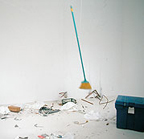
Household Objects Revolt!
Jean-Pierre Gauthier's mobile sound installations express the delights of disorder. He takes daily objects out of their context, rearranges them and sets them going in autonomous movement sequences. Most of the works of Gauthier consist of objects which can be identified, but which do not trigger any emotional or cultural associations. A characteristic feature of his installations is the use of household articles and cleaning products, which may be read as a kind of commentary on prevailing social circumstances. The things make themselves independent, declare revolt and bear a symbolic reference, as a closed microsystem, to aspects of commercial exploitation and economic cycles. In his installation Remue-ménage the artist also succeeds in involving the residual waste of the exhibition's architecture. The analog animation movements of the gadgets lend the installation a faintly antiquated character – an altogether unusual, but deliberately chosen form in contrast to the technological development. At Transmediale 06.
Posted by jo at 03:43 PM | Comments (0)
January 26, 2006
WILD INFORMATION NETWORK:
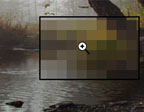
Open Call for Sound Works
WILD INFORMATION NETWORK: The Department of Ecology, Art, and Technology--Open Call for Sound Works In Mp3 Format - Deadline April 1, 2006.
If we encountered a pod-cast, or a streaming radio server in the woods, in the “natural” environment, what kind of information would be distributed? If there was an entity, a life-form, or a “natural” other that disseminated sonic information, wild-information, how would this information sound? This project encourages artists to create audio sound works that imagine the “voice” of the ecological other and explore its translation into the language of digital art technologies.
If “nature” encountered a pod-cast, or a streaming radio server in the woods, in the “natural” environment, what kind of information would be distributed? This project could take on unpredictable, interactive, and experimental dimensions as it also encourages artists to consider themselves as human animals, beings within “nature” producing sound works for unknowable others, e.g. ferns, salamanders, flowers, mosquito, beetles, flowers, deer, coyotes, bear, water, etc.
WILD INFORMATION NETWORK is a project initiated by Cary Peppermint and The Department of Ecology Art and Technology, a performative collaborative of artists seeking to create works that explore issues that lie at the intersection between new media technologies and the environment.
The project will establish a sonic field of information produced with renewable energy, digital technologies, and ecological imagination. The information will be a continuous, solar-powered series of audio transmissions located relatively deep in the woods of 940 acres in the upper Catskills of New York State. Visitors and hikers to the back woods location will use 802.11 wireless devices, bluetooth-enabled devices, or transistor radios to receive sonic information through digital downloads, and radio transmissions.
This project is made possible by generous support from NYSFA's Decentralization Grant, The Upper Catskills Community Center for the Arts, and The Pine Lake Environmental Campus of Hartwick College.
Posted by jo at 09:20 AM | Comments (0)
January 18, 2006
Datasound Strip
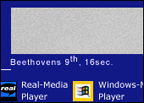
Datasound, the Printed Sound
The idea of sound on paper is not surprising thinking about the codification of the staff on the score. As the same time digitalization has made us used to the fact that data of different nature like images, sounds and words, can be stored through just one code. What is original is the idea of coming back to the original matrix of paper fiber to encrypt information. The Datasound Strip is an 18x55 mm, two-dimensional matrix code, consisting of millions of tiny dots that allow to securely encode thousand of bytes of user data. The code can be decoded using an handled mobile Strip Reader that, placed on the strip, converts the printed data in seconds to its original form Speech and music are played directly over a speaker, while pictures or text are downloaded to a connected PC. The system uses Advanced Audio Coding technology, one of the newest data compression techniques. The key applications are in security, but the most lively ones seem to be in promotion. With the Datasound it is possible to make paper or similar materials talk. This allows in-store promotions, coupons and marketing games, as well as it can make catalogues and packaging more lively and interactive. Waiting for the the first hack that would completely detourne it... [Valentina Culatti, neural]
Posted by jo at 12:41 PM | Comments (0)
MachineAria
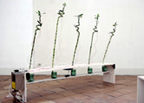
The Poetic Breath of the Machine
Why a plant equipped with electronic elements inserted on the stem become a poetic creature? Why and through which procedures objects in current use become meaningful channels vehiculating personal stories? MachineAria is an installation by Ruben Coen Cagli, that tries to solve the question, asking the visitor to have a contemplative experience of a hybrid ecosystem build up on modified electromechanical plants. Five plants are connected to five little motors, placed under the pots, and to the led arrays on the stems' top. The motors turn on and off sequentially, enabling the the vegetables' vibrations. They sway giving the impression of being caressed by a light breeze. So the air, a traditional and excellent element for inspiring poetry, takes shape thanks to the pure technological fiction. Actually everything can be potentially transformed in a stream of data, but only for humanizing it afterwards, in this case recreating the breath / caress sensation for the user. The idea of activating mechanical processes and then converting the generated data in sensorial experiences, rise from the will to explore all the possible alterations and extensions of technology in daily life. What happens then is skidding from the technological domain to the poetic one, where the latter is essential to the development strategies of innovation. [Francesca Tomassini, neural]
Posted by jo at 12:36 PM | Comments (0)
January 13, 2006
Singing Bridges

Played Cables
Singing Bridges, by Jodi Rose, is a sonic sculpture, playing the cables of stay-cabled and suspension bridges as musical instruments. To create this work I will amplify and record the sound of bridge cables around the world. Listening in to the secret voice of bridges as the inaudible vibrations in the cables are translated into sound.
An urban sound-scape that reflects the physical and metaphoric structure of the telecommunications network, with its fibre-optic cables circling the globe. The iconography of the bridge cables echoes the telecommunications lines stretching across the globe and linking us together. The work plays on an acoustic extension and interpretation of the constant flow of information and data through these cables.
In the ultimate realisation of this idea, bridges at locations around the world are linked and played in real-time to create an International Bridge Symphony. As the Bridges are connected through the sound of their cables, they create an Acoustic Indra's Net.
The cables of the bridge also reflect the vaulting in a church, designed to lift the spirit of the congregation to heaven with the vibrations of the choir's singing. A metaphor for spiritual communication, the bridge cables arching skyward have the potential to lift the commuter to a higher plane.
The project offers a re-interpretation of the familiar architecture of concrete and steel into an experience of metaphysical connection. Allowing for the possibility of a transformative experience of the bridge, other than the everyday pragmatic, economic and visual encounters with architecture.
The sound of singing bridges all around the globe may also strike the resonant frequency of the earth's materials and dissolve the world. Echoing the Tacoma Narrows Bridge, which was freed from material constraints when the resonant frequency was struck by the wind. Sounding the harmonic frequency within the unheard vibrations of the cables will release the voice and liberate the spirit of each bridge.
Posted by jo at 06:16 PM | Comments (0)
January 10, 2006
NYSoundmap
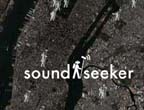
Mapping New York City
Maps are tools for understanding the world from different points of view - political, cultural, personal, and historical. Maps hold the power to shape the truth about the world and mapmakers shape the future. The NYSoundmap is a container - a concept or idea to hold many types of processes and projects. The project reaches across the city's geographic, economic, educational, cultural and racial divides. It is at once a historical record and a subjective representation of the city. It is what each user wishes it to be and it is ever growing, ever changing and totally interactive.
SOUND-SEEKER: What kinds of sounds can you find in New York City? With sound-seeker, you can zoom, pan and search for sounds with interactive satellite photos or detailed maps. Click on hot spots to listen to the recorded sounds of a location pin-pointed by GPS. Sound-seeker was created using GoogleMaps and isn't viewable in all browsers.
CITY IN A SOUNDWALK: Composer Michelle Nagai proposes an augmented experience of the urban soundscape. Begin with the physical practice of the soundwalk. Then add personal narrative, lively opinion and debate, images, historical context, socio-economics, culture, sound recordings and environmental data...
PROTEST, TRANSPORT, CELEBRATE: What did New York City sound like 30 years ago? Artist Andrea Callard lets you hear city sounds she recorded in the 1970's. Listen to chorus of truck horns as hundreds of striking truck drivers came out of the Holland Tunnel and over the Manhattan Bridge into Brooklyn on July 1, 1979 and the sounds of the downtown churches ringing their bells to celebrate the first 200 years of the U.S.A. on July 4, 1976.
GIANT EAR ))): The last Sunday of every month, NYSAE hosts a webcast radio show called Giant Ear))) from 7-9 PM at Free103point9. Shows feature a wide range of recordings including: Transcedental Sounds: Bells, drones, glossolalia and other otherworldliness of the everyday, Get Yer Cans On! A Headphonic Trip Around the World, recordings of the RNC Protests in 2004 and What does freedom sound like to you? interviews with brokers at the NY Stock Exchange.
The NYSoundmap project officially launches January 10, 2006 on Rhizome and Free103point9 as part of Surge, an online exhibition of web-based projects.
Posted by jo at 05:52 PM | Comments (0)
December 18, 2005
Silence of the Lands
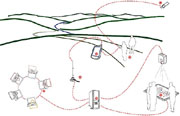
Shared Individual and Collective Sound Cartographies
Silence of the Lands enables participants to collect ambient sounds, then to create and share individual and collective cartographies. These sounds represent subjective interpretations of the soundscape of the urban or natural settings that affect the everyday life of the community, and act as conversation pieces about natural quiet.
1. Data catching: ambient sounds are collected using a PDA. The sounds are linked to the person that collected them, and associated to GPS data; 2. Data description: the sounds are then stored in a database, visualized on a GIS map, and made available for audio-streaming in the web community as individual soundscapes. Participants can access, manage, and eventually modify their own individual soundscapes, associating to them several descriptors; 3. Data interpretation: participants can interact with the collective soundscape. By playing with physical objects in an interactive environment, participants are encouraged to interpret the collective soundscape and create an idealized, virtual one.
A project by Elisa Giaccardi in collaboration with Gianluca Sabena, Hal Eden, and Gruppo Sfera. Currently under development at the Center for LifeLong Learning & Design, University of Colorado, Boulder. Related: Streetscape. [blogged by Regine on we-make-money-not-art]
Posted by jo at 05:57 PM | Comments (0)
December 12, 2005
Ruark Lewis and Rainer Linz
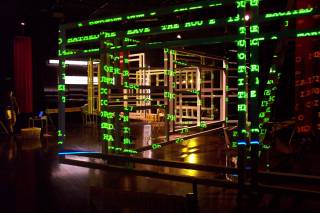
Banalities for the Perfect House
Banalities for the Perfect House--by Ruark Lewis and Rainer Linz--is a collaborative installation & performance work premiered at Sydney's Performance Space theatre on Sept 9 2005. The work proposes the house as a condition through which we perceive the world - the city an extension of grid-like structures viewed through the "frame" of an open window.
Performance texts are distilled from everyday sources including newspapers, cookery books, and snippets of overheard conversation. They consist of seven Banalities: Banalities for the Perfect House, Banalities for Napoleon, Banalities for the Modern Kitchen, Banalities for Solid Mandala, Banalities for Newspapers, Banalities for the Times and Misreading Barricades.
The texts are inscribed on all architectural surfaces, and take the form of performance scripts as well. These include cards, looseleaf and bound pages, and word sequences printed on ticker tape.
The sound is performed on five computer terminals and distributed through a 4-loudspeaker sound system. It is performed using real-time computer processing of original vocal samples, in turn derived from the written texts. The computer sound-generating software was purpose-written for the piece.
The performance space is arranged with wooden frames, boards and barriers resembling, in abstract form, a housing construction site. Each surface is rendered with text creating an immersive environment that can literally be read, and heard as speech.
The work is built around a series of duet and solo performances. Each is based on an individual text, which is the common basis for both the computer and vocal renditions.
The Perfect House is a construction site for ideas, with performers and audiences traversing it as if through rooms made from words whose meanings, too, are still under construction.
Posted by jo at 12:36 PM | Comments (0)
December 09, 2005
SoundTransit

Plan a Sonic Journey + Share Sounds
SoundTransit is a collaborative, online community dedicated to field recording and phonography. On this site, you can plan a sonic journey through various locations recorded around the world, or you can search the database for specific sounds by different artists from certain places. If you are a phonographer, you can also contribute your recordings for others to enjoy. The Creative Commons Attribution license encourages the sharing and reuse of all sounds on this website.
Phonography is the art of recording sounds from the environment around us, with an emphasis on the unintentional sounds which often go unnoticed in our daily lives. An international community of phonographers collect and share their recordings...[The] community gets together largely through a website, a Yahoo group and via recordings on various labels such as Seattle's and/OAR records.
On the "Book" page, users can create a SoundTransit by choosing a location of departure and arrival, as well as several stopovers along the way. Based on your selections, an intinerary with details about the selected sounds and a soundfile are generated, which can be downloaded as an MP3 or sent to friends.
SoundTransit began with the project "Phonographic Migrations #3 Soundscape-FM," which was exhibited at the Garage Festival 2004 in Stralsund, Germany. This was followed in 2005 by the "Berlin.Soundscape-FM" website for Transmediale. For both projects, various artists were invited to contribute recordings made either all over the world [soundscape-fm] or within the city of Berlin [berlin.soundscape-fm]. These recordings were made available as an online database, a local FM radio broadcast and a webstream.
SoundTransit is inspired by the "Phonographic Migrations" series, coordinated by Yannick Dauby and Dale Lloyd and published on the labels and/OAR and Tiramizu. These projects enable participants to share sound information about their environments through divergent channels, and consequently to enact a collective soundscape that is materialized into a publication or a public event, physical or on-line. There is no copyright on the "Phonographic Migrations" concept, and anyone is free to initiate a similar project.
Posted by jo at 11:55 AM | Comments (0)
December 07, 2005
My Beating Heart

Heartbeats in Sync
My Beating Heart--by Yury Gitman--is a soft huggable heart with a soothing heartbeat you can really feel. When hugging the heart, the tactile heartbeat reminds you of holding a pet or a loved-one. Hold the heart a moment and you'll begin to sense your own heartbeat slowly syncing with My Beating Heart's carefully designed rhythm. My Beating Heart is designed to help you relax, daydream, meditate, and nap.
Each "Beating Heart" is handmade in New York and is of museum quality. The use of only the highest quality materials makes for an experience that will last for years. Select a style that looks most cuddly to you.
Posted by jo at 06:17 PM | Comments (0)
December 06, 2005
On The Road: A Kerouac Circus

Transform a Book into a Performance
On The Road: A Kerouac Circus is a mixed-media event based on Jack Kerouac's classic American road-trip novel, using a set of procedures created by American composer John Cage to "transform a book into a performance."
Organized by Marc Thorman, the On The Road: A Kerouac Circus web site is part of a project to gather ambient sounds (sounds that happen to be in an environment) from locations mentioned in Kerouac's "On the Road" in order to create a sonic portrait of the big cities, small towns, backwoods, deserts and mountains that Kerouac visited and wrote about.
The project invites you to represent a location in the US, Mexico, or elsewhere by uploading a sound file for the mix of recordings that will be played during the performance.
You and/or your organization will be credited if you wish. (Hard copies -- CD's/flashcards -- can be sent by mail.) These sounds will be mixed with fragments of bop, folk, jazz and mambo recordings, vintage film clips, and live performances to create a "musicircus," the term Cage coined to describe an event in which many independent sounds and sights occur simultaneously and interact freely.
To participate, record ambient sounds (sounds that happen to be in the environment) at an urban or rural location listed on the locations page. These can be sounds of traffic, birdsong, wind, machines, footsteps, water, etc. This isn't a contest for "interesting" sounds -- ALL ambient sounds are welcome. You can choose to record at a specific site that is representative of the location, or choose a site by chance. Collect whatever sounds are there without knowing beforehand exactly what they will be.
Background
John Cage invented a new type of mixedmedia theatrical event, using chance combinations and multiplicity to reflect the way we experience the everyday world. In such a "musicircus" the elements--poetry, sound, dance, music--are created independently and then, like a three-ring circus, performed simultaneously. Cage's philosophy was that the chance combinations and multiplicities that arise from a musicircus are more interesting, and truer to our everyday life, than fixed relationships intentionally imposed by one individual.
In "_____ Circus On ____" Cage established a set of procedures to "transform" a book into a musicircus. The first "Circus On" was Cage's own "Roaratorio, An Irish Circus On Finnegans Wake." As Cage recited his poem taken from Joyce's novel, recorded ambient sounds from Ireland and around the world played through multiple speakers, Irish musicians played traditional instruments and sang, and dancers performed Merce Cunningham's choreography based on Irish dance. [Mode Records has recently re-issued the recording of "Roaratorio" with a comprehensive booklet containing an interview with Cage and a detailed explanation of each stage of the work.]
Applying Cage's procedures to "On The Road" creates a distinctly different musicircus, filled with sounds and images of cars, railroads, Americans towns and cities, be bop, old movies, mambo, cornfields, Sierra Madres, swamps, and prairie winds. The structure follows Kerouac and Cassady as they crisscross America from New York to San Francisco/L.A. and then drive through the South and into the roaring boulevards of Mexico City. The poem for the musicircus, composed entirely of word fragments from the book, reflects Kerouac's spontaneous prose rhythms and American speech patterns. Live performances, to be combined with the reading of the poem and the mix of sounds, come directly from the pages of the book--at various times during the performance (sometimes overlapping by chance) a DJ spins jazz tunes, dance couples swing and mambo, a bop trio blows, a folksinger sings "Halleluiah I'm a Bum" and clips from movie scenes are screened. Other live performances may include strolling guitarists singing Mexican songs, a nightclub singer, and an operatic tenor's a capella rendition of "Gott! Welch Dunkel hier!" from Fidelio.
Posted by jo at 02:44 PM | Comments (0)
December 05, 2005
Girls Ambient Room
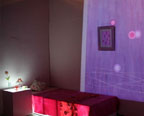
Quiet Please!
Girls Ambient Room uses sound, music, animation & light projections to visualize information at the periphery of human perception by subtly & artfully displaying personal communication data. The room was specially designed for Taiwan teenage girls, reflecting their aesthetic, their taste, & their values.
data is gathered from different chat services, email & comment entries to their personal online journals. when the user (the Taiwan teenager) is in her room & receives a message on MSN chat, she hears audio signals that are in tune with one another, & sees bubble-like visual animations are created on the wall. Email traffic is represented by lines on the screen which start to animate & vibrate. the more email the more vigerous the animations. [blogged on information aesthetics]
Posted by jo at 12:42 PM | Comments (0)
December 01, 2005
Paul Geluso
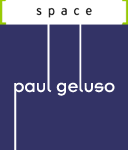
Homage to a Site
New York based sound artist and composer Paul Geluso creates a site specific multichannel installation with seemingly abstract processed sounds, devoid of recognisable musical form. Each channel plays sound textures at different lengths; as time goes by the relationship between the sounds drifts apart, inviting the site’s ambient sounds into the ephemeral moment. The familiar and the unknown are infinitely juxtaposed.
A sound narrative takes form through sampled sounds from the site, relating to its past and present, its regeneration and transition. Sensations of the site’s unique spatial dimensions and appearance are heightened and while walking around defining the sounds, the participants create their own individual soundscape, their personal mix. Scenes change as inner spaces and memories are discovered.
Homage to a Site, 2005 by Paul Geluso; A newly commissioned site-specific multichannel sound installation; Curated by Berit Fischer. 1 December 2005 – 7 January 2006; Private View Wednesday 30 November, 6-8pm; Open: Wed-Sat, 1-6pm or by appointment
SPACE, 129-131 Mare Street, London E8 3RH; Tel 020 8525 4330 Bus: 26,48 from Liverpool St,106 & 254 from Bethnal Green, 55 from Old St.; Tube: Bethnal Green Train: Hackney Central Silverlink
RESONANCE 104.4 FM Broadcast: Thursday 1 December, 4.45pm.
ABOUT Paul Geluso
Paul Geluso achieved his Master Degree in Music at the New York University. Since 1999 he has been composing electro-acoustic music and sound scores for j mandle performance, a New York based experimental arts organisation that creates site specific performances in unexpected locations with the intention to heighten the public’s perception of its everyday environment. His electronic music compositions have been presented at major institutions in New York City including The New Museum of Contemporary Art, Cooper- Hewitt School of Design, The Storefront for Art and Architecture and Gale Gates Et Al.
Geluso is a full time lecturer of audio art at New York University and State University of New York at Oneonta. As audio engineer he has worked at Harvestworks Digital Media Arts with artists like Vito Acconci, Marina Rosenfeld, Christian Marclay, Phil Niblock, Stephen Vitiello who use sound in their creative work. He has mastered and mixed award winning films and performed on many albums. Recent awards include the individual artist grant in composition from New York State Council on the Arts, the John E. Robinson Foundation and Meet the Composer.
Homage to a Site will be his first solo show in the UK.
For further information please contact Berit Fischer: :beritf[at]excite.com Tel: 079 3179 3315
Posted by jo at 12:53 PM | Comments (0)
November 28, 2005
Hydrophonics + Radiator Symposium
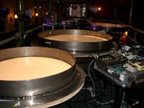
Exploring Different Approaches to the 'Live Event'
A live webcast of sound from the other side of the world to the surface of water. The innovative concept of Hydrophonics stems from Locke’s fascination with technology, waterflow, the idea of ‘seeing sound’, of visualising kinetic energy and exploring different approaches to the ‘live event’. Over the past four years she has experimented widely by sending a variety of sounds through water to see the different formations each sound makes on the water surface.
Locke has worked with musicians to compose music based on the sight of the composition, rather than the sound of it, and developed new designs for water tanks and speaker systems. The Sonic Arts Group at Monash University will be playing and developing music especially for the event. This will be sent across the world to the water tanks in the UK where the audience will experience the ripples and fountains on the surface of the water. Hydrophonics is part of the Radiator and Digital Cultures SYMPOSIUM.

2 - 4 Dec 2005 Nottingham / Fri & Sat 10am - 6.30pm / Sun 10am - 4pm: This three day international symposium aims to bring into focus artistic practices of live performance that make use of digital technology in the form of lens-based, networked or locative media.
On a global stage, artists from different geographies can enter transcontinental collaborations raising the question of how the digitisation of the arts has transformed cultural traditions and practices. The symposium will bring together leading practitioners, developers, scientists and theorists from the disciplines that make up new media performance including live art, locative and pervasive media, telematics, performance and dance, wearable, sensor based and cybernetic technologies. CONTACT: Nina on Tel +44(0)115 840 9272 info[at]radiator-festival.org
Posted by jo at 12:47 PM | Comments (0)
November 23, 2005
Living Wall

Network of Sonic Memories
Living Wall--by Åsmund Gamlesaeter and Alexander Berman--is an installation collecting, recomposing and playing sonic memories. The computational processes that take place are displayed on 3000 white LEDs. Microphones record fragments of human interaction. Each fragment is then analysed using an adaptive sound categorization technique, determining its relation to previously stored clips.
The network of sound clips is reorganized in real time as new fragments are recorded and connections between previously stored clips are elaborated. Fragments with similar perceptual qualities are grouped in clusters and dissimilar clips are separated from each other. As time goes by the network evolves into a rich mass of information with complex interconnections.
Recomposed sequences of sound are played back into the space by walking through the network of sonic memories. The sounds are distributed into the space based on a mapping from the network position to a position in the room. For the developers, this behaviour is parallel to the behaviour of how we associate ideas. Living Wall is a permanent installation at Studentersamfundet in Trondheim, Norway. [blogged by Regine on we-make-money-not]
Posted by jo at 11:18 AM | Comments (0)
November 21, 2005
Dots And Lines

Online Sound Composition: What's Become of the Score?
The online Dots And Lines exhibition uses the networked space of the web to interrogate the subjects of the score, notation and visual data as core elements in the process of composition.
A great deal of sound art work using new technologies uses programming environments and algorithmic systems to generate compositions. Generative sound approaches have allowed musicians and programmers to develop new interpretations of duration and construction. The evolving processes and surfaces made possible by algorithmic sound softwares form new concepts of both the composer and the score. The primacy of the composer is often obscured in favour of a symbiotic relationship between the musician and the software. In this context, what has become of the score?
-Can a score be said to exist within a software driven music environments?
-Are the visual interfaces examples of a new scoring system?
-Is the code used to programme generative sound software the new score?
Artists/Works:
Laura Baxter & Simon Yuill (UK) - PET_00 (2004)
As with many of the selections in Dots & Lines, PET_00 is a visual music system, which allows users to compose new pieces of music. Users are confronted with a simple set of visual objects which can be moved around in order to stimulate musical compositions...
boredomresearch (UK) -Springtails (2002)
Springtails is a colony of 'electronic insects' that react when touched by a user's cursor. As they catapult around their environment, the insects strike chimes, and in effect, compose an incidental sound piece...
Alessandro Capozzo (Italy) -Ad Libitum (2004)
This project is an online sound environment which uses a series of visual patterns - dots and lines - to represent, or notate, an automated music composition.
Joe Gilmore & Tom Betts (UK) - rand()% (2003)
rand()% is an automated net.radio station streaming generative music created by audio artists, musicians and software programmers. The name is taken from the code of the computer language C++.
rechord (UK) - Cubop (2002)
Cubop is both instrument and composition environment, allowing users to construct music from sounds recorded from rare instruments, including the world's only electric kora, a delicate-sounding African lute.
rigasZieds (Latvia) - daarzs (2002)
Daarzs presents us with a highly original visual notation system. These animated visual and sonic works appear like fusions of science diagrams and artistic doodles.
Stanza (UK) - genomixer RNA (2003)
RNA is part of a larger series of online works, which also include junker , geno , genomixer , and mutator . These works enable online visitors to intermix or breed their own works, using visual and sonic interpretations of DNA sequences.
tinhoko (Austria) - rhapsody (2005)
Part interactive story, part audiovisual tool, Rhapsody is a new work created for Dots & Lines by Austrian artist, Tinhiko. In this work the artist presents us with the concept of non-linear story telling as the score.
U-Sun (UK/Australia) - Segment Yield (2002)
Segment Yield is comprised entirely of microscopic particles which manifest visually and sonically. These particles follow the movement of the user's cursor creating patterns of dotted lines. The simplicity of the visual system belies its metaphoric dimensions.
Posted by jo at 04:05 PM | Comments (0)
November 15, 2005
Sine Wave Orchestra

Audience Synchs Waves of Sines
Utilizing sine waves - sound without any distortion and representing a single frequency - the members of the Sine Wave Orchestra carry out performances in which the public participate.
Anyone can take part to it if he/she can produce a sine wave. The performance is carried out in a place with all the participants concurrently. Each participant produces only one sine wave. The sine waves, which are the simplest elements of sound, arise from each speaker and are interfered in the real space. Then, the sea of sine waves will appear.
So far, people were mainly using laptops. During the Yokohama Triennale, TSWO will hold participatory performances six times during the Triennale. Each participant is asked to hold an i-pod that is emitting the sound based on sine wave. Depending on where each performer is standing in the space, the sound will be in various degrees of synch. After the performance, i-pods are installed inside the warehouse. [blogged by Regine on we-make-money-not]
Posted by jo at 08:50 AM | Comments (0)
November 09, 2005
INFRActures
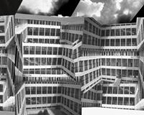
Transcending the Sensory Perceptible
INFRActures is an exhibition project transcending the sensory perceptible at the convergences of sound art and architecture. Artists Edwin van der Heide, Cevdet Erek, mxHz.org and STEALTH.[u]ltd have been commissioned to create four new works which make tangible what is not registered by our senses within an urban environment, such as ultra- and infra-sonics, and different perceptions of time and spatiality. Cities as Rotterdam and Istanbul make up the source material and points of departure for the installations, which are interactive in character and allow for a participative and layered audiovisual experience.
* Edwin van der Heide: Sound/Light/Street * STEALTH.[u]ltd: Street/Appropriation/Struggle * Cevdet Erek: Avluda | In The Courtyard * mxHz.org: TICS [THIS INAUDIBLE CITY SOUNDS: Reading through Pamuk's Istanbul]
Date: Friday 2 to Sunday 18 December 2005
Curator: Nat Muller in collaboration with Stephen Kovats
INFRActures has been made possible with the support of ThuisKopie Fonds, Stichting Cultuurfonds van de Bank Nederlandse Gemeenten, VSBfonds and Prins Bernhard Cultuurfonds Rotterdam.
TANGENT_FRACTURE (INFRActures vernissage)
Date: Thursday 1 December 2005, 17:00-19:30 hrs
Location: V2_, Eendrachtsstraat 10, Rotterdam
Admission: free
The exhibition is inaugurated by an opening intervention of artist and architect Kyong Park, and framed by two live sound performances of sound artist Cevdet Erek and media artist mxHz.org, taking you beyond the boundaries of the audible. The INFRActures vernissage is the first in V2_'s new series of monthly TANGENTS live and interactive streamed events.
laurie halsey brown: beingthere.v2.r'dam.05
Date: Sunday 18 December 2005, 15:00-17:00 hrs
Location: V2_, Eendrachtsstraat 10, Rotterdam
Admission: 5 euro (seating limited!)
Many Rotterdam architects tend to leave the city due to a shortage of local projects. Rotterdam profiles itself as a city of architecture but how does this image chime with everyday reality? Artist laurie halsey brown organizes during the finissage weekend of INFRActures a bus tour through the city that includes an onboard experimental documentary of local architects discussing the validity of the city’s slogan “The City of Architecture”, with stops at several sites built by local architects and access to a public intervention project placed throughout the city. The tour begins and ends at V2_
V2_, Institute for the Unstable Media
Eendrachtsstraat 10, NL-3012 XL Rotterdam
PO Box 19049, NL-3001 BA Rotterdam, NL
Tel + 31 10 206 72 72 | Fax + 31 10 206 72 71
E-mail info AT v2.nl
Posted by jo at 10:07 AM | Comments (0)
November 08, 2005
HER NOISE
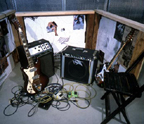
Sounds Investigate, Inspire, Uncover
Her Noise is an exhibition featuring five newly commissioned works by international artists whose practice shares the use of sound as a medium to investigate social relations, inspire action or uncover hidden soundscapes. New works by Kim Gordon with Jutta Koether; Emma Hedditch; Christina Kubisch; Kaffe Matthews and Hayley Newman all involve high levels of participation and are set in motion only when used by visitors or performers forming a base for events, live music and performances. [review]
In Reverse Karaoke [AuToMaTiC mUsIc TeNt] Kim Gordon and Jutta Koether aim to demystify the process of music making by creating a space in which audience members can record a track along with the pre-recorded sample of Gordon’s voice. The installation doubles as a performance space for a series of performances including Jenny Hoyston (Erase Errata), Heather Leigh Murray, Christina Carter, Ana Da Silva (The Raincoats).
In her installation Mini Flux Hayley Newman reproduces, in miniature, over a thousand objects used in the Sixties Fluxus movement's musical scores. The installation becomes a score in itself through Newman's invitation to guest artists to devise performances using the objects. Guest artists include The Bowman Brothers, Gluzberg and Bruce Gilbert.
Christina Kubisch has for many years been developing electrical walks which make audible the otherwise undetectable sound waves generated by the electromagnetic signals that surround us. Visitors are invited to navigate Kubisch’s maze of wires at South London Gallery, containing sounds from city walks using the specially designed headphones. Across town, visitors can pick up the headphones from the Goethe Institute to discover the hidden soundscape of the area according to Kubisch’s map.
In We’re Alive, Let’s Meet Emma Hedditch sets up a series of get togethers that will take the form of weekly meetings, workshops and talks with guests including film maker Vivienne Dick, Tobi Vail and Alison Wolfe (of riot grrrl bands: Bikini Kill and Bratmobile).
Hedditch has also collaborated with the show’s curators on the Her Noise Archive which combines a research area, listening posts and a viewing space filled with documentation of both historical and contemporary luminaries working in the field of sound installation and performance. The space contains books, fanzines, records, catalogues as well as exclusive on camera interviews and concert footage with artists including Pauline Oliveros, Maryanne Amacher, Diamanda Galas, Marina Rosenfeld, Thurston Moore, Kevin Blechdom, Kembra Pfahler, Kim Gordon, Lydia Lunch, Peaches and many others filmed in the process of developing Her Noise and aimed at forming a research archive which will become publicly accessible in London after the end of the Her Noise tour.
While lying on Kaffe Matthews Sonic Bed Laboratory the visitor becomes physically affected by a spectrum of sound vibrations shifting underneath and around as they lie. The 12 channel sound system immersed in the bed plays a specially constructed sound work, vibrating through and moving around the visitor. Sonic Bed Laboratory plays music to feel rather than just listen to.
This exhibition is the largest component of a HER NOISE programme of installations, events, performances and screenings by a wide network of artists whose practice involves the use of sound as a medium.
Curated by Lina Dzuverovic and Anne Hilde Neset, Electra
10 NOV – 18 DEC 2005
South London Gallery
65 Peckham Road
London SE5 8UH
Tel: 020 7703 6120
EXHIBITION CATALOGUE
Her Noise catalogue published by Forma,
Editors: Lina Dzuverovic & Anne Hilde Neset
Artists: Kim Gordon & Jutta Koether, Emma Hedditch, Christina Kubisch, Kaffe Matthews, Hayley Newman, Marina Rosenfeld
Contributors: Jan Avgikos, Christoph Cox, Drew Daniel, Anna Dezeuze, Louise Gray, Alan Licht, Thurston Moore, Rob Young
This catalogue forms an invaluable resource, highlighting the often overlooked contribution of women artists to the development of genres as disparate as Fluxus, performance art, punk and sound based installation. Through a wealth of images, essays and interviews the catalogue explores how the energy of independent music communities and open-access composing techniques can reinvigorate the exhibition environment.
All texts in English / 230mm °— 170mm, 68 pages, soft cover, illustrated colour throughout. ISBN: 0-9548288-1-X
Distributed by Cornerhouse Publications
Published by Forma forma.org.uk
South London Gallery
65 Peckham Road
London SE5 8UH
http://www.southlondongallery.org
Tel: 020 7703 6120
Her Noise is curated by Lina Dzuverovic and Anne Hilde Neset and produced by Electra (http://www.electra-productions.com) in association with Forma (http://www.forma.org.uk). The project is funded by Arts Council England, PRSF, The Henry Moore Foundation, The Elephant Trust, Women In Music, Feminist Review Trust with additional support from The Goethe Institute and Tate Modern. Media partner: The Wire Magazine.
Posted by jo at 09:35 AM | Comments (0)
Ultrasound 2005
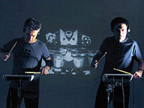
UK | Finnish Partition
Mon 21 - Sat 26 Nov 2005, The Media Centre and Bates Mill, Huddersfield, England. Ultrasound 2005 presents a diverse programme of live performances, installations, workshop and talks by UK and international artists working in new interdisciplinary ways across the interrelated fields of new media, contemporary electronic music, software production, new technologies and audiovisual performance.
We are pleased to announce the 'Finnish Partition' of the festival, programmed in collaboration with Helsinki based artist, organiser and curator Juha Huuskonen. The 'Finnish Partition' represents a cross-section of the new and emerging creative talent practising media arts in Finland today, supported by established names such as Pan Sonic.
The festival takes place at The Media Centre and Bates Mill, two contrasting venues. The Media Centre is home to over 60 creative industries enterprises, while Bates Mill is a traditional Mill complex just outside Huddersfield town centre. The performances at Bates Mill are located in the old 'Blending Shed' a 5,000 sq ft industrial space.
Ultrasound Outline Programme:
Live Performances
Pan Sonic [Finland]
http://www.ultrasound.ws/pan-sonic.html
Grey Zone [Finland]
http://www.ultrasound.ws/greyzone.html
Memnon [Finland]
http://www.ultrasound.ws/memnon.html
Sue Costabile [USA]
http://www.ultrasound.ws/costabile.html
AGF [Germany]
http://www.ultrasound.ws/agf.html
Aymeric Mansoux [France]
http://www.ultrasound.ws/mansoux.html
O Samuli A [Finland]
http://www.ultrasound.ws/oa.html
Marloes de Valk [Holland]
http://www.ultrasound.ws/de-valk.html
Owl Project [UK]
http://www.ultrasound.ws/owl-project.html
Jaap Blonk [Holland]
http://www.ultrasound.ws/blonk.html
Golan Levin [USA]
http://www.ultrasound.ws/levin.html
Zachary Lieberman [USA]
http://www.ultrasound.ws/lieberman.html
The World of PIKU [Finland]
http://www.ultrasound.ws/piku.html
Pardon Kimura [Japan]
http://www.ultrasound.ws/kimura.html
The Sancho Plan [UK]
http://www.ultrasound.ws/sancho-plan.html
Installations
Scrollbars by Jan Robert Leegte and Edo Paulus [Holland]
Kick Ass Kung-Fu by Perttu Hämäläinen, Mikko Lindholm, Ari Nykänen [Finland]
Workshop
Tiletoy: A Modular Electronic Game Prototype by Tuomo Tammenpää & Daniel Blackburn [Finland/UK]
Open software/open hardware: TileToy is an open project. Both the source code and the hardware will be made available via open licenses. The aim of TileToy is not just to create something that we ourselves can use to create interesting games and demos for, but as a platform that anyone can use to create unique content. Making the software open will allow people to create their own applications and games and feed these back into the community to spark further innovation. The open hardware will also allow people to make their own TileToys cheaply without paying a third party potentially leading to new projects that branch off to make new versions of TileToy based on the original hardware.
Further additions to the programme will be announced soon. Please visit the website or sign up to the electronic mailing list.
Contact: Tel: +44 [0]870 990 5007
Email: info[at]ultrasound.ws
Posted by jo at 08:35 AM | Comments (0)
Proximity Lab
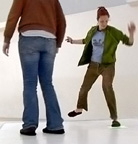
Footprints
Proximity Lab is a participatory installation and experimental interface platform designed to visualize relationships between users and mediated spaces. The 8-foot by 16-foot walkable surface is fitted with RFID technology. Participants wear shoes fitted with RFID tags, enabling the system to track and record their positions in real-time. Images projected directly onto the floor are accompanied by stereo sound as a continuous response to the actions and interactions of participants.
Proximity Lab can discern the individual identities of participants regardless of how or where they move. Conceived as an experimental physical interface system, it allows architects with diverse intentions and aesthetic goals to create repeatable experiments in physical interaction. By Evan Karatzas. [blogged by Regine on we-make-money-not]
Posted by jo at 08:15 AM | Comments (0)
November 07, 2005
Mice squeak into song
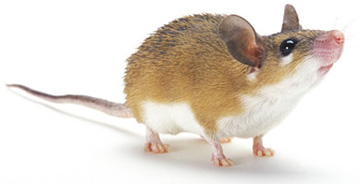
© 2005 Nature Publishing Group
Male mice produce songs to woo their mates that are too high-pitched for humans to hear. Click here to listen to mouse vocalizations processed by computers into an audible range for people. Read article here.
Posted by jo at 09:20 AM | Comments (0)
November 04, 2005
The Air Around
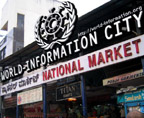
Invitation to Air Your Voice
Rajivan.Ayyappan invites you to contribute to his sound installation--The Air Around--from your geographical location.
"The Air Around is a radio/telephonic installation. It's made of an FM network that receives sounds through telephones—mobile, landline or internet phones—from around the world and integrates them into a soundscape. The installation has a central computer with a list of participants and their phone numbers. It would dial a number, remain open to engage the participant, hang up after a period of time, start another number and so on. These interactions would be transmitted to the The Air Around installation site.
The central theme of The Air Around is this: Access a whole lot of people who are in different locations and time zones through the internet and integrate them, live, into the new context of a synthesized soundscape installation. Our plan is to have a list where as many people are ready to take the call.
Therefore I want you to be in The Air Around's list to receive a call from the installation. What I would like to have from you is a 30 sec to 3 or 4 minutes of sound event that are voiced, played back or performed online by you. There are no rules for what you must do. Strictly no rules. You can just pick up the phone, identify your number or name and behave as if you have a microphone in hand. Your interaction with the call will be one of the sound events in the installation. It will be transmitted at The Air Around site.
The Air Around installation will be active for 3 days, 3:00pm to 6:00pm (India. Standard time zone: UTC/GMT +5:30 hours) starting 14th November and ending on 16th November 2005.
If you are keen tell us the dates & times when it would be possible to call you. The call will be made from the installation, to your land line or mobile. You will not be charged with any phone call rates. It will be paid by The Air Around project. Please mail me for clarifications and planning. I could send you more details regarding the procedure. Love to hear from you." Rajivan.Ayyappan rajivansa[at]hotmail.com
The installation is a part of World-Information City conference, organised by Waag Society (Amsterdam), Institute for New Culture Technologies (Vienna), Sarai CSDS (Delhi), Mahiti and Alternative Law Forum (Bangalore). [Related]
Posted by jo at 10:27 AM | Comments (0)
4Pieces for Object, Sound, Space and Body -
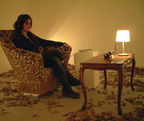
'Radio,' 'Window,' 'Metronome,' 'Darkness'
Akitsugu Maebayashi's new sound installation 4Pieces for Object, Sound, Space and Body - 'Radio,' 'Window,' 'Metronome,' 'Darkness,' is now exhibited at NTT ICC Museum in Tokyo. Looks like it's based on Radio Room (photo).
When you sit and wear a headphone in Radio Room, you start hearing sound from the radio in front of you. Then you start hearing the sound of leaves on the floor, and now you realize you are listening to the sound from the trees outside the room. The careful design of the sound space provides a unique multimodal experience...His installation is part of the exhibition called Possible Futures: Japanese Post-War Art and Technology.
Nikkei recently wrote a nice article summarizing Maebayashi's works including: Radio Room, Disclavier, Audible Distance, Sonic Interface, [I/O] white room, [I/O] warehouse, [I/O] distant place, Velocity, and Motto Darwin. If you want, check out the article to at least see various photos. [blogged by manekineko on we-make-money-not]
Posted by jo at 09:15 AM | Comments (0)
November 02, 2005
Sal Randolph
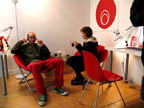
Opsound and Whereyouare
Last night at Upgrade! Boston, Sal Randolph presented two projects, Opsound and Whereyouare. Opsound is a gift economy in action, an experiment in applying the model of free software to music. Musicians and sound artists are invited to add their work to the Opsound pool using a copyleft license developed by Creative Commons. Listeners are invited to download, share, remix, and reimagine. Opsound is currently installed in the Glowlab: Open Lab exhibition at Art Interactive.
![]()
Whereyouare is an experiment in the collective documentation of neighborhoods. Randolph began the project with the idea of documenting her own neighborhood, Williamsburg, Brooklyn, whose quirky and ephemeral beauties are currently endangered by a wave of new development. Everyone is invited to participate by documenting any neighborhood they love. Those with material from neighborhoods which have now been damaged or destroyed by Katrina are especially encouraged to contribute.
Posted by jo at 11:29 AM | Comments (0)
JEFF TALMAN
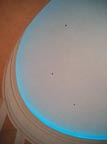
IN TRANSIT
International artist Jeff Talman will mount a new installation--In Transit--in an exhibition that explores the sonic resonance of the InterContinental Hotel atrium. In this site-specific sound work Talman exposes the nuances embedded in the ‘silence’ of the 4-story, dome-capped space.
In Transit features the actual resonant frequencies of the atrium extracted from the room tone or ‘silence’ of the site. Installed in the hotel atrium, the installation feeds the site resonance back into the space. Because the resonance is perfectly tuned to the site it is naturally amplified by the space. The results are a re-resonating sound field in which the inherent sonic ‘presence’ of the atrium itself is brought forward for the listener as intuitive notions of sound and spatial perception are enhanced.
Regarding the title, Talman noted, “We are constantly in transit – moving through spaces – with too many other concerns to spend much time reflecting on where we are, where we have come from, and where we are going. When we do reflect on our surroundings, we acquire the sense of a place largely through visual perception. But our place-sense is also highly dependent on the self-sound of a site, of which we have a much lower consciousness, perhaps only an intuitive grasp. By emphasizing this unique place sound I hope to make available a larger, instinctive sense of site that is fundamental to our perception of the world.”
In the InterContinental Hotel – Chicago, exploring the sound of ‘silence’: NOV. 7 – 13, 2005
Talman’s other new soundspace installation, ‘Absolute Elsewhere,’ which is based on similar properties of site resonance, opens three days later on November 10 in St. James Cathedral, which is near the hotel. The two installations coincide with the Nineteenth Conference of the Society for Literature, Science and the Arts, which is one of the installations’ sponsors along with the University of Illinois-Chicago, and Emerson College, Boston where Talman teaches. He is represented by bitforms in New York City.
Posted by jo at 10:05 AM | Comments (0)
October 31, 2005
Electrical Walks
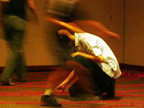
Amplified Currents
Electromagnetic induction is based on the sounds resulting from the mutual interaction of magnetic fields. Audio artist Christina Kubisch developed magnetic headphones with magnetic coils that respond to electrical fields in the environment. At first she tried to filter the hum of the electrical wires out of the headphones. But the increase and spread of "unwanted" electrically-produced sounds inspired Electrical Walks. With special, sensitive headphones, the acoustic perceptibility of aboveground and underground electrical currents is thereby amplified.
The palette of these noises, their timbre and volume vary from site to site. They are ubiquitous. Light systems, transformers, anti-theft security devices, surveillance cameras, cell phones, computers, elevators, antennae, navigation systems, automated teller machines, neon advertising, etc. create electrical fields that are otherwise undetectable.
With the headphones and a map of the area, upon which the especially interesting electrical fields are marked, the visitor can set off for a special kind of stroll in cities. The perception of everyday reality changes when one listens to the electrical fields; what is accustomed appears in a different context. Nothing looks the way it sounds. And nothing sounds the way it looks.
Electric Walks is part of Her Noise, an exhibition featuring 5 installations by artists who use sound as a medium to investigate social relations, inspire action or uncover hidden soundscapes, at the South London Gallery, 10|11|2005 - 18|12|2005. See also the interview of Christina Kubisch in Audiohyperspace. Related: aetherspace, Electroprobes, the Amazing All-Band Radio, etc. [blogged by Regine on we-make-money-not]
Posted by jo at 12:20 PM | Comments (0)
October 24, 2005
Fugue
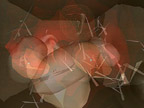
Calibrate an Artificial Immune System
Fugue is the result of a collaboration between artists, new music composer and computer scientists. The result is an on-going project which provides a new way of communicating complex scientific ideas to any audience. Immersive virtual reality and sound provide an interactive audiovisual interface to the dynamics of a complex system – for this work, an artificial immune system. Alongside with providing the greatest immersive effect currently available, this technology offers the potential to control and calibrate particular audio-visual elements.
The aesthetics of the Fugue is emergent, based upon the essential, fundamental and hidden beauty of the organic processes manifested through the dynamics of the real-time generated, unpredictable algorithm. The piece is set up as an interaction between a virtual (artificial) immune system and a human participant. Participants are able to see and interact with immune cells flowing through a lymphatic vessel and understand how the complex dynamics of the whole are produced by local interactions of viruses, B cells, antibodies, dendritic cells and clotting platelets.
The sound, envisaged as a ‘mental soundscape', a resonance of the function of immune system in the body, provides a major channel for interaction. By overlaying and modulating the sonic pulsation, cycles - such as circadian rhythms, or other inputs such as stress level, will be introduced in the future. The Artificial Immune System will ‘inhabit' the virtual space of the master server computer at the CS UCL that will run the Artificial Immune System continually, providing the possibility of being displayed on different interfaces. [via]
Posted by jo at 04:03 PM | Comments (0)
Pieces for Plants
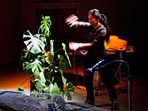
Laptop and Philodendron Performance
Miya Masaoka has worked with Madagascan cockroaches, the electrical signals from the bodies of ten naked Asian men, and the sounds of swarming bees. In Pieces for Plants, a plant’s real-time responses to its physical environment are translated to sound. Highly sensitive electrodes are attached to the leaves of a philodendron. People move their hands around the leaves and hear the plant speak back to them: the voice seemingly the plant’s physiological response to interactions. During the piece, the plant is brought to a range of physical/psychological states, from calm to agitation.
Pieces for Plants suggests that plants have an awareness, are part of our living network of beings, and can communicate with us if we learn how. Versions of the piece have also been presented in a musical setting in which the plant participates as a member and soloist within an instrumental ensemble. For Blur of the Otherworldly, the artist has set the piece free for visitors to navigate other participants’ compositional conversation with the plant and listen to their dialogues. [blogged by Regine on we-make-money-not]
Posted by jo at 11:33 AM | Comments (0)
October 20, 2005
You Say Potatoe, I say Potato
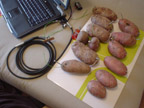
Sonic properties of GM potatoes
You Say Potatoe, I say Potato. In this study of the sonic properties of Genetically Modified potatoes, two research groups try to answer this crucial question: GM potatoes, they may be good for our stomachs, but are they good for our ears? Competing performers decked out in lab coats and safety gear, utilize their respective choice (GM or Organic potatoes) and a set of scientific and culinary tools to explore the sonic properties of potatoes.
The potatoes are used as a power source for the performance by supplying conventional potato battery power. Using zinc (galvanized nails) and copper (thick wire), each potato generates .5 to 1 volt. The individual potatoes can be linked together in serial or parallel to increase voltage and/or amperage. The potato batteries power circuits that generate square waves with varying frequency and intensity depending on the voltage and amperage drawn from the potatoes, which is controlled by the performers by manipulating the battery configuration on the fly. Piezo contact mics are used to process physical interaction with potatoes (i.e. slicing potatoes, grinding potatoes, peeling potatoes, boiling and frying potatoes, etc.) No hint about the the outcome of the experiment. By Sue Huang, Alex Berman and David McCallum. More potato art: Potatoes singing for Denmark. Related: Gameboys powered by lemons. [blogged Regine on we-make-money-not]
Posted by jo at 06:50 PM | Comments (0)
October 19, 2005
Soundwave (III)' and 'The Teleaesthetic Finger'
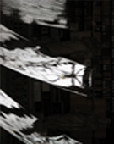
Audible Observation
Josef Albers once said that art is our visual response to the world, to the universe, and to life. Location One's upcoming shows, Slowscan Soundwave (III)' and The Teleaesthetic Finger add acoustics and some mystery to Albers's notion of visual response. In the main gallery, Douglas Repetto's interactive sculpture, 'Slowscan Soundwave (III),' creates 'a simple physical manifestation of complex physical, biological, and social phenomenon.' Awash in motors, electronics and reactive Mylar, the gallery breathes presence into one of the invisible elements that shape our lives: sound. Similarly, the group show in Location One's Project Room, 'The Teleaesthetic Finger,' seeks presence for the invisible; yet these phenomena are less scientific and more extrasensory in nature. Atsushi Nishijima, Kevin Centanni, and Heather Wagner trap sounds of places never visited. The recorded journey of a kite floating out of sight or the signals of inaccessible radio frequencies attempt to capture those invisible, mysterious, but still real parts of our auditory universe. Combined, Location One's shows suggest that our responses to the world, and to life, need observation by more than our eyes. - Alyssa Wright, Net Art News, Rhizome.org.
Posted by jo at 10:20 AM | Comments (0)
October 10, 2005
Found Sound in D.C.
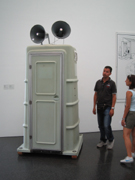
Crisscross a City
[Unrelated photo: a port-a-potty-based public address system at the MACBA, Barcelona, 2005.]
A public art project called FOUND SOUND will be featuring works from artists in sound booths (“reconfigured” Port-a-Potties) on sidewalks in public locations throughout Washington, D.C. from Oct 14-Nov 5. Participating artists include Richard Chartier, Joseph Grigely, Alberto Gaitán, Jennie C. Jones, Helmut Kopetzky, Brandon Morse, Robin Rose, and Alex Van Oss. Actor and part-time New Orleans resident Harry Shearer (The Simpsons, Spinal Tap, HuffPo) is contributing a piece on Hurricane Katrina, and Calvin Trillin has contributed a poem as well. The press release quotes this from an essay by Nora Halpern at Americans for the Arts:
FOUND SOUND entices the listener to crisscross a city to experience fully this collection of work. As one leaves a destination for another—whether by foot, car, bus, or Metro—the heightened audio awareness encouraged by each piece should continue, like a musical riff, through all the spaces in between.
That’s great and all, but in most of the places where these will be, “heightened audio awareness” might not be a good thing. Downtown D.C.’s not known for its street life — but we have plenty of nice, loud traffic and construction. Maybe they should make a podcast available for walking in between. Local galleries including Fusebox, Conner Contemporary Art, the Goethe Institute, and DCAC are collaborating. No map seems to be available yet but we’ll link when it turns up online. No word on whether any of the port-a-potties will be performing their originally intended public service as well, but consider it highly unlikely. [blogged by Tim on shey.net]
Posted by jo at 06:36 PM | Comments (0)
October 06, 2005
Playing the Building
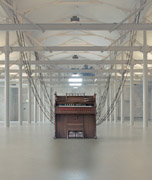
Architecture as Instrument
With Playing the Building, David Byrne wanted to create an installation that would produce sound and would take advantage of the fact it is housed in a raw factory space- with exposed pipes, heating and structural elements.
Devices are attached to the building structure- to the metal beams, the plumbing, the electrical conduits, the heating pipes, the water pipes - and are used to make these things produce sound. No amplification is used, no computer synthesis of sound and there are no speakers. The machines will produce sound through wind, vibration and striking. The devices that are part of the piece do not produce sound on their own, but instead they cause the building elements themselves to vibrate, resonate and oscillate so that the building itself becomes a very large musical instrument.
At the the Färgfabriken artspace, Stockholm, Sweden. 2005-10-08 - 2005-11-13. Opening and party Saturday October 8, 12pm-1am. Related: Sascha blogged the Electromechanical mandala workshop with Douglas Irving Repetto at the UDK in Berln. [blogged by Regine on we-make-money-not-art]
Posted by jo at 10:33 AM | Comments (0)
September 28, 2005
Zhong Shuo
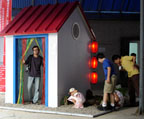
24 Hour Access to China
Zhong Shuo (People Say...) is a sound installation made collaboratively by Australian sound artist Iain Mott, Beijing visual artist Ding Jie and the Chongqing art collective the Li Chuan Group comprising Li Chuan, Li Yong and Ren Qian. The work acts as a system for the collection and telling of stories and focuses on the rapid force of change in China. The exhibition at the Long March Space in the Dashanzi district of Beijing, marks the first stage in what ultimately will be a series of installations connected to each other via the internet. It will consist of up to three individual installations set up in three cities including Beijing, Chongqing and potentially a third location on the route of the Long March.
Stage 1 was launched at the Long March Space, Dashanzi, Chaoyang District, Beijing on 20 August 2005. Stage 2 is currently underway in Chongqing with the Li Chuan Group. The exhibition is to be held in the Chongqing Planning Exhibition Gallery at Chaotianmen Square.
Each installation will pose a question to visitors, asking them to tell a story of their experience of change. In Beijing, Ding Jie's design establishes a gently ironic environment for public interaction. Created in the form of a Chinese garden, a kiosk houses a telephone for contributing stories and an adjoining rock-pool plays host to a small school of goldfish and water-plants. Hidden away in the rocks and shrubs is a loudspeaker, which plays a steady stream of stories that have been automatically recorded and edited by a computer. This sound, in addition to the voices, includes ambient sound recordings collected locally and is edited in the style of radio documentary.
Once the other installations have been established, stories will be shared between sites by way of networking. In this way, visitors will be able to reflect on varying perspectives on change. Each installation will share copies of the stories collected remotely and these will be edited together mixing both dialects and points of view. Additionally, the sounds played by the installations will be streamed to the web as internet radio, giving 24 hour access to Chinese speakers both nationally and internationally. Information on this radio channel will be announced by the Long March Space before the opening.
Posted by jo at 08:48 AM | Comments (0)
Fursicle Safurry

Telecommunications Wilderness
Fursicle Safurry invites people to enter a space of make-belief adventure through the wilderness of telecommunications. Upon calling the fursicle with their cell phones, users will receive a password composed of animal sounds such as gerrrs, wooww, barks, cries, and meaows. They then have to go to the head that is outside the installation. Staying on the phone they tell the password to the head which responds by sending a sound feedback and a blue light. If the head likes the password, the user gets to enter.
The voice on the phone asks users if they want to MATE, KILL, or RUN with the fursicle. According to their choice, users will be guided by instructions from the voice on the phone: they will have to touch and move in various ways with the fursicle, inventing the feedback as they move. While the user is interacting with the fursicle corresponding sounds and projected images are texturing the experience with rich animal sights and languages. By Dana Karwas and Liubo Borissov. [blogged by Regine on we-make-money-not]
Posted by jo at 06:49 AM | Comments (0)
September 24, 2005
SonicWireSculptor

Correlation Between Vision and Sound
At its simplest form SonicWireSculptor is a novel 3D drawing tool and a unique musical instrument, but perhaps most important - its just fun to play with. The project started out as a personal instrument for Pitaru to perform on. During concerts, audience members often inquired whether they could experience the tool first hand. This encouraged Pitaru to transform the software into an immersive public installation. The installation included enhancements to the original work, allowing a wider range of users to intuitively interact with the environment. Gallery visitors would enter a dark room with a surround-sound system, a projection and a unique drawing station. Opening nights for these exhibits would often double as performance and workshop events where the audience and Pitaru explore the tool together. Participants would be encouraged to add their work to a steadily growing collection of beautiful and surprising sonic-sculptures. [Related]
Posted by jo at 03:43 PM | Comments (0)
September 22, 2005
Strainings

Sift, Sort, Stretch, Pull
To see is to choose. To see is to select something and overlook something else. To be seen is to exist. When someone set sights on you, you appear in the other persons world.
Strainings--by MusicalFieldsForever--is about this genesis: to select what you want to keep from that which should be left out. In a physical, personal and cultural sense. Strainings is an interactive sound and light (audiovisual) installation contained in a silo. The many interpretations of the word "strain" embrace all of this: to sift and to sort, as well as to stretch and pull a string. In Strainings the audience decides what should be heard and seen. By pulling strings, they change the mesh of the strainer/ the large web. Light, sounds and images are strained and created.
Strainings consists of 7 light ropes 6 meter long, hanging from the roof and pulled through a web of flexing rubber bands. Interacting with the light ropes changes the structure of the web that cast shadows on to the projected images on the wall. A camera analyses movements in the light ropes and the input is used to change and make variations in the light, the light ropes and the sound. The background sound consists of bell frogs recorded in Baldringe, Sweden, strings and synthesised sounds that change, mix, and filter generatively. The interaction sound consists of trumpet loops with granular synthesis making it possible to play continuously and changing tones when pulling the ropes.
The software is developed in Max/MSP and SoftVNS. [via]
Posted by jo at 07:00 AM | Comments (0)
September 20, 2005
Radio Astronomy
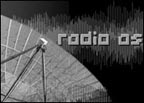
Streaming from Deep Space
"One of the peculiar aspects of streamed transmissions is the immediate delocalization of informations, thanks to the pervasive structure of the net which allows a personal and continuous 'international telecast', bringing any local content to screens in remote places. This is true both for video and audio transmissions, with the latter sometimes even more tied to the territory they are brodcasted from and expressions of a culture that needs to be understood and contextualized before being enjoyed. Thus, the place the sounds come from is reduced to the simple title displayed by the sound player while the data inexorably fill the buffer and the audio card processor before hitting our ears. Despite this, the farther the source of the transmission is, the more fascinating the listening opportunity will be. Radio Astronomy is based on this principle. It's an ambitious project by Radioqualia (Honor Harger and Adam Hyde) realized through collaborations with several radiotelescopes scattered throughout the globe. The sounds coming from deep space are intercepted and decoded by the radiotelescopes themselves and channeled to a sound stream that is then made available on the net, connecting any place reached by the net to the frequencies coming from light years away. As the authors themselves say, Radio Astronomy is "a radio station that transmits sounds coming from outer space", and one of its greatest features is the possibility to hear really distant frequencies amplifying the feeling of distance we have gotten used to since the advent of the net." --neural.it [Related]
Posted by jo at 11:07 AM | Comments (0)
September 19, 2005
B!AS International Sound Art Exhibition
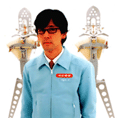
My Substitute Life
The B!AS International Sound Art Exhibition focuses on 'the various changing states of sound in modern environments, with lifestyles directly replaced by sound wave frequencies being the natural composite of harshness, authority, vulgarity and ambiguity.' Okaaay, let’s unpack that! Curated around the theme, 'Life Substituted: Sound Wave Frequency,' the show's contributors use sound to isolate and intensify distinct aspects of society and our position within it. For example, Maywa Denki's 'Switched On Kappa 2005' is a live performance that the artist calls a 'product demonstration,' involving fish-motif nonsense machines, original musical instruments, and flower-motif objets d'art. Christina Kubisch's 'Bird Tree' brings nature and technology together in an interactive installation that allows the visitor to receive and mix sounds via a wireless headset. Incorporating emerging and established artists, the show offers new media approaches to art-making that should stimulate new questions: How does the privileging of sound create fresh discourse around traditional visual art? Does this project complexify or dumb down notions of identity, place, and dialogism? Is bricolage the new aesthetic? Opening on 24 September and running through 20 November, it’s definitely worth a look. Or a listen. - Peggy MacKinnon, Net Art News, Rhizome.
Posted by jo at 09:32 AM | Comments (0)
September 16, 2005
Wind Array Cascade Machine
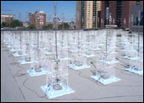
Si(g)n(e)
"Wind Array Cascade Machine (WACM)--by Steve Heimbecker--is a device that captures the wind's direction and movement and then streams the resulting data on the Web and uses them for installation projects. Thanks to the 64 motion sensors forming a grid of 8 units by 8 units, the system "maps" the wind in an outdoor space. Streamed on the Web, the data from the 64 channels are then processed by a computer program and assigned to installations that translate them into another form.(1)
The system has already spawned an installation, Pod, presented at the Mois Multi 2003 in Quebec City, as well as at the Subtle Technologies conference (2003) at the Interaccess centre in Toronto. During these two presentations, the sensing device was placed on the roof of the Méduse complex in Quebec City, and the data transmitted by the network were used to control a series of corresponding light emitting diodes (LEDs) placed on long vertical rods in an exhibition space.
Installed for a full year (2004-2005) on the roof of the Ex-Centris complex in Montreal, WACM powered the August 2004 Pod presentation at the Kiasma Museum of Contemporary Art in Helsinki, Finland, as part of ISEA 2004, as well as its presentation at Oboro in Montreal in November and December of the same year. The resulting luminous installation evoked a windswept field of wheat, thereby creating a visual analogy to express a natural phenomenon that is hard to perceive.
This system is similar to other devices created by artists integrating natural elements (for example, the wind and sun) into kinetic art. Yet Pod differs from this work in that the wind isn't used for its energy potential but rather because it describes a space by occupying and modifying it. Such projects are motivated by a fascination for natural phenomena, a desire to incorporate them into the creative process in order to link us to nature in technological contexts that sometimes exclude us and tend to distance us from our own organic condition.
In addition, Heimbecker is working on the project Si(g)n(e), a sound installation using the same system. To carry out this project, the artist is designing a sine wave generator with 64 channels, which will be controlled by a programming environment linked to a corresponding multi-channel sound system. The technology is being developed within a residency in cybernetic art at Vidéographe thanks to a program funded by the Foundation (2). Si(g)n(e) harks back to the many sound portraits of outdoor spaces produced by Heimbecker in the past." --S.P. © 2004 FDL [via]
Posted by jo at 09:12 AM | Comments (0)
September 15, 2005
Tree
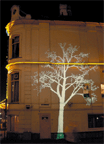
Leaves [a] Sound
Even things we’d likely to perceive as nature, like the trees on the street, are carefully planned and managed and no longer nature. However, the wind blowing through its leaves is. Like footsteps in the sand or ripples on the water, there are still a few natural elements left in the urban environment.
Tree, by Simon Heijdens, is projected onto several facades in the city, including dark corners and alleys. The main location has a 3x8 meter drawing of a tree projected onto the facade of a building. The branches and leaves move slightly, with an intensity that depends on actual wind gusts.
Its leaves are sensitive to sound. For example, a shouting passer-by or car horn, will make a leaf break off the branch. When it falls off the tree, the leaf falls down in another part of the city, projected onto the pavement. Depending on the human traffic of that evening, there will be more and more leaves.
Because the leaves are made of light, the spot where they fall will become brighter over the course of the evening. The tree is projected from sunset to sunrise. Arriving in the city at one in the morning to find an empty tree or a floor full of leaves, it will be clear that something has been happening.
The installation is part of the Radiator Festival, Dec 1st – 4th 2005, Nottingham, UK. I saw it at the Design Museum: there was just one projection in a room of the museum, so one couldn't guess what the whole installation was like, but the piece was neverthesless very poetic and relaxing. [blogged by Regine on we-make-money-not]
Posted by jo at 09:20 AM | Comments (0)
September 09, 2005
PAUSE

Sonic Hammocks
The sound installation PAUSE is made of 5 hammocks connected to each other at the center by a system of springs. Any movement caused by the presence of a visitor is transmitted to the other hammocks.
When a visitor sit in a hammock or leave it, s/he causes rocking movements which are detected by sensors. The information influences in real time the audio-tactile events transmitted by 9 loudspeakers distributed in the hammocks. The sounds become really audible only for spectators who lie in the hammock and press the hands on their ears. The mechanical vibrations resulting from the transmission of the sounds in the loudspeakers become perceptible on the body itself and the sounds are retransmitted in the inner ear by bone conduction. Each loudspeaker has its own channel so that the sounds, and the vibrations they cause, can move on the body from one source to another. The spectator is thus confronted with different types of movements: the swinging of the hammocks, the vibration of the loudspeakers and the movement of the sounds and their vibrations from one speaker to another.
By Lynn Pook (see also A Fleur de Peau). Pause is part of the Festival Emergences, in La Vilette (close to Paris), Sept. 24 - Oct. 2. Related: Hammock of electricity. [blogged by Regine on we-make-money-not]
Posted by jo at 05:41 PM | Comments (0)
September 08, 2005
Alvin
![]()
Sonic Incubator
Alvin, by Jamie O'Shea, is a cellular automaton. Eight different cells produce sound. The sound one cell produces is determined by what sound the other cells are making. This kind of interrelated input and output scheme is an artificial neural network; a simulation of a brain. Alvin imitates living organisms in another way, because the sound circuits are actually built and destroyed by one another, rather than just turned on or off. The sound jiggles metal powder just like heat jiggles chemicals in a living cell. It is a way of making dynamic order out of randomness.
The sounds Alvin can make are pseudosine waves between .5 hz and 100 hz. When a cell has only a little input, it is subsonic, and can be seen moving. As it gets more input, the tone increases in frequency. At about 100 hz, it can jostle components for new sound circuits, sending "outputs" to the other cells. Eventually, the cells kill each other and start over. Once a pattern has been started, it can evolve in this way for a long time, changing in complex and unpredictable ways. It is a bit like the sound of a computer dreaming. Alvin will be on view at Circuit #1, September 9 - 10, 2005, Fri-Sat, 12-6pm, Eyebeam, 540 W. 21st St., New York.
Posted by jo at 03:58 PM | Comments (0)
September 07, 2005
FontanaMixer
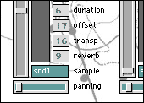
Simulating John Cage with Algorithms
The coding of conceptual works through the programming code is a peculiar form of 'digitalization' that implies an important mediatic shift (from a material medium to an immaterial one), even if at the same time it exalts the ideas in the perennial algorithms' output. FontanaMixer is a generative software based on 'Fontana Mix', a conceptual work by John Cage made in 1958, programmed for the Mac OSX platform by the austrian Karlheinz Essl almost 50 years late. The score was made by 'instructions' expressed as full stops, lines, and graphics and juxtaposed through transparent sheets in a casual manner. It calculated six different parameters for very sonic event, letting the interpreter freely choosing the parameters. This anarchic freedom of interpretation with no apparent order, that Cage connected with the liberation from the personal tastes connecting it to the natural events, is reflected in this software with four autonomous channels and parameters that autonomously modifies under the user's eyes. The work's theatricality is disappeared, and also the equipment presence on stage (four tape recorder) then used by Cage. But this work, commissioned by the Wien Modern, realizes a sort of software 'cover' of an historical performance. It preserves (instead of the common 'musical' covers) the inspiring principles that once motivated and animated them. The vagueness, the opportunity and the silence are here again, calculated by a microprocessor fed by the necessary instructions, and protagonist of the same poetic original automation. [via neural.it]
Posted by jo at 12:56 PM | Comments (0)
September 02, 2005
Bondage
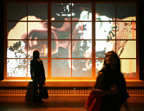
Bound by Pixels
Bondage creates music using pictures of Japanese women made by Japanese photographer, Nobuyoshi Araki. The photo was scanned and projected onto a shoji – the traditional Japanese rice paper wall with sliding doors. The photographs are fed into an image-synthesizing program, scanned and analyzed to become the harmonic spectrum of the sound to be arranged and mixed. Visitors reveal hidden layers of photographs that are projected onto a paper surface. With their movements in front of the installation, they scan the image and modify it, which simultaneously activate the installation’s sound environment. Created by Atau Tanaka. Metasynth processing by Eric Wenger. [blogged by Regine on we-make-money-not]
Posted by jo at 08:42 AM | Comments (0)
URBANtells
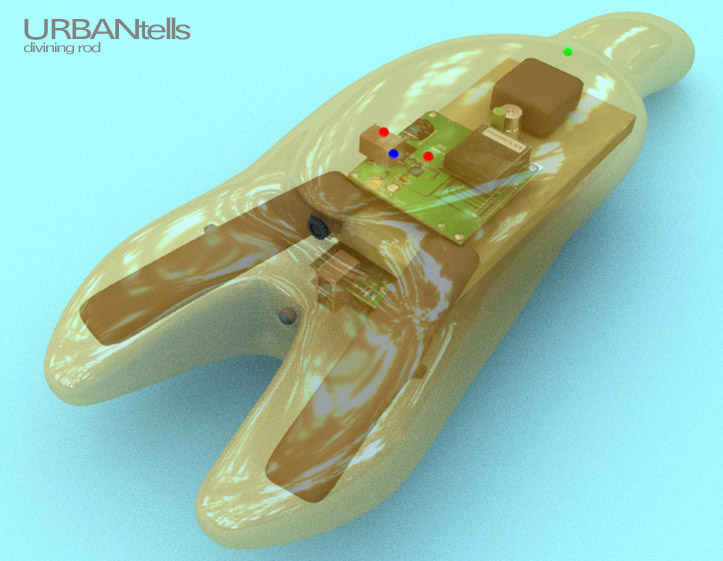
Exploring the City with Digi-Diviner
URBANtells is a mobile sound installation in which the user explores a neighborhood on foot, "data-diving" with a handheld device called digi-diviner. Participants will provide their cell phone and email address to an attendant at a kiosk. In return, they will be given a digi-diviner to walk and explore the neighborhood. A minute or so after they go outside a real time mix of sound art and verbal information triggered by their location will start to play through an earbud attached to the diviner. The information is a mix of recordings of residents and historians, text-to-speech synthesis, recitations, musique, and other processed sound. The information will address the complex layers of personal and collective histories and experience in urban environments, and the degrees to which these acoustic "tells" influence behavior and development within a community similarly to traditional, physical structures.
Users will be able to upload sounds, text, and still images they capture with the diviner en route. This information will be available to other users. Upon returning to the kiosk, participants will receive an interactive Google map of their specific walk via email, containing buttons to play sounds and view images they may have uploaded during their trip. Urbantells, a project by James Rouvelle, Joe Reinsel and Steve Bradley, opens June 2, ‘06 at Art Interactive, Cambridge, MA. [blogged by Regine on we-make-money-not]
Posted by jo at 08:30 AM | Comments (0)
September 01, 2005
Scrapple
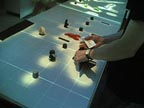
A Physical Score Table
Scrapple: A physical active score table, by Golan Levin, is a physical version of the screen-based Audiovisual Environments (AVES) devised for the Scribble performance in 2000.
In Scrapple, object placed on the table become sound-producing elements that determine the score's rhythm and pitch. They are interpreted as sound-producing marks in an active score: flexible shape-holding curves allow for the creation of melodies, a group of small toys and other moving objects yield ever-changing rhythms. Video projections on the table turn the installation into a simple augmented reality, in which the objects are elaborated through colorful and explanatory graphics. [blogged by Regine on we-make-money-not]
Posted by jo at 06:12 PM | Comments (0)
August 09, 2005
In Memory of Franz Feigl
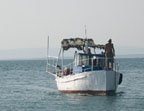
The Myth of Bolshevik
Network activists and friends of the medien.KUNSTLABOR want to travel by boat from Amsterdam to the Black Sea. Final destination of the journey is the island St. Anastasia, formerly known as Bolshevik (1945 - 1990). The boat is named after Franz Feigl, an Austrian artist and network activist who lived in Amsterdam and died in 2001 at a young age.
The boat will record on its journey all open wireless lan access points. This activity, if conducted by car, is called war-driving. The peaceful goals of the Motorship Franz Feigl aim at highlighting the possibility of opening up networks and creating a free infrastructure (see Funkfeuer, Freifunk,
Consume).
The boat will also communicate via packet radio and pictures will regularly be sent by GPRS to http://stroem.ung.at. MS Franz Feigl has already travelled from Amsterdam via Linz to Vienna. In Linz at the wharf of the Times Up collective repair work on the boat was done. It has travelled safely from Linz to Vienna under captainship of Franz Xaver.
Tomorrow, Wednesday August 9, the MS Franz Feigl is due to leave for Bratislava, where it will arrive om Thursday or Friday. On Monday, August 15, it will arrive in Budapest.
The project is carried out in collaboration with 05-trov and mobil.KUNSTLABOR.at
SMS Kontakt: 00436764902223
Chat: irc.kunstlabor.at#kunstlabor
E-mail:boot[at]kunstlabor.at
[via netbehaviour]
Posted by jo at 12:35 PM | Comments (0)
August 08, 2005
Heaven Seed
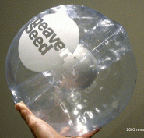
Populating Physical Spaces with Digital Sound Effects
Heaven Seed is a smart plastic ball that senses its movement and generates various sound effects in real time thereby enhances the game people play with it. The motion data sensed by the ball are wirelessly transmitted to a host computer to provide rich auditory experiences. For example, if you throw it upward, it makes a whiz sound; when you catch it, it makes a flopping sound. If it's left unused for a while, it starts snoring.
Ryota Kuwakubo, who created this artifact, says that he wanted to evoke in users the kind of feeling kids would have while playing with a miniature car – kids may make the sound of speeding with their mouths and they could get totally immersed in the play. Kuwakubo also suggests a possibility of making everyday life more "interesting" by populating our physical spaces with various digital sound effects. When you open the door, when you start a washing machine, etc. If the world around us will be the interface to the digital information spaces, Heaven Seed suggests unique possibilities of enhancing our embodied interactive experiences with creative sound design. Related websites: vector::scan; MyCom PCWEB. [blogged by manekineko on we-make-money-not]
Posted by jo at 10:05 AM | Comments (0)
August 05, 2005
Air Vent: Call for Participation

The Relationship Between Sound and its Source
AIR VENT is a project that takes natural sounds out of their specific location, the sounds of peoples personal spaces [via mobile telephone] & places them live via radio senders or the internet into new contexts, into diverse locations, into both similar & contrasting environments.
The work stems from ideas based on the relationship between sound & the sound source; natural rhythms & patterns in everyday sound [background noise, dialogue, etc]; the fine line, & often friction between natural & synthetic sound in connection to space; audio & visual perception.
Air Vent is radio/telephonic project by k donovan for Radio LoRa in Zürich that will start on 1st august at 00:00 & end on 10th august at midnight. Five minute snippets of sound will be transmitted hourly for those 10 days, both pre-recorded & live via mobile/landline/internet phones from around the world. The idea is to take the background sound from a specific space & relocate it (mainly live) into other new, similar & contrasting environments through radio.
If you are interested in sharing the sound from your space live, you are gladly invited to participate by registering online & providing dates & times when it would be possible to call the studio in zürich, or connect via internet phone. You will then be contacted (via sms or email) with a confirmation.
Pre-recorded sound files (preferably recorded with a telephone, but other ways are also acceptable) of environmental/field recordings can be sent to:
spezialprogramm@lora.ch (mp3's) or by snail mail (be quick!) to: AIR VENT, Alternatives Lokalradio Zürich, Postfach 1036, CH-8026 Zürich, Switzerland.
Please include a short introduction about the place and time at the start of the recording.
Queries & questions? Contact: kdonovan_uk[at]yahoo.co.uk
Things to acknowledge: For live calls, don't forget time differences! The concerns of this project are the 'natural' background noises that are specific to a certain space/time/situation.. therefore, participants are asked to simply use their phone to transmit their given environment through sound, rather than to perform or contrive something for the listeners. And by the same token, pre-recorded pieces that have not be edited/layered/effected would be preferred.
Posted by jo at 10:20 AM | Comments (0)
August 01, 2005
HyperSense Complex
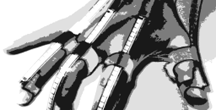
Exploring Ways of Interacting with the Computer
HyperSense Complex--the collaborative trio of Alistair Riddell, Somaya Langley, and Simon Burton--have been working together since 2002. They've been exploring the notions of collaborative interactive performance in a networked computing space (essentially where members of the trio - dependant on configurations of specific performances - can influence each other's sound, for example: by sampling each other's output, adding effects etc). HyperSense has also been developing an alternative HCI's using flex sensors worn on the hands (and strapped into a jacket arrangement). The project utilises data sent from the sensors through microcontrollers and passed via USB to some python scripting which handles what the sensor data should do. They then implemented OSC and are using this to send information to SuperCollider running on a separate laptop, which handles the samples and audiobased materials.
Posted by jo at 08:31 AM | Comments (0)
Ruccas.org
![]()
As Good as the Community Makes It
Today, Ruccas.org celebrates the end of its first year of operation, and the start of the next. A year ago, ruccas.org launched with a handful of artists. Today, it features the works of over seventy artists and collaborative projects, nearly all of which are available under a Creative Commons license.
Its growth and success are due entirely to the community, who have taken advantage of how easy it is to add their own page and share their work with one of the largest online audiences for unconventional electronic art. Ruccas.org's allowing of anyone to edit the site and add their own pages, as well as its offering of free hosting for aural, visual, and software art, has enabled this to happen. The ruccas.org philosophy is that the best way to create a site of this type is to give the community as much control as possible, and artists from all around the world have stepped up and proven that our philosophy is correct.
In the coming year, I personally hope that the site will continue to grow at the rapid rate it has been. Ruccas.org is a unique hub in the sense that is it only as good as the community makes it. Therefore, I urge all of you out there who are are trying to do something "new" to come share your artwork with us, and to encourage others to do the same. I know that I speak for the entire ruccas.org community when I say that we're looking forward to the next year of new additions, new directions for the site, and new community members.
- John Nowak, Ruccas.org
Posted by jo at 08:20 AM | Comments (0)
July 27, 2005
Laurie Anderson: The Record of the Time

Sound in the Work of LAURIE ANDERSON
Laurie Anderson: The Record of the Time is a 30 year retrospective of Laurie Anderson's works that opened last week at the NTT InterCommunication Center [ICC], Tokyo. It will run through October 2, 2005.
Laurie Anderson (born 1947) rose to acclaim on the New York art scene of the early 1980s with her distinctive electronic performances, and continues to be a major globally active artist, one the very few truly international stars of performance art today. Utilizing synthesizers, video and computer graphics as well as various electronic devices of her own design, she blends diverse elements - music, moving images, language, action - into eclectic cocktails of experimental ideas and avant garde modes of expression that appeal to a broad popular audience. She is, in a word, the very embodiment of colorful postmodern performance.
Recently invited to become the first ever Artist-in-Residence at NASA, she created a new performance piece under their auspices. She is also currently showing an installation-video-performance work in a Japanese garden as part of Expo 2005 Aichi. Indeed, her keen creative energies seem inexhaustible.
The present exhibition was produced by the Musee d'Art Contemporain de Lyon, after which it toured to Dusseldorf, Milano and Dublin before coming here. Comprising some ninety pieces - everything from early works steeped in the conceptualism of the 1970s, to videos, assemblages, installations and original violins, to photos and drawings right up to projects for Expo 2005 Aichi - the exhibits span an artistic career of over thirty years, making this a real retrospective show, and for many of us here in Japan, a prime opportunity to take in the full scope of her multi-disciplinary, multi-media pursuits.
Posted by jo at 08:35 AM | Comments (0)
July 22, 2005
KODAMA
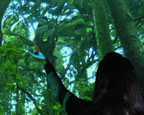
Whispering Trees
KODAMA (echo in English)--by Hisako Kroiden Yamakawa--aims at demonstrating the existence of voice as a physical object and how it floats through space. KODAMA are tree fairies that hide in the forest and listen quietly to your voice. They collect the voices and trap them in a bubble of air. When KODAMA don't sense the presence of humans they start playing with the voices that have been left in the forest. But as soon as they do notice someone they hide themselves with the "voice" and wait to collect new "voices". [blogged by Regine on we-make-money-not]
Posted by jo at 02:01 PM | Comments (0)
July 08, 2005
The Lake

Live Fish Performance
The Lake is a sound and animation work by Julie Freeman based on the movement of fish that are bio-acoustically tagged in a lake. The fish movements are continually monitored as it moves in the lake to compose enveloping soundscapes and transient visuals.
On the screenshot [left] of the animation, each fish is represented by a core colour and two auras all of which change colour and rate of display depending on certain behaviours. The large shapes link species together, and the debris (trails and rotation marks) show each fish's movement history over the last 5 minutes or so.
Once inside a towering structure visitors are linked live to the actual movements of the fish; melody and rhythm are coaxed out of the fish's unpredictable and unorchestrated behaviour. Suspended above people representations of the fish create an animated terrain. Changes in brightness, colour and form indicate alterations in the movement and variations in the dominance of the fish.
The Lake will be on-line with live fish data from 9 July 2005. The exhibition is open to the public Sat 9th July – Sun 2nd October 2005, at Tingrith Fishery, Bedfordshire, UK. Via organism. More "artists love fish": Fish, plant, rack, Fish-byte.net, goldfish racetrack, augmented fish reality, etc. [blogged by Regine on we-make-money-not] Read a review.
Posted by jo at 10:11 AM | Comments (0)
June 20, 2005
Sound Lines

Captured Layers of Energy
Using live audio feeds from Leeds City Station and the River Aire, US artist Bill Fontana will craft a giant sculpture of sound turning the historic Dark Arches into an immense musical instrument. For two months a loudspeaker system installed within the arches will fill the space with an ever changing combination of live sounds relayed directly from specialist listening devices installed in the surrounding area.
A series of microphones high up in the structure of the station will pick up the bustle of platform activity, whilst sensors fixed directly onto the track buffers will listen to the distant vibrations of incoming trains as they approach, slow down, and come to a stop. Beneath the station, underwater microphones will be plunged deep into the course of the River Aire as the flow of water is redirected through the arches. Sound Lines attempts to capture these continually changing layers of energy as they arrive, depart, and flow through the city.
San Francisco based Bill Fontana is known internationally for his experimental work with sound. Using urban and natural environments as a living source of musical information he radically transforms the meaning of public space. His extensive body of work includes temporary and permanent installations in New York, Paris, Vienna and London. (resoundings.org)
Posted by jo at 09:46 AM | Comments (0)
May 31, 2005
Trace

Whispers in the Maze
Since May 6, visitors to the oldest maze in the world, Hampton Court Palace Maze can hear cymbals, a dog barking, a child laughing, the rustle of silk skirts, a tune from a music box, and the murmurs and sighs of three centuries of chatter at the palace. The sounds float around the maze so subtly that it is hard to distinguish them from real-life ones. Besides, quotes from staff discussing the facts and figures behind the attraction are interspersed in the sound effects.
The maze has been filled with sensors that trigger hidden speakers, which emit a variety of strange sounds and voices, waiting to be triggered by a footfall. The sounds are part of Greyworld's last installation, Trace. The centre has been replanted with hornbeam and features touch-sensitive benches that create subtle sounds as visitors sit to relax. There are thousands of permutations of the sounds triggered from 20 speakers, so no visitors will ever hear exactly the same. [blogged by Regine on near near future]
Posted by jo at 07:25 AM | Comments (0)
May 24, 2005
Mapamp
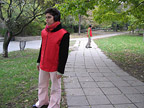
Mix the Acoustic Space
Mapamp--by Tamás Szakál--uses existing structures and systems (architecture of a city, navigation and radio systems) to layer an artificial acoustic space over the original one. The participant walks the streets wearing a special vest that allows him/her to navigate through different sound data fields. These virtual spaces differ from the geographic city scape. Changing his/her position, the walker can pick up and mix the sounds, which come into connection with the architectural features of the public space: the noise of the surroundings, distant radio stations and abstract sound samples intermingle in the space, depending upon the position, direction and velocity of the visitors. Related: Steve Symons' Aura, Sonic City, Sonic Interface by Akitsugu Maebayashi. [blogged by Regine on near near future]
Posted by jo at 10:17 AM | Comments (0)
May 16, 2005
Fireflies
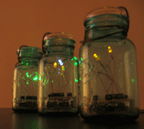
Networked Nightlights
John Schimmel's Fireflies are networked nightlights for a local environment, the jars can be placed in different bedrooms or other spots around a home so people can communicate with one another through simply tapping on the jars. For example, if you tap the jar in your bedroom you will pulse the colored fireflies associated with that jar. The neighboring jars in your home will receive and pulse your taps, record them and then play them back. The neighboring jars can respond with their own tapping and broadcast themselves to the nightlights in the home. While a person is tapping the jar, they are in a broadcast mode where they get approximately 4 seconds of tap time and the other jars are in listening mode, again, for approximately 4 seconds *. After the 4 seconds is up there all the jars play back the recorded taps they have received. It's a firefly jam session.
Posted by jo at 07:11 AM | Comments (0)
May 11, 2005
Cut & Splice 2005: Dots and Lines

The Gap Between Ideas and Experience
Sonic Arts Network and BBC Radio 3 are proud to announce the programme for the most ambitious Cut and Splice to date. This year’s Cut and Splice presents DOTS AND LINES, a cluster of events that explore the idea of notation and the relationship between score, image, text and sound in electronic music and sound art.
Focusing on the gap between ideas and experience, between abstract concepts and their relation to the tangible, DOTS AND LINES considers the analytical, performative and documentary nature of music as written document and code. It throws into relief our very concept of what constitutes the musical experience and considers the complex dialogue between time based and static art forms.
The series includes gallery and online exhibitions, a concert series, and weekly radio programmes for Radio 3’s Hear and Now.
Cut & Splice is an annual festival of performance and exhibition that explores key themes and ideas in the history of art, technology and music. It is co-curated by the BBC and Sonic Arts Network and it takes place in May each year. Each year the festival showcases the work of the leading artists in the field of radical electronic music and digital sound art.
Posted by jo at 10:38 AM | Comments (0)
May 09, 2005
De-Grammatical: Rhythm and Language Transformation

Art of Noises
Next at HTTP// [House of Technologically Termed Praxis]: De-Grammatical: Rhythm and Language Transformation by Elisabeth Penker: For the opening--Tuesday 10 May 2005 7-9pm--Penker will perform live to the composition "Die Bildhauerin."
At the turn of the last century the Futurists introduced sounds of motors and vocals as instruments for orchestras, which consequently influenced Dada and Fluxus movements that pioneered the early days of electronic music. The Dadaists phonetically experimented with grammatical structures. Penker combines these different approaches to rhythm and language transformations. Die Bildhauerin breaks up the grammatical structure of the word "DIE-BILD-HAU-ER-IN" into minimal units which are called morphemes. The composition is arranged with the sound of two stone masons, chiselling this broken grammatical structure into a wall.
The morphemes build the base rhythms of the composition. The performance is supported by a sonic structure constructed of wood and various industrial floor materials which are amplified and function as instrument and interactive sound sculpture during the exhibition. The audience can play on the sonic structure, and this is combined structurally with the conceptual logic of Luigi Russolo’s (1913) Manifesto, The Art of Noises and the technical methodology of Jack Foley’s recordings for films.
Exhibition: 10 May - 5 June 2005, Friday - Sunday 12-5pm
HTTP gallery is pleased to present Austrian artist Elisabeth Penker's first solo exhibition in the UK. In her work Elisabeth Penker is questioning visual structures in relation to language. By decoding visual systems and displacing rhythm and language into a non-linear structure, Penker is showing the commonality of Modern Art and First Nation Art. It is of particular interest how polysynthetic languages which are common in First Nation Languages (i.e. there is no clear distinction between a word and a sentence), compare to Indo-European languages and how visual languages relate to grammar and syntax.
Elisabeth Penker, born 1974 lives and works in Vienna recent exhibitions include:
2005 "The Red Thread" Howard House Contemporary, Seattle
2004 "Sound Studio" Gallery Priestor for Contemporary Arts, Bratislava,
SK "Born to be a Star" Künstlerhaus, Vienna
2003 "Sound System", Salzbuger Kunstverein, Salzburg, A ; Liste 03 with
Galerie Michael Hall, Vienna (solo), "Selected Sound Sculptures",
Galerie 5020 Salzburg /A (solo)
2002 "Butterfly reached the sound-barrier", Kibla New Media Center,
Maribor, SL; "Waiting for the Ice Age"(curated by Michael Hall), Galerie
Georg Kargl, Vienna; "hear the art", Kunsthalle Exnergasse, Vienna
2001 Kunstbüro, Vienna (solo) "First Story-Women Building", Galerie do
Palacio Cristal, Porto (curated by Ute Meta Bauer) and "(untitled)
654321", Kunsthallen Brandts Klaedefabrik, DK (curated by Jacob
Fabricius & Tommy Lund)
"De-Grammatical: Rhythm and Language Transformation" is supported by the Austrian Cultural Forum.
Unit A2, Arena Business Centre,
71 Ashfield Rd, London N4 1NY
Tube: Manor House, Buses: 341, 141,
Car: free parking facilities
HTTP:// is a non-profit organisation run by artists and curators of
Furtherfield.org & Dosensos.
for further information contact: info[at]http.uk.net
tel: +44 (0) 208-8022827
Posted by jo at 07:31 AM | Comments (0)
April 20, 2005
Transmission
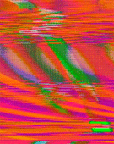
You Can Feel It in the Air
"At some point in our lives, we notice ourselves lugging around an overload of ideas and information. How is it that we continually play the role of unwitting receiver to a barrage of loaded transmissions? Transmission is a series of exhibitions presented by the New Museum of Contemporary Art, which profiles artists and scholars exploring the concept of 'transmission' in and through new media, radio, sound and broadcast media. 'Airborne,' the second show in the series, takes on the 'aesthetic, sonic and socio-political' aspects of these cunningly concealed wireless transmissions.
Curated by Anne Barlow and Defne Ayas, in collaboration with www.free103point9.com, the exhibition features seven works by New York-based artists that aim to give substance to intangible electronic signals and to the interests they power. Take Paul Davies 'Prayer Antenna,' which wittingly transforms viewers into supplicants as they kneel to insert their head into an ordained helmet covered with antennas; or Mendi and Keith Obadike's '4-1-9,' which invites one to compose an individualized email money transfer scam. Airborne will be at the New Museum until June 4, with performances on May 4 at 6:30PM." - Ophra Wolf, Net Art News, Rhizome, 04.20.05
Posted by jo at 09:31 AM | Comments (0)
April 13, 2005
Organum Performance
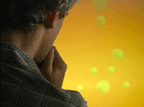
Voices as Game Controls
Organum is an interactive week of programs exploring the human voice through sound, image and technology. A week-long installation premieres Organum: The Game (2005), a video game by digital media artists Greg Niemeyer, Dan Perkel and Ryan Shaw, in which gamers navigate through the human voice box using their own voices as game controls. Also on view are glass etchings by Niemeyer and continuous screenings of Organum the short animated film (2003).
Organum: The Game is a collaborative video game in which three or more players sing into different microphones to control the three axes of movement (x, y, and z) on the game screen. Together, the players represent a grey sphere “character,” which they must navigate through an increasingly complicated path, hitting a series of targets as they travel through a luminous digital representation of the inside of the voice box.
New Langton Arts
Tuesday, 19 Apr 2005 to Saturday, 23 Apr 2005
12-6 pm, Admission Free
Reception: Saturday April 23, 6-8 pm
Organum culminates in a day of activities on Saturday April 23, from noon to midnight. An informal brown bag lunch with the artist/programmers is planned from noon to 3 pm, and the public is invited to an evening reception celebration from 6 to 8 pm. The finale, The Human Voice Explored, is a performance showcasing the vast potential of the human voice with Seth Augustus, Aurora Josephson, and Kid Beyond, at 8 pm. The space remains open until midnight for after-hours video game play. Organum is part of NetWork, Langton’s ongoing digital and net art exhibition program. [Related]
Posted by jo at 11:32 AM | Comments (0)
March 30, 2005
Phonic Frequencies:
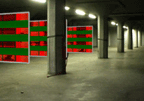
Shaping Networked Realities
ABSTRACT: The paper introduces a networked multi-user installation and interactive mixed reality environment that combines the fields of interactive art, telecommunication and streaming technologies. Phonic Frequencies is an audiovisual data space whose appearance can be altered via networked communication devices. Visitors are active agents and participate in shaping spaces as they control audiovisual data with their telephones.
Linking the physical space to the digital network space, Phonic Frequencies opens a hybrid reality for distributed sound exchange and visual communication, blurring the boundaries between verbal communication and digital information. The work attempts to break the conventional communication cycle of bidirectional dialogue and to consider the meaning of in- and output from a different perspective." From Phonic Frequencies: Shaping Networked Realities by Tamas Szakal, Christoph Groenegress, Wolfgang Strauss, Predrag Peranovic (c) 2003
Posted by jo at 07:40 AM | Comments (0)
March 23, 2005
Drift
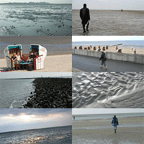
Being Lost
"The ubiquity of GPS (global positioning satellite) and other tracking technologies suggests that "being lost" may itself be an experience that is being lost. However, simply knowing ones geographical location as expressed in longitude and latitude coordinates has little bearing on ones personal sense of place or direction. Drift poses the age-old question "Where am I and where am I going?" in a contemporary moment in which spatial positioning and tracking technologies provide evermore precise, yet limited, answers to this question.
The installation embraces the flow of wandering, the pleasure of disorientation, and the playful unpredictability of drifting as it relates to movement and translation. Sounds blend footsteps on different surfaces with spoken word in different languages. Spoken word passages are drawn from poetry and literature dealing with the theme of wandering, being lost, and drifting. Meaning also drifts as Rousseau, Joyce, Kerouac, Mann, Dante, Woolf, and others are presented in the original and in translation. The Watten Sea becomes a metaphor for hertzian space as visitors are invited to wander among layered currents of sand, sea and interactive sounds that drift with the tides, and with the shifting of satellites as rise and set, introducing another kind of drift.
The installation covers a 2 km x 2 km region that is filled with areas of interactive sound. The region moves with the tide such that at low tide all the sounds are out on the Watt, at high tide they flood the town. Sounds play automatically as you wander through these interactive areas with a Pocket PC, GPS and headphones. The location of the areas changes constantly with the shifting tides - therefore, the best strategy for finding them is simply to wander."
Posted by jo at 09:47 AM | Comments (0)
February 03, 2005
Echo Ricochet
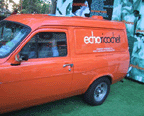
The Ebb and Flow of Perth
Cre8ive Challenge is an Awesome Arts initiative designed to engage young people in an open-ended, process-based exploration of identity. In 2003 their project included the collection of significant sound samples for a collaborative project with Scanner. The latter became a soundscape accompaniment for a journey through Perth’s urban environment.
As part of the Festival in central Perth Echoricochet was presented from an orange transit van. The public borrowed headphones and CD players and embarked on a sound-walk through the city, guided by instructions. Perth ebbed and flowed with its usual rhythms as the soundscape evolved around the listener, offering a relaxed yet heightened awareness of the urban environment’s passing details. [Read an interview with Scanner on neural.it]
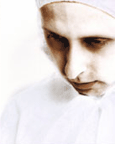
Found Mobile Phone Conversations
Scanner: This British audio auteur, composer and sonic spy trawls the hidden noise of the modern metropolis to create absorbing, multi-layered soundscapes. Scanner's already vast body of work spans from early controversial compositions using found mobile phone conversations to a more recent focus on trawling the hidden noise of the modern metropolis as a symbol of the place where hidden meanings and missed contacts emerge.
Scanner's diverse practices include audio CDs, soundtrack composition for films, performances, radio, and site-specific intermedia installations. He has performed and created works internationally including SFMOMA USA, Hayward Gallery London, Pompidou Centre Paris, Tate Modern London, Corcoran Gallery DC and the Royal Opera House London. He has collaborated with artists from numerous genres including musicians Bryan Ferry and Laurie Anderson, The Royal Ballet and Random Dance companies, composers Michael Nyman and Luc Ferrari, and artists Mike Kelley and Derek Jarman.
Scanner continually seeks unconventionaly environments for his works: in 1999 he performed Surface Noise on a London Bus around the city, in 2000 he performed over 20 KM of beach in Italy on the public speaker system, re-soundtracked Jean Luc Godard's seminal film Alphaville, and wrote the soundtrack to a working morgue in Paris in 2002.
Among his recently completed works are Into The Blue, a gallery installation using 10,000 latex balloons, soundtracks for The Royal Ballet's Qualia and Random Dance Company's Nemesis, a string quartet entitled Play Along, three feature film soundtracks, and CD releases of 52 Spaces commissioned for film director Antonioni's 90th birthday, and Warhol's Surfaces, commissioned for German Radio.
Scanner's work can be heard on permanent display in the Science Museum London (Sound Curtains) and the Raymond PoincarÈ hospital in Garches France as part of the bereavement suite (Channel of Flight). His BBC radio production of Jean Cocteau's 'The Human Voice' won the prestigious Prix Marulic Award and most recently he won First Prize Neptun Water Prize for his installation Wishing Well in Germany. In 1998 he became 'Professor Scanner' at John Moore's University in Liverpool.
Posted by jo at 05:56 PM | Comments (0)
January 25, 2005
GoingPublik
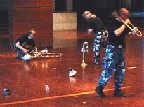
Mobile Multimedia as Mixed Reality
GoingPublik is a sound art work for distributive ensemble and mobile score synthesis. The core idea behind the work is a strategy of mobility by employing a wearable computer system running a software based electronic scoring system. GoingPublik will be performed at Interactive Futures 05 on February 5 from 9:30-10:30 pm. Art Clay will present a lecture "GoingPublik: Mobile Multimedia as Mixed Reality" from 2:30-3:30 PM.
"The core idea in the project is a strategy of mobility and this is accomplished employing a wearable computer system running the software based electronic scoring system as its central element. The program itself basically allows for what might be termed 'composed improvisation' which permits improvisational elements within a compositional structure. This is accomplished by electronically monitoring the performer's physical behaviour during performance. The program then responds by making suggestions to and even demands on the performer to various degrees and at various times.
Since each of the performers is equipped with the same electronic scoring system and because the system revolves around universally shared inputs such as geographical positions obtained via satellites and sensors using the earth's magnetic field, all have a common denominator and are thereby virtually linked. Despite the physical distribution of the performers in space, it is possible to have a commonly shared compositional palette and, at moments of close proximity between performers, to obtain instantaneous synchronized sonic elements. Both aspects needed for creating sonic structure within the work." Read paper >>
Composition Camouflaged: On the Relationship between Interpretation and Improvisation; Interview with Roland Dahinden, Günter Heinz & Thierry Madiot on the World Premiere of GoingPublik by Franziska Martinsen
Posted by jo at 10:05 AM | Comments (0)
January 19, 2005
Location is Everything

Rhizome.org ArtBase Exhibition
Location is Everything--curated by Jillian Mcdonald--explores ways in which artists repurpose mapping as a creative medium; or perhaps it reframes mapping as a procedure that is intrinsically creative. The cartographic forms in these projects are drawn according to, as Mcdonald explains, personal or collective experiences, some informed by external factors like weather data or pop-culture references, and some allowing the map itself or local residents to inform them. These reciprocal actions of forming and informing effect both maps and their makers, suggesting that who? and why? are equally important questions to pose when interpreting a map as simply where?.
Works included in this exhibition are "PdPa" (2003) by Julian Bleecker, Scott Paterson and Marina Zurkow, "[murmur]" (2003) by Shawn Micallef, "Louisiana Walk #14" (1996) by Janet Cardiff, "Atmospherics/Weather Works" (2003) by Andrea Polli, "GPS Drawing" (2000) by Jeremy Wood, "Hlemmur in C" (2004) by Pall Thayer, "Survey Field" (2003) by Germaine Koh, and "Infrasonic Soundscape" (2001) by Hidekazu Minami.
Posted by jo at 12:03 PM | Comments (0)
January 18, 2005
Sound Mapping

Sound Sense of Place
Sound Mapping is a participatory work of sound art made for outdoor environments. The work is installed in the environment by means of a Global Positioning System (GPS), which tracks movement of individuals through the space. Participants wheel four movement-sensitive, sound producing suitcases to realise a composition that spans space as well as time. The suitcases play music in response to nearby architectural features and the movements of individuals. Sound Mapping aims to assert a sense of place, physicality and engagement to reaffirm the relationship between art and the everyday. Paper; Images; Video; mp3.
Posted by jo at 06:51 AM | Comments (0)
December 27, 2004
rand()%commissions

Generating Randomness
rand()%, in partnership with The Media Centre, Huddersfield (UK), is pleased to announce the first in a series of commissioned generative audio works. The idea was to commission new works specific to rand()% which explore randomness and generative music composition.
The first commission is from Alku and comes in the form of several works tying together their Formatissimo series and culminating in their installation e+ included in our rand()%lab exhibition. ALKU: Formatissimo I+II, e+ http://www.r4nd.org/c_alku.html
The second commissioned piece is by Dextro. This includes several modified pieces from the recently released Dextro: A / Turux - b CDRom and a new automatic work entitled m000.dxr.DEXTRO: m108_rand_A, m108_rand_B, m108_rand_D, m000.dxr http://www.r4nd.org/c_dextro.html.
To hear these works please check the daily schedule.
Posted by jo at 05:01 PM | Comments (0)
netzwissenschaft
![]()
Emerging Infrastructures of All (Inter)net Research
Dr. Reinhold Grether's network research | netzwissenschaft site maps the "emerging infrastructures of all (inter)net research endeavours. net.science as an anthropology of connectivity is trying to overcome the constraints of specialist method transfers on net matters. the protuberance of technical networks necessitates a professionalization of human net knowledge. neither the isolation of concepts as in basic research nor the encapsulation of processes as in applied sciences will ever be able to adequately describe the complex autopoiesis of networks. net.science is undoubtedly developing into a scienza nuova of its own right."
Check out his Mobile Art and Virtual Performance research areas.
Posted by jo at 04:45 PM | Comments (0)
December 09, 2004
Summoned Voices
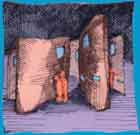
Interactionfields
Summoned Voices--by Iain Mott and Marc Raszewski--acts as a living memory of people and place. It consists of a series of door installations each with an intercom, sound system and a computer that is networked to a central file and database server. The design metaphor of the door presents a familiar scenario, that of announcing oneself at a doorway and waiting for a response from persons unknown. Signage instructs the public to speak, make sounds or sing into the intercom. Their voice is stored and interpreted, and results in local playback composed of the individual's voice with those that have gone before. Summoned Voices acts as an interpreter of sound, a message board and an imprint of a community - a place for expression, reflection and surprise.
Summoned Voices is one of the 22 projects catalogued by Mirjam Struppek for her thesis Interactionfield - Public Space in the Digital Age (2002): "The public space is a field, which is created and becomes alive through various forms of interaction.
Thus interactive art with its life proximity, communicative issues and reflection of the power of the modern technologies is well suited to be linked with the urban public space. This information platform presents detailed some selected interactive media projects, which went consciously into the urban public space. The analysis, categorization and questionaire with the producers of these 22 examples show how new media can be alternatively used, in order to contribute to the rediscovery and reactivation of the urban space and to lead to new interaction qualities. In the open expandable list further projects are collected. With the time an archive can develop, with examples, that show new ways in dealing with the public space. The links section presents various conferences, research projects, articles and specialized artists that related to this topic."
Posted by jo at 06:36 PM | Comments (0)
msdm
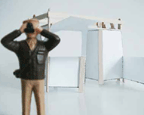
researching mobile strategies of display & mediation
msdm [mobile strategies of display & mediation] is an imaginary organisation founded in 1998 by paula roush to research mobile strategies of display & mediation. A hybrid of artistic, curatorial, experimental practice operating in the interstices of institutions and social systems, the organisation aims to propose participatory alliances for transversal, critical, cultural and aesthetic outputs. The collaborations have extended into the domains of open source software, publishing, para-architecture, public signage, radio streaming and mobile media platforms. They have been shown in galleries, museums, non governmental organisations and independent spaces, including Space Studios, Coleman Project Space, The South London Gallery, the Institute of International Visual Arts, the Bauhaus Foundation, Gesellschaft fur Aktuelle Kunst and the Living Art Museum.
Projects include:

geneticSilence: Public intervention and installation at the Living Art Museum in Reykjavik for the project Polyphony. A bus tour -the ’genetic noise tour’- was organised connecting the gallery with the street. The initial proposal was to have it to collect tourists in the city centre and take them on a tour of the high security genetic labs in the surroundings of Reykjavik. Because the right bus could not be found, the project took another shape and the tour was done in a small VW van, with the tech crew streaming the sound and images to the museum. The accompanying wall catalogue and public newspaper boards showed an archive of the links between art, genetics and architecture. The word ‘art’ -privatised by a genetics research company- was ‘corrected’ in the museum signage with the corresponding patent number.

bowville: bow wireless/ space studios/ london; locative media performance, 2004. Marion Manesta Forrester was electronically tagged. She had 3 days to earn her right to become a citizen of Bowville. People had to vote for her to stay or to go by phone, online or in person by visiting the Bowville Investigation Bureau. Download Bowville Booklet, 9 pages (pdf, 656k) or individual pages at higher resolution : page 1 | page 2 | page 3 | page 4 | page 5 | page 6 | page 7 | page 8 | page 9 |

SOS:OK: A work generated in response to Biscuit Town, the name given to the area surrounding Peek Freans biscuit factory. Biscuit Town was a marker in both organisational and representational forms of labour. It was the first mass producer of biscuits and commissioned the first documentary film shot on location (A Visit to Peek Freans, 1906, BFI Archive). At its core there is an artistic intervention that crosses a gallery installation with a public art intervention. The aim is to produce an emergency biscuit in response to the history of the site (Peek Freans was the first factory to manufacture an emergency biscuit ration to feed the starving population of Paris during the Franco-German war 1870-71) and the current international state of emergency. The launch and the time based performance at Coleman Project Space is inserted into a wider public campaign which includes billboards.
Posted by jo at 05:44 PM | Comments (0)
December 08, 2004
Simultaneous Translation - A Networked Collaboration
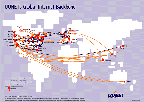
Distance and Time Through the Lens of Streaming Media
Friday December 17 & Sunday January 16, 2004; Madrid, Spain 20:00 (19:00 Greenwich Mean Time. 2PM Eastern Standard Time); Concert and live internet audio stream. Developed by John Roach with Miguel Ramos and Willy Whip Performers: Carlo Giordani, John Hudak, The Same Room Left, James Rouvelle, Mike Rosenthal, John Roach & Miguel Ramos.
Simultaneous Translation is an international networked performance that draws connections between language and the internet. Just as language has changed over time and as dialects have evolved as groups of people moved geographically from place to place, so in this project, live sound will be effected by time and distance. Audio created by the participants in Madrid, the US, Germany and Italy, will be broadcast live on the internet. [Related]
Posted by jo at 11:54 AM | Comments (0)
December 03, 2004
Grand Thieves Audio modologues
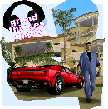
We're tired of stealing cars. So we're stealin' the soundtrack...
Grand Theft Auto: Vice City, an earth-shaking game of theft, prostitution, , and beautifully animated racist depictions of Cubans and Haitians. You are free-wheeling Tommy Vercetti, driving any car you can pop the lock on, taking s out to the lighthouse, enjoying all the pixilated pleasures the 80s can offer you. Bunk is making the game that much better because we're putting somebody in the car with you. We're carjacking the game with a mod of our own...This is only the beginning, the first in a series of monologues (or modologues) and performances we're testing out. Send us yours and we'll feature them on the page...(Modologue: Machinima-style dubbing that modifies game-play through an alternate narrative.)
"On Bunk, we've published the beta of the "Grand Thieves Audio" project. These MP3s constitute our attempt to carjack the audio on "GTA: Vice City." These audio files attempt to recontextualize the playing experience along subversive avenues. The idea is to create the illusion of new (subversive) nonplayer characters in the game through the audio."
These modologues combine the audio dubbing of machinima with the infiltration of game mods (since sticking them in your MP3 folder does not alter the code of the game). Unlike Machinima, which dub sound tracks over edited clips of game play and turn the player into a spectator, these monologues, or "modologues," let the user play in a different narrative context.
These files represent the first attempts to infiltrate the game. I hope other performers will record some and send them our way so we can build a library.
Current downloads include: Army Recruiter (since video games are now tools of recruitment), Mama Vercetti, The Driver's Ed Instructor, and Arnold Schwarzenegger (though this last is anachronistic and probably more suitable to "San Andreas")."
Posted by jo at 10:38 AM | Comments (0)
December 02, 2004
Energie_Passagen
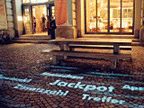
Public Voices Thrown Into the Flow
From Audiohyperspace: "Emergie_Passagen: Reading and (De)Scribing the City" - so the subtitle of this interactive audiovisual installation, which [could] be experienced until November 29th on Munich's Salvator Place. The installation understands a city's public speech - its inhabitants' chatting, the language of politics and media - as diverse streams of energy, from which an architecture is taking shape. The latter is made audible and visible by the art work. Every evening between 6 and 10 p.m. the square in Munich's city center is becoming a place, where a mediated, up-to-date intellectual-political milieu is emerging. The installation is mainly dealing with the interactive generation of semantic connections. A process, which can be initiated by every single passer-by and whose principles can be followed very well online.
Starting point for "Energie_Passagen" are texts taken from a mass medium, the daily newspaper. An automated computer process analyses the German newspaper "Süddeutsche Zeitung" and reduces it to catchwords. The terms which are filtered in this process are then projected as the "information flow" on the square "Salvatorplatz" in Munich.
As a visitor, you can choose between terms and "throw" your choice into the flow. Thus, movements of text are initiated and links between the terms become apparent. The resulting networks of terms create contextual links and new meanings which differ from the original linear texts. Computer voices immediately react to your "input" and accompany you in an echo of many voices.
In addition, a world map visualizes the path through the geographic landscape of news which the visitor takes based upon her/his choice. A developing linear illustration emphasizes the links between local location and global events.
The visible result of this interactive process is the "Living Newspaper". Its dynamically generated texts are projected on the square's "information cube". Newspaper texts are fragmented and transformed, creating new sense or non-sense. - A model maybe, how texts become catchwords, catchwords become arbitrary language patterns. It shows, how not content is the object of mental appropriation, but selections of terms and words are based on association and deliberate playfulness. By this, an intellectual is emerging, coined by the concert of terms and catchwords.
A livestream, accessible via the project's index page, makes the process audible via Internet.
Posted by jo at 10:21 AM | Comments (1)
November 22, 2004
SoundPryer

Truly Mobile Joint Music Listening
Mattias Östergren and his colleagues at the Interactive Institute in Stockholm are designing wireless software for mobile music "socials." But the dance parties they envision take place at 55 miles per hour. SoundPryer is a wireless peer-to-peer system for joint music listening in automobiles. Each driver becomes a mobile radio station, transmitting their digital music stream to other cars within Wi-Fi range.
SoundPryer has similarities to tUNA, a handheld ad-hoc networking radio device demonstrated last year by Media Lab Europe that enables users to tune in to other nearby digital music players, on a school bus for example. And while the PDA-based SoundPryer system can also be used in more stationary face-to-face situations, Östergren purposely kept his eyes on the road when designing the system. First of all, he writes in a scientific paper (PDF), it's a tougher challenge than more stationary systems. The potential duration of interactions between drivers may be extremely short as the cars zip down the highway or, in the event of gridlock, painfully long. The freeway is also a decidedly anonymous zone, perfect for studying how people might react to a new social technology.
From "Wireless Music's New Social Sound," by David Pescovitz, theFeature
Posted by jo at 05:30 PM | Comments (0)
November 07, 2004
DEAF04

participatory locative sound imaging hoedown
Dutch Electronic Art Festival (DEAF) is a biennial international festival for electronic art, presented by V2_, Institute for the Unstable Media, in Rotterdam, The Netherlands.
TRAMJAM V.03- ROTTERDAM RUSHHOUR by Mumbai Streaming Attack is a multi-track- multi-driver mix hub streaming jam session of Rotterdam city vibe, orchestrated in sync with the city's tramlines' routing schedule. Play along November 12 if you're in Rotterdam. Mumbai Streaming Attack is a networked performance study group currently based at SNM/HGKZ in Zurich.
Also at DEAF04 (and simultaneously in New York, Brisbane, Linz, and Singapore) is media artist Zhang Ga's public art project The Peoples' Portrait, where five photo-capturing kiosks, including the location in the Times Square Alliance Information Center at 150 7th Avenue in New York City, are set up globally to capture a diverse range of people in their unique environments. Every few seconds, a central server will retrieve the portraits and display them first in time stamped order, then randomly from the archive. [Related]
Originally posted by Eli Chapman on unmediated
Posted by jo at 06:55 PM | Comments (0)
October 30, 2004
Radioscape III
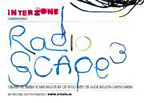
Mixing the City
In Radioscape III--a project by Edwin van der Heide--there are fifteen transmitters installed around and on the Leidseplein in Amsterdam, each broadcasting its own musical layer. Van der Heide designed a receiver that allows you to receive and mix the signals of two, three or more transmitters simultaneously. At a certain moment you receive one transmitter the strongest, the second a bit softer and the rest might be inaudible. By walking through the environment the balance between the transmitters is changing, new ones are fading in while others are fading out. Van der Heide: "The city centre forms a musical labyrinth with different layers of sound that, together, form a meta composition. By moving you mix the different layers which lead to new combinations and interferences."
Radioscape is open from Thursday the 28th of October till (including) Sunday the 7th of november. You can obtain a Radioscape receiver at the counter of De Balie. They can be fetched between 13:00 and 20:00
Radioscape is freely accessible for the audience. In order to borrow the receiver you have to deposit either 50 euro's or an id card. You have up to one hour to 'radioscape'.
Radioscape III is part of the Interzone series by De Balie, a series of artistic explorations crossing the borders between the existing artistic disciplines.
Posted by jo at 10:14 AM | Comments (0)
October 28, 2004
The Click Sneaks
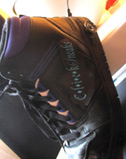
Tap for the Streets
New York designer and researcher Despina Papadopoulos, the founder of Studio 5050, had the idea for the Click Sneaks while walking down a cobblestone street, wearing sneakers next to a friend wearing stilettoes.
The artist recorded the "click" sound of high heels on a voice chip and had it activated on each step the revamped sneakers take. A speaker, an amplifier and a sensor acting as a "switch" on the sole of each foot, transform these seemingly normal sneakers into a sound performance.
Via Horizon Zero. originally from Popgadget: Personal Tech for Women, reBlogged by bev on btang reblog
Posted by jo at 09:07 AM | Comments (0)
October 27, 2004
The Wild is Calling

Call of the Wild
A project by Amos Latteier, Call of the Wild " is a series of audio tours of downtown Portland that are accessed by cell phone. The tours focus on plants and animals in downtown, contrasting them to their human cohabitants. Using natural history, philosophy, and humor the tours reveal urban biological systems that we see everyday but seldom notice.
Urban ecosystems demonstrate how technology and the urban environment mediate nature. Starlings, pigeons, and moss show us how to adapt, survive, and flourish in changing and artificial surroundings. Call of the Wild examines urban wildlife with an eye to the lessons it can teach us about our own technologically mediated lives.
Cell phones provide a unique, practical, and fun venue for conducting audio tours. Cell phones are already an integral part of the urban environment, and using them for audio tours transforms a device that normally removes people from the environment into one that help focus attention on it."
A wonderful concept, and an effective example of the possibilities for creative content delivered to the public via cellphones. (Posted by Michelle Kasprzak)
Posted by at 01:26 AM | Comments (1)
October 18, 2004
AudioHyperspace

audio »visions«
The Internet offers to the media as well as to the media artist a new electroacoustic space, abundant with audible live streams, audio on-demand, sound files and increasingly complex interactive audio art. These new possibilities may open up surprisingly new audio »visions« and provoke new strategies of perception. Audio on the Internet has made the boundaries between art, communication and play flexible. This offers a perspective on radio concepts and on radio art designs. AudioHyperspace guides you through the jungle of sound data and explores the development of sonic web art: every month it selects the most interesting audio websites and presents an annotated collection of links to audio and audio art on the web. Some examples of interviews:
Mobile Listening - Electrical Walks
Christina Kubisch in Conversation with Sabine Breitsameter
Sonic Art in Hertzian Space
Teri Rueb in Conversation with Sabine Breitsameter
Birdsong for the Mobile Age
Sadie Plant in Conversation with Sabine Breitsameter
Posted by jo at 12:56 PM
October 11, 2004
Auracle
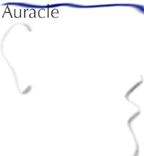
A Networked Instrument
Auracle, a voice-controlled, networked instrument on the Internet, was created over the past year at Akademie Schloss Solitude in Germany by the Auracle team (Max Neuhaus, Phil Burk, Sekhar Ramakrishnan, Kristjan Varnik, David Birchfield, and Jason Freeman--read PDF). The project is inspired by Max Neuhaus' interactive radio works from the 1960s and 1970s.
The site is now live, and you can try out Auracle at any time (you'll need a computer with a microphone). The official launch event is Friday, October 15th at Donnaueschinger Musiktage, a new music festival in Southern Germany. You are welcome to join in via the Internet by using Auracle at 2:30 p.m. Eastern Standard Time this Friday; see the web site for details.
Auracle is a networked sound instrument, controlled by the voice. It is played and heard over the Internet. To participate, simply launch Auracle in your web browser, join an ensemble, and create sounds with other participants in real time. While it takes years to learn how to control an instrument such as guitar or piano, Auracle requires no special training to play. It takes advantage of the sophisticated and flexible vocal control we all have from our ability to speak.
Your voice, however, is not the source of Auracle's sounds — it is merely a way of controlling those sounds. You play Auracle with other people anywhere in the world in groups of up to five players called Ensembles. All members of an ensemble are able to hear each other's gestures. Listen to the active ensembles in Auracle by clicking on their names. Stay with a group that you like, or create a new ensemble yourself and invite others to come and play.
Auracle is an instrument, not a piece; it is a system, not a musical composition. It has an internal structure, but it does not define or control the interaction of its participants. The architecture itself adapts over time in response to how it is used.
Posted by jo at 02:58 PM | Comments (0)
September 28, 2004
DENSITY Bus Tour

Sound in Motion
DENCITY is a live performance of electro-acoustic music on a nightly bus tour through New York's hidden landscapes. It is the contemporary urban equivalent of an explorer's notebook- a kind of Huck Finn on land. The producers of the DENCITY project are interested in exploring the relations between our point of departure, Williamsburg and some of the surrounding neighborhoods that have remained on the periphery of most experiences of NYC.
Rather than guide you through these spaces as a standard tour would, your "tour guides" will navigate you through these spaces with sound that is generated on the bus and sounds that have been collected "on site". Your audio "tour guides" will be Heimo Lattner and Erin McGonigle. Two artists who have significant experience performing in a variety of contexts/spaces. They, along with Rene Gabri, have also composed s route that they hope will stimulate new or interesting questions about these peripheral spaces. Read an interview.
DENCITY can be seen as a point of entry into these spaces. The artists involved create a "public" project and a "social" space that provokes the "tourist" or traveler to ask questions about the significance, history, and relationship of these spaces to the spaces they/we normally occupy and navigate through in the City. They also create a context in which the very act of "touring" is both an answer and a question. Sound, architecture, landscape and this tour bus are the forms that will open up these lanes of exploration.
Posted by jo at 03:06 AM | Comments (1)
September 24, 2004
unsorted, SonicActsX

Live Cinema
This year Sonic Acts presents a special Live Cinema programme, in association with www.live-cinema.org.
"Live Cinema is a form of performance art in which a human performer manipulates sound and image in synergy through movement, for an audience. In the rapidly advancing field of Live Cinema there are a number of distinct movements, e.g. abstract synthetic cinema, graphic cinema and camera-based cinema. We will present a number of renowned performers from these areas in the small hall in Paradiso in a three-evening packed programme. The performances will be interspersed with interviews with the artists, and with a film and video programme specially compiled for Live Cinema organised in association with Martijn van Boven. A Sonic Acts Live Cinema special will be broadcast on television during VPRO’s Nachtpodium on Wednesday 22 September."
From the introduction to unsorted, SonicActsX: "An important traditional paradigm is the familiar distinction between art disciplines such as visual arts, music, dance, theatre and literature. Usually, the different works of information art are forced to fit within this classical categorisation model. This, however, provides us with a misleading image of the nature of the new arts. For instance, imagine two works of computer art, generated using largely similar algorithms. The first work has an aural output, the second results in visual forms. Then the first one will be labelled as music while the second will be called visual art. This might seem to be an arbitrary problem, but it becomes relevant when we realise that the infrastructures of, in this case, the musical world and the visual arts world operate in rather separated areas (art education, exhibition and performance spaces, criticism and analysis). Many of the interesting issues of (and between) artworks like these are being missed because they are positioned outside the current categorisation models." Read more.
"So what exactly is Live Cinema? Live Cinema springs from new presentation forms, arising as a direct consequence of the advancing digitalisation of visual and sound technologies. The synthesis between sound and image is something a few artists already are putting to practice. While other artists hold ambitions in that direction, a platform/lab gathering know-how and the creative potential digital technologies are inscribed with, is still lacking. The technological backdrop of Live Cinema is one of daily technological innovation in the audio-visual field. The process of digitalisation is most developed in the realm of electronic (pop)culture, where equipment is compact, user-friendly and affordable. All these factors have led to a new artistic practice, where the usage of hardware, such as samplers and computers, have led to new artistic genres and ways to approach art.
It is for these new art forms that I seek fitting formats of presentation, whether theatrical, cinematic, interactive, or on DVD. Live Cinema is all about the "live" event, where artists collaborate and work towards a performance where different artistic disciplines are more than the sum of their parts. Fixed components are music (not soundtrack) and image projection (not traditional film). The eventual result is a unique art experience for the spectator. Each time, just as in theatre or at a concert, it is different." Hans Beekmans
Posted by jo at 03:25 PM | Comments (0)
September 20, 2004
Tactical Sound Garden [ TSG ] Toolkit

Shaping Space Through Sound
The TSG Toolkit is an open source platform for cultivating public "sound gardens" within urban environments. The TSG offers the urban dweller a participatory role in shaping the soundscape of contemporary public space: it enables anyone with a WiFi enabled mobile device (handheld, laptop, etc) to "plant" sounds within a networked, 3D audio environment. These "plantings" are mapped onto the coordinates of a physical location, overlaying a collaboratively constructed soundscape onto a specific urban space. Wearing headphones connected to a WiFi enabled device, participants drift though virtual sound gardens planted by others as they move through the city.
Posted by jo at 12:37 PM | Comments (0)
September 15, 2004
WACO Reenactment

Audio Warfare
Artist Rod Dickinson will reconstruct the FBI's covert psychological warfare assault on the infamous Branch Davidian religious community in Waco, Texas, at a secret, remote location close to London, on Thursday 16 September.
In 1993, the FBI laid siege to the religious community led by David Koresh for 51 days, intimidating them with a continuous barrage of white noise, rock music and an array of repetitive sounds played at 110 decibels. Using first-hand testimonies from interviews with survivors and academic researchers, Dickinson will recreate some of these original sounds, which included babies crying, circling helicopters, high pitched rabbit screams and dentist drills. The reconstructed audio will be broadcast at 100 decibels at a remote location surrounded by wire fencing and bright floodlights.
The reconstructed audio from the psychological warfare siege will also be streamed over the internet in real time for 24 hours a day for over a month at: www.wacoreenactment.org
For those of you in London:
the ICA Thurs 16 September, Meet in Foyer at 7pm for Coaches
**Please** book in advance!
£8, £7 Concs. £6 ICA Members
ICA, The Mall, London, SW1
Tickets & Information: 020 7930 3647 / www.ica.org.uk
The ICA Thurs 16 September, Meet in Foyer at 7pm for Coaches
**Please** book in advance!
http://www.wacoreenactment.org
Posted by jo at 08:15 AM | Comments (1)
September 05, 2004
Work by Usman Haque
Usman Haque designs interactive architecture systems and researches how people relate to each other and their spaces. "The domain of architecture has been transformed by developments in interaction research, wearable computing, mobile connectivity, people-centered design, contextual awareness, RFID systems and ubiquitous computing. These technologies alter our understanding of space and change the way we relate to each other. We no longer think of architecture as static and immutable; instead we see it as dynamic, responsive and conversant. Our projects explore some of this territory." Performative works include:
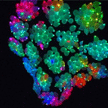 Sky Ear, 2004: This non-rigid "cloud", made up of several hundred glowing helium balloons will be embedded with mobile phones. As visitors to the event call into the cloud to listen to the distant electromagnetic sounds of the sky (including whistlers and spherics), their mobile phone calls will change the local hertzian topography; these disturbances in the electromagnetic fields inside the cloud will alter the glow intensity of that part of the balloon cloud. Quicktime video: 19 MB
Sky Ear, 2004: This non-rigid "cloud", made up of several hundred glowing helium balloons will be embedded with mobile phones. As visitors to the event call into the cloud to listen to the distant electromagnetic sounds of the sky (including whistlers and spherics), their mobile phone calls will change the local hertzian topography; these disturbances in the electromagnetic fields inside the cloud will alter the glow intensity of that part of the balloon cloud. Quicktime video: 19 MB
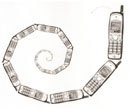 Japanese Whispers, Tokyo (2000): Similar to the children's game known as "Chinese Whispers" or "The Telephone Game," this project looks at how a message is changed by being passed from one mechanism to another--in this case the cellphone.
Japanese Whispers, Tokyo (2000): Similar to the children's game known as "Chinese Whispers" or "The Telephone Game," this project looks at how a message is changed by being passed from one mechanism to another--in this case the cellphone.
Cellphones are laid in a circle and calls are initiated from one phone to another in a variety of patterns with differing results. The sound degrades at each step as it is transformed from analog to digital and back again, emphasising the circular nature of communication. The iterative process of the feedback loop amplifies miscommunications inherent in the transmitting of information. Quicktime video: 9.2 MB
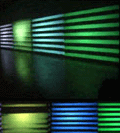 Infinitum Ad Nauseam, Tokyo (2000): The project is a video/audio performance installation which requires the explicit participation of the audience. Essentially, the system uses video and audio feedback to create sounds (from images and movements) and images (from sounds and movements). 4 video cameras, 4 video projectors, 2 video mixers and an audio mixer are used to initiate a massive feedback loop of video-video, video-audio, audio-video and audio to audio. This creates dynamic real-time images and sounds in "conversation" with the visitors or performers. There are no pre-recorded images and no computerised images used in the installation. Videos>>
Infinitum Ad Nauseam, Tokyo (2000): The project is a video/audio performance installation which requires the explicit participation of the audience. Essentially, the system uses video and audio feedback to create sounds (from images and movements) and images (from sounds and movements). 4 video cameras, 4 video projectors, 2 video mixers and an audio mixer are used to initiate a massive feedback loop of video-video, video-audio, audio-video and audio to audio. This creates dynamic real-time images and sounds in "conversation" with the visitors or performers. There are no pre-recorded images and no computerised images used in the installation. Videos>>
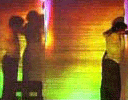 Changing Faces of Gesture, Tokyo (2000) with Charlotte Boye-Christensen (Choreographer/Dancer): The performance consists of one person and 2 to 4 large video projections. Using a simple video feedback system (where a video camera is pointed towards the screen upon which its image is being projected) coupled with an audio feedback system, complex images are created in realtime which are manipulated by the performer's movements. Images created resemble reflections in a puddle; these can be coloured using filters on both the cameras and the video-projectors. Furthermore each projector can be separately controlled to multiply the effects and simulate everything from a solitary dancing figure to a bustling crowd of people. Videos>>
Changing Faces of Gesture, Tokyo (2000) with Charlotte Boye-Christensen (Choreographer/Dancer): The performance consists of one person and 2 to 4 large video projections. Using a simple video feedback system (where a video camera is pointed towards the screen upon which its image is being projected) coupled with an audio feedback system, complex images are created in realtime which are manipulated by the performer's movements. Images created resemble reflections in a puddle; these can be coloured using filters on both the cameras and the video-projectors. Furthermore each projector can be separately controlled to multiply the effects and simulate everything from a solitary dancing figure to a bustling crowd of people. Videos>>
Posted by jo at 11:42 AM | Comments (2)
